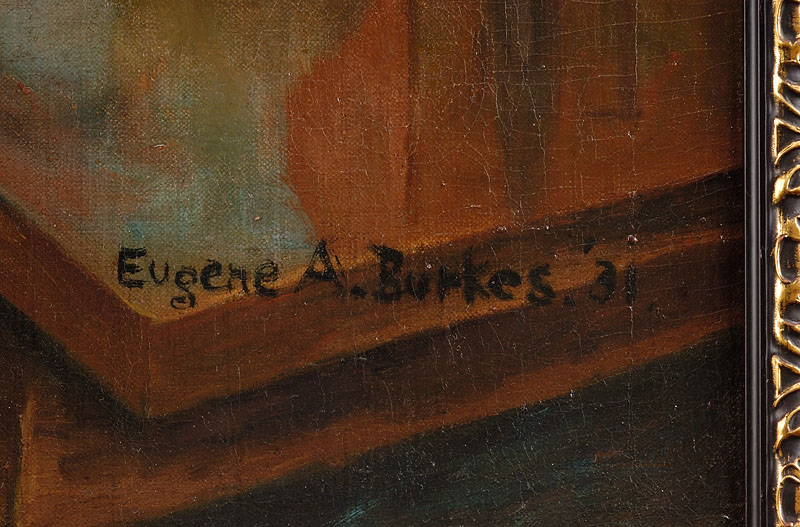John Abduljaami (1941-2017)
John Abduljaami, (born 1941, Shawnee, OK) renowned self-taught Oakland California wood sculptor; carves found wood, sculpting with axe, chisel, and saw. He polychromes these with house-paint. His sculptures are powerful and spirited works, mostly depicting animals and portraits, generally larger than life. He quit high school to join the navy; as a jet mechanic he was stationed in Japan for two years, and afterwards moved to San Francisco with his family. John served four years for robbery in the late 1960's, during which he changed his name and joined the nation of Islam. He is now non-denominational, and believes God will take of everything in the end. John received a certificate of valor for his heroic rescue of victims in the Loma Prieta earthquake, pulling survivors from the still crumbling Cypress freeway, using his ladders to reach them. He lost his house which was next to the collapsed structure, which had previously been documented and designated as an art historical site for preservation, by The Smithsonian Institution.
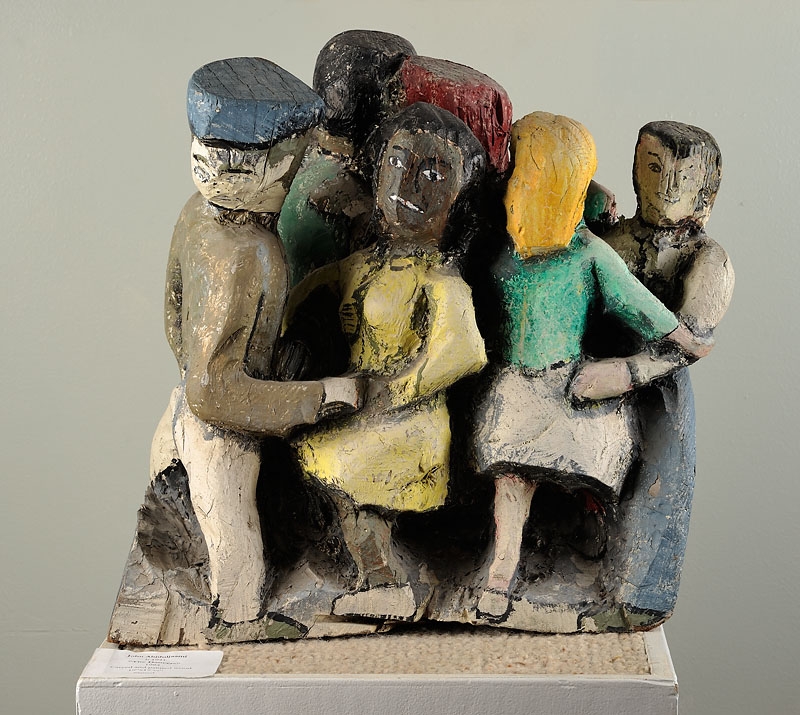
The Dancers
Oil on Canvas
19x22x15 inches
1984
Not signed
Photo credit: John Wilson White Studio
Charles Alston (1907–1977)
Charles Alston was born in Charlotte, North Carolina in 1907 to the Reverend Primus Priss Alston and Anna Elizabeth Miller Alston. Alston’s father, who nicknamed him Spinky, died when Alston was three. His mother subsequently married Harry Bearden, uncle of Romare Bearden. In 1915, the family moved to Harlem, but Alston continued to spend summers in North Carolina until he was fifteen. As a teenager, Alston painted and sculpted from life, mastering an academic-realist style, and in 1925, he was offered a scholarship to the Yale School of Fine Arts but decided to attend Columbia University instead. Alston received his BA with a concentration in fine arts in 1929 and continued on for a master’s degree at Columbia University Teachers College, where he became increasingly interested in African art and aesthetics. While in graduate school, Alston taught at the Utopia Children’s House, where he became mentor to a young Jacob Lawrence. He received his MA in 1931.
Having finished graduate school in the midst of the Great Depression, Alston remained in Harlem, one of the city’s hardest-hit communities. in 1934, he co-founded the Harlem Art Workshop. When the Workshop needed more space soon after, he found it at 306 West 141st Street. Aided by funding from the Works Progress Administration (WPA), “306” (as it was known) became a center for the most creative minds in Harlem. Regulars included Bearden, Lawrence, Augusta Savage, Richard Wright, Robert Blackburn, Countee Cullen, Ralph Ellison, and Gwendolyn Knight. In 1935, Alston became the first black supervisor in the Federal Art Project when he was assigned to direct the WPA’s Harlem Hospital murals. The paintings he designed—influenced by the work of Mexican muralists, jazz music, and the prevailing social realism of the 1930s—were approved by the Federal Art Project but rejected by the hospital’s administration for what they saw as an excess of subject matter relating to African Americans. After protests and extensive press coverage, the muralists were allowed to proceed. In 1936, two of the works were exhibited at the Museum of Modern Art, New York (MoMA). Two Rosenwald Fellowships at the end of the decade enabled Alston to travel throughout the south and to work with Hale Woodruff at Atlanta University. During World War II, Alston worked as an artist for the Office of War Information, served in the US Army, and was also a member of the board of directors for the National Mural Society. In 1944, he attended the Pratt Institute in Brooklyn for a year, and in 1949, he and Woodruff created murals for the Golden State Mutual Life Insurance building in Los Angeles. Entitled Negro in California History, the project comprised two works—Exploration and Colonization (1537-1850) by Alston and Settlement and Development (1850-1949) by Woodruff.
Alston began creating abstract paintings in the 1950s, but he never abandoned figural representation. Instead, he would shift between the two modes of painting, depending on what he believed was best for a given subject. In 1950, he entered one of his new, abstract works in the competitive exhibition American Painting Today at the Metropolitan Museum of Art. It won the purchase prize, and the museum acquired it. Many of Alston’s abstract works from this decade were inspired by African art, but unlike several of his his abstract expressionist contemporaries whose passion for American Indian, Pacific, and African art was connected to a modernist search for an imagined “primitive” impulse, Alston’s paintings were created through an intimate knowledge of African aesthetics. In Alston’s work, the African influence is part of a dialogue between past and present, one that finds modernism in tradition and vice-versa.
From his early days at the Utopia Children’s House in 1930 until his death in 1977, Alston remained an influential teacher and a committed activist. He taught at the Art Students League, MoMA, and City College. In 1963, he co-founded the Spiral Group (along with Romare Bearden, Norman Lewis, Hale Woodruff, and others), which sought to contribute to the Civil Rights movement through the visual arts in part by increasing gallery and museum representation for black artists. In 1967, President Lyndon Johnson appointed Alston as a trustee of the Kennedy Center, and in 1970, Alston became a member of the New York City Arts Commission. In 1975, Columbia University Teacher’s College, which once barred Alston from a required life-drawing course because the models were white, honored him with its first Distinguished Alumni Award.
Link to full bio: https://en.wikipedia.org/wiki/Charles_Alston

Harlem at Midnight
Oil on canvas
28x36 inches
1948
Signed and dated
Photo credit: John Wilson White Studio
Benny Andrews (1930-2006)
Benny Andrews was born into a family of ten on November 13, 1930 in small community called Plainview, Georgia. His mother Viola was very strict on her beliefs, and constantly promoted education, religion and most importantly, freedom of expression. George, Andrew’s father, also taught the same beliefs to his children. George, internationally known as the "Dot Man," was a self-taught artist, and produced many illustrative drawings that influenced Andrews.
Although the importance of education was stressed, Andrews’s number of absences accumulated due to the days he was needed on the field. Andrews graduated in 1948,from Burney Street High School in Madison, making him the first in his family to graduate high school. Andrews attended Fort Valley College on a two-year scholarship. There was only one art program offered at the institution, due to poor grades and the end of his scholarship Andrews left and joined the U.S. Air force in 1950.
Afterwards, the G.I. Bill of Rights afforded him training at the School of the Art Institute of Chicago where he received his BFA. His first New York solo show was in 1962. From 1968 to 1997, Andrews taught at Queens College, City University of New York and created a prison arts program that became a model for the nation.
After graduating from the Art Institute of Chicago he received the John Hay Whitney Fellowship for 1965-1966 and a CAPS award from the New York State Council on the arts in 1971[1] the same the same year he created the painting No More Games, a noted work which is about the plight of black artists and an iconic reflection of his emerging social justice work in the art world.[2]
In 1969, Andrews co-founded the Black Emergency Cultural Coalition (BECC) an organization that protested the 'Harlem on my Mind' exhibit at the Metropolitan Museum of Art in New York. They protested the fact that no African-Americans were involved in organizing the show and it contained no art only photo reproductions and copies of newspaper articles about Harlem.. The BECC then persuaded the Whitney museum to launch a similar exhibition of African American Artists, but later boycotted that show as well for similar reasons.[3] In 2006, he traveled to the Gulf Coast to work on an art project with children displaced by Hurricane Katrina.[4]
He was the director of visual arts for the National Endowment for the Arts from 1982 to 1984.
Benny Andrews was a figural painter in the expressionist style who painted a diverse range of themes of suffering and injustice, including The Holocaust, Native American forced migrations, and most recently, Hurricane Katrina. He began his own style of painting in the 1960s that developed parallel to the flourishing collage moment.[1] Other influences on his work include Surrealism and Southern folk art. His work hangs in the Metropolitan Museum of Art and the Art Institute of Chicago, the Studio Museum in Harlem, New York City, the High Museum of Art in Atlanta, Georgia, the Hirshhorn Museum in Washington, DC, and the Ogden Museum of Southern Art in New Orleans, Louisiana.
Reflecting his minimalist style, Andrews was known to say that he was not interested in how much he could paint but how little. He incorporated his sparing use of geometrical forms to convey broader messages about the people and places he depicted. Gabriel Tenabe describes his drawing as "delicate, subtle, and intimate... draw(ing) from his past private life in Georgia and his social life in New York." Christian imagery is juxtaposed with sensibilities of humanism calling out false religion, false democracy, sexism and militarism that have birthed a failed society.[1]
Link to full bio: https://en.wikipedia.org/wiki/Benny_Andrews
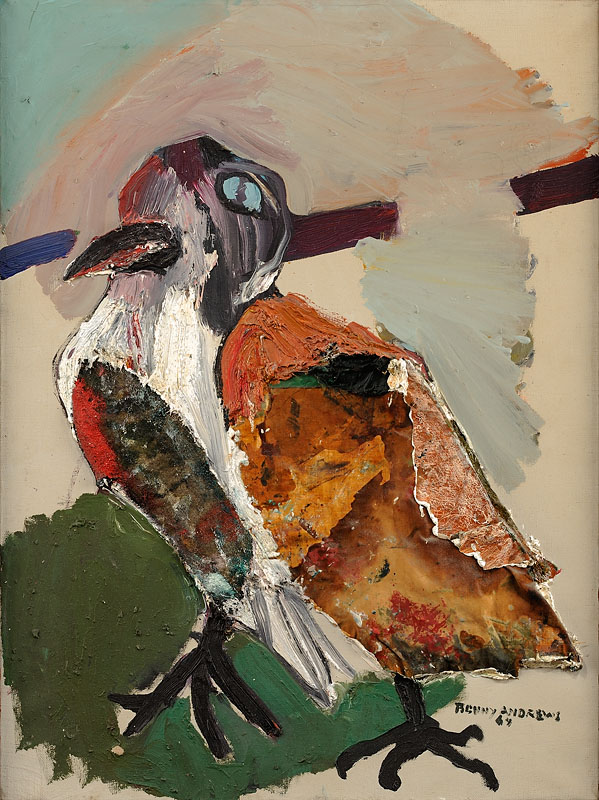
The Bird
Oil on board
26x19 inches
1964
Signed and dated
Photo credit: John Wilson White Studio

Black Power
Pencil on paper
18x12 inches
1971
Signed and dated
Photo credit: John Wilson White Studio
William Artis (1917-1977)
William Ellisworth Artis (February 2, 1914 – April 3, 1977)[1][2] was an African-American sculptor.
Born in Washington, North Carolina, he moved to New York as a teen in 1927. He was a pupil of Augusta Savage and exhibited with the Harmon Foundation. He studied at the Art Students League of New York and Syracuse University, where he worked with Ivan Meštrović. From 1941–45, he served in the U.S. Army during World War II.[1]
He later taught at Nebraska Teachers College in Kearney (today Chadron State College[3]), where from 1956 to 1966 he was Professor of Ceramics, and at Mankato State College as Professor of Art until 1975.
Link to bio: https://en.wikipedia.org/wiki/William_Artis
Classroom resources: http://americanart.si.edu/collections/search/artist/?id=27550

Head of a Boy
Terracotta
11 1/2 inches high
c. 1930
Not signed (plaque on bust says W. Artis)
Roland Ayers (1932-1914)
Roland Ayers was born on July 2, 1932, the only child of Alice and Lorenzo Ayers, and grew up in the Germantown district of Philadelphia. Ayers served in the US Army (stationed in Germany) before studying at the Philadelphia College of Art (currently University of the Arts). He graduated with a BFA in Art Education, 1954. He traveled Europe 1966-67, spending time in Amsterdam and Greece in particular. During this period, he drifted away from painting to focus on linear figurative drawings of a surreal nature. His return home inaugurated the artist’s most prolific and inspired period (1968-1975). Shortly before his second major trip abroad in 1971-72 to West Africa, Ayers began to focus on African themes, and African American figures populated his work almost exclusively.
In spite of Ayers’ travel and exploration of the world, he gravitated back to his beloved Germantown, a place he endowed with mythological qualities in his work and literature. His auto-biographical writing focuses on the importance of place during his childhood. Ayers’ journals meticulously document the ethnic and cultural make-up of Germantown, and tell a compelling story of class marginalization that brought together poor families despite racial differences. The distinctive look and design of Germantown inform Ayers’ visual vocabulary. It is a setting with distinctive Gothic Revival architecture and haunting natural beauty. These characteristics are translated and recur in the artist’s imagery.
During his childhood, one of the only books in the Ayers household was an illustrated Bible. The images within had a profound effect on the themes and subjects that would appear in his adult work. Figures in an Ayers’ drawing often seem trapped in a narrative of loss and redemption. Powerful women loom large in the drawings: they suggest the female role models his journals record in early life. The drawings can sometimes convey a strong sense of conflict, and at other times, harmony. Nature and architecture seem to have an antagonistic relationship that is, ironically, symbiotic.
A critical turning point in the artist’s career came in 1971 when he was included in the extremely controversial Whitney Museum show, Contemporary Black Artists in America. The exhibition gave Ayers an international audience and served as a calling card for introductions he would soon make in Europe.
Ayers is a particularly compelling figure in a period when black artists struggled with the idea of authenticity. A questioned often asked was “Is your work too black, or not black enough?” Abstractionists were considered by some peers to be sell-outs, frauds or worse. Figurative* work was accused of being either sentimental or politically radical depending on the critical source. Ayers made the choice early on to be a figurative artist, but considered his work devoid of political content.
Organizations such as Chicago’ s Afri-Cobrain the late 1960‘s asserted that the only true black art of any relevance must depict the black man and woman. A martial agenda of this nature trivialized the work in Ayers’ view. A devotee of Eastern religions, Ayers sought to explore deeper subjects of a less topical nature, thereby stepping outside political discourse. This is not to suggest that he was a man who rejected the physical world. He was profoundly interested in awareness of our environment, and how it relates to self-awareness. He often spoke of universality and timelessness as qualities to strive for in his art.
Roland Ayers: In His Own Words
…A person who refuses or is unable to give into the general consensus of his or her society may retain the capacity to see the world in a vastly different way. That person, in addition to having his or her personal construct of the world — and we all have that — usually has also retained the capacity to be more aware of that unique way of seeing as well as to use it.
… (my work) oftentimes reveals my fragmented consciousness: full of dream states and visions concerning one-world-togetherness: bits and pieces of primal religiosity that point to Europe as much as it does Africa; Afro-American cultural imagery, all presented up-front with an optimistic facade. However, there is another side: part of the dream as nightmare, simmering terrors underneath or just around the corner, ominous dark skies, lonely figures, fragmentary, confused thoughts on being black in the dark, cavernous belly of America, curses and cries in the night. I cannot always decide which story the finished product illuminates: an upbeat optimist or a frustrated, lonely pessimist. Or both at once: Gemini-like, each facing his own way, one foot planted in the West, the other in the East.
The diverse range of American scenes and people are depicted in various media using a figurative style that reflects the dignity of the lives of those he portrayed while serving his commitment to social change.
Link to bio: http://www.terenchin.com/2012/09/11/roland-ayers-b-1932/

Persistent Rumors
Mixed media, colored pencil. pen and ink with wash
20-29 inches
1963
Signed
Photo credit: John Wilson White Studio
Edward M. Bannister (1828-1901)
Edward Mitchell Bannister (ca. 1828 – January 9, 1901) was a Black Canadian-American Tonalist painter. Like other Tonalists, his style and predominantly pastoral subject matter were drawn from his admiration for Millet and the French Barbizon School.
Bannister was born in St. Andrews, New Brunswick and moved to New England in the late 1840s, where he remained for the rest of his life. While Bannister was well known in the artistic community of his adopted home of Providence, Rhode Island and admired within the wider East Coast art world (he won a bronze medal for his large oil "Under the Oaks" at the 1876 Philadelphia Centennial), he was largely forgotten for almost a century for a complexity of reasons, principally connected with racial prejudice.
With the ascendency of the Civil Rights Movement in the 1970s, his work was again celebrated and collected. In 1978, Rhode Island College dedicated its Art Gallery in Bannister's name with the exhibition: "Four From Providence ~ Alston, Bannister, Jennings & Prophet". This event was attended and commented on by numerous notable political figures of the time, and supported by the Rhode Island Committee for Humanities and the Rhode Island Historical Society. Events like this, across the entire cultural landscape, have ensured that his artwork and life will not be again forgotten.
Although primarily known for his idealised landscapes and seascapes, Bannister also executed portraits, biblical and mythological scenes, and genre scenes. An intellectual autodidact, his tastes in literature were typical of an educated Victorianpainter, including Spenser, Virgil, Ruskin and Tennyson, from whose works much of his iconography can be traced.
Bannister died of a heart attack in 1901 while attending a prayer meeting at his church, Elmwood Avenue Free Baptist Church. He is buried in the North Burial Ground in Providence.
Link to full bio:

Untitled (Landscape with Girl and Cows)
Oil on board
4 1/4x8 1/2 inches
1881
Signed and dated
Photo credit: John Wilson White Studio
Henry Bannarn (1910-1955)
Henry Wilmer "Mike" Bannarn (July 17, 1910 – September 20, 1965) was an African-American artist, best known for his work during the Harlem Renaissance period. He is known for his work in sculpture and as a character artist in the various paint mediums, Conté crayon, pastel, and free-form sketch.
He was born in Wetumka, Hughes County, Oklahoma, on July 17, 1910. When he was still a child, the family moved to Minneapolis, Minnesota, where he discovered his talent for art. He studied at the Minneapolis School of Arts (now known as the Minneapolis College of Art and Design).
He worked as a Works Progress Administration artist for the Federal Art Project and taught art at the Harlem Community Art Center in New York City, where he was a noted contemporary, friend and partner of another famous African-American artist, Charles Alston, with whom he ran the Alston-Bannarn Harlem Art Workshop in Harlem/NYC, NY. He was intimately associated with the "Harlem Renaissance" of the 1930s, being considered as one of the movement's preeminent contributors. [1] Although he is primarily known for his work in sculpture, he was equally skilled as a figurist and character artist in the various paint mediums, Conté crayon, pastel, free-form sketch, etc.
In 1941, he returned to Minnesota and entered a piece of sculpture in the Minnesota State Fair sculpture competition, where he was awarded the first prize. The much-honored artist had won a painting prize at the fair a decade earlier as well, representing one of the earliest achievements by an African-American artist in that state's history.
His works are represented in some of the most important collections in the US, such as the Metropolitan Museum of Art, the Smithsonian Institution, Dartmouth College's Hood Museum of Art, Pennsylvania Academy of the Fine Arts, Minnesota Historical Society, Minneapolis Institute of Art, Howard University Gallery of Art, and Clark Atlanta University Art Galleries. Very few Bannarn works exist in private hands.
At the April 26, 2007 sale conducted by Shannon's Fine Art Auctioneers, Milford, Connecticut, a Bannarn original oil titled "Modernist Exhibition" sold for $24,000 USD, achieving a price nearly ten times its pre-auction estimate of $2500–$3500.[1]At a May 18, 2008, auction conducted by the Rose Hill Auction Gallery, Englewood, New Jersey, an oil on board painting by Bannarn entitled "Seagulls" sold for $5,750, almost twenty times its pre-auction estimate of $200–$300.[2]
He died on September 20, 1965, in Brooklyn, New York.
Link to full bio: https://en.wikipedia.org/wiki/Henry_Bannarn

Country Road Missouri
Watercolor
9x12 inches
1941
Signed

Tourist Car Passenger
Mixed media on paper
9 1/4x7 1/2 inches
1940
Not signed
Photo credit: John Wilson White Studio
Ernie Barnes (1938-2009)
Ernest Eugene Barnes, Jr. (July 15, 1938 – April 27, 2009) was an African-American painter, well known for his unique style of elongation and movement. He was also a professional football player, actor and author.
Ernest Barnes, Jr. was born during Jim Crow in "the bottom" community of Durham, North Carolina, near the Hayti District of the city. His father, Ernest E. Barnes, Sr. (1899–1966) worked as a shipping clerk for Liggett Myers Tobacco Company in Durham. His mother, Fannie Mae Geer (1905–2004) oversaw the household staff for prominent Durham attorney and local Board of Education member Frank L. Fuller, Jr.
On days when Fannie allowed "June" (Barnes' nickname to family and childhood friends) to accompany her to the Fuller home, Barnes had the opportunity to peruse the art books and listen to classical music. The young Ernest was intrigued and captivated by the works of master artists. By the time Barnes entered the first grade, he was familiar with the works of such masters as Toulouse-Lautrec, Delacroix, Velasquez, Rubens, and Michelangelo. When he entered junior high, he could appreciate, as well as decode, many of the cherished masterpieces within the walls of mainstream museums – although it would be a half dozen more years before he was allowed entrance because of his race.[1]
A self-described chubby and unathletic child, Barnes was taunted and bullied by classmates. He continually sought refuge in his sketchbooks, hiding in the less-traveled parts of campus away from other students. One day in a quiet area, Ernest was found drawing in a notebook by the masonry teacher, Tommy Tucker, who was also the weightlifting coach and a former athlete. Tucker was intrigued with Barnes' drawings so he asked the aspiring artist about his grades and goals. Tucker shared his own experience of how bodybuilding improved his strength and outlook on life. That one encounter would begin Barnes' discipline and dedication that would permeate his life. In his senior year at Hillside High School, Barnes became the captain of the football team and state champion in the shot put.[2]
In 1956 Barnes graduated from Hillside High School with 26 athletic scholarship offers. Segregation prevented him from attending nearby Duke or the University of North Carolina. His mother promised him a car if he lived at home, so he chose North Carolina College at Durham (formerly North Carolina College for Negroes, now North Carolina Central University). He majored in art on a full athletic scholarship. His college track coach was the famed Dr. Leroy T. Walker.[1] Barnes played the football positions of tackle and center at NCC at Durham.
At age 18, on a college art class field trip to the newly desegregated North Carolina Museum of Art in Raleigh, Barnes inquired where he could find "paintings by Negro artists." The docent responded, "Your people don't express themselves that way."[3] Poetic justice prevailed 23 years later in 1979 when Barnes returned to the museum for a solo exhibition, hosted by North Carolina Governor James Hunt.
In 1990 Barnes was awarded an Honorary Doctorate of Fine Arts by North Carolina Central University.
In 1993 Barnes was selected to the "Black College Football 100th Year All-Time Team" by the Sheridan Broadcasting Network.[4]
In 1999 Barnes was bestowed "The University Award", the highest honor by The University of North Carolina Board of Governors.[5]
In December 1959 Barnes was drafted in the 10th round by the then-World Champion Baltimore Colts. He was originally selected in the 8th-round by the Washington Redskins,[6] who renounced the pick minutes after discovering he was a Negro.
Shortly after his 22nd birthday, while at the Colts training camp, Barnes was interviewed by N.P. Clark, sportswriter for the Baltimore News-Post newspaper. Until then Barnes was always known by his birth name, Ernest Barnes. But when Clark's article appeared on July 20, 1960, it referred to him as "Ernie Barnes," which changed his name and life forever.[7]
Barnes credits his college art instructor Ed Wilson for laying the foundation for his development as an artist. Wilson was a sculptor who instructed Barnes to paint from his own life experiences. "He made me conscious of the fact that the artist who is useful to America is one who studies his own life and records it through the medium of art, manners and customs of his own experiences."[18]
All his life, Barnes was ambivalent about his football experience. In interviews and in personal appearances, Barnes said he hated the violence and the physical torment of the sport. However, his years as an athlete gave him unique, in-depth observations. "(Wilson) told me to pay attention to what my body felt like in movement. Within that elongation, there's a feeling. And attitude and expression. I hate to think had I not played sports what my work would look like."[19]
Barnes' first painting sale was in 1959 for $90 to Boston Celtic Sam Jones for a painting called Slow Dance.[1] It was subsequently lost in a fire at Jones' home.
Critics have defined Barnes' work as neo-mannerist.[20] Based on his signature use of serpentine lines, elongation of the human figure, clarity of line, unusual spatial relationships, painted frames, and distinctive color palettes, art critic Frank Getlein credited Barnes as the founder of the neo-Mannerism movement - because of the similarity of technique and composition prevalent during the 16th century, as practiced by such masters as Michelangelo and Raphael.[21]
Numerous artists have been influenced by Barnes' art and unique style. Accordingly, several copyright infringement lawsuits have been settled and are currently pending.
Ernie Barnes framed his paintings with distressed wood in homage to his father. In his 1995 autobiography, artist Ernie Barnes wrote of his father: “... with so little education, he had worked so hard for us. His legacy to me was his effort, and that was plenty. He knew absolutely nothing about art.”[1]
Weeks before Ernie Barnes’ first solo art exhibition in 1966, he was at the family home in Durham, North Carolina as his father lay in the hospital after suffering a stroke. He noticed the usually well-maintained white picketed fence had gone untended since his father’s illness. Days later, Ernest E. Barnes, Sr. died. “I placed a painting against the fence and stood away and had a look. I was startled at the marriage between the old wood fence and the painting. It was perfect. In tribute, Daddy’s fence would hug all my paintings in a prestigious New York gallery. That would have made him smile.”[1]
A consistent and distinct feature in Barnes' work is the closed eyes of his subjects. "It was in 1971 when I conceived the idea of The Beauty of the Ghetto as an exhibition. And I exposed it to some people who were black to get a reaction. And from one (person) it was very negative. And when I began to express my points of view (to this) professional man, he resisted the notion. And as a result of his comments and his attitude I began to see, observe, how blind we are to one another's humanity. Blinded by a lot of things that have, perhaps, initiated feelings in that light. We don't see into the depths of our interconnection. The gifts, the strength and potential within other human beings. We stop at color quite often. So one of the things we have to be aware of is who we are in order to have the capacity to like others. But when you cannot visualize the offerings of another human being you're obviously not looking at the human being with open eyes."[22] "We look upon each other and decide immediately: This person is black, so he must be... This person lives in poverty, so he must be..."[13]
Barnes died on April 27, 2009 at Cedars Sinai Hospital in Los Angeles, California from blood cancer.[46] He was cremated and his ashes were scattered in Durham, North Carolina near the site of where his family home once stood, and at the beach in Carmel, California, one of his favorite cities.
Link to the full bio: https://en.wikipedia.org/wiki/Ernie_Barnes
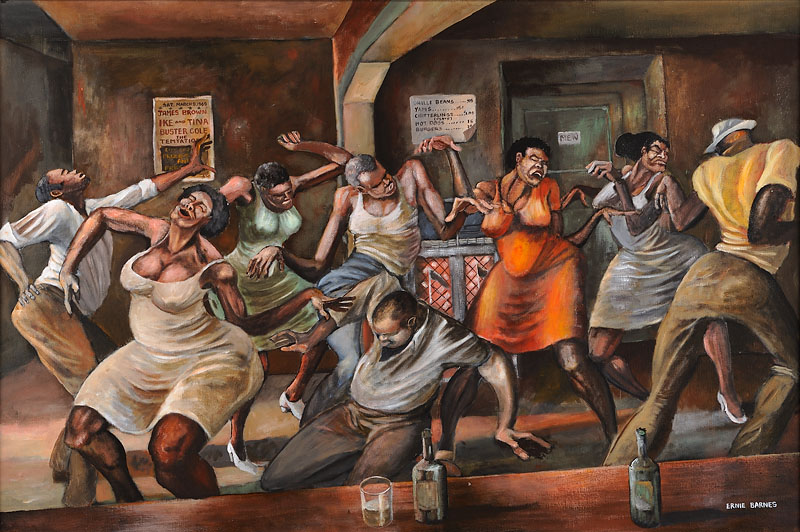
Dance Hall
Oil on board
24x36 inches
1969
Signed
Photo credit: John Wilson White Studio
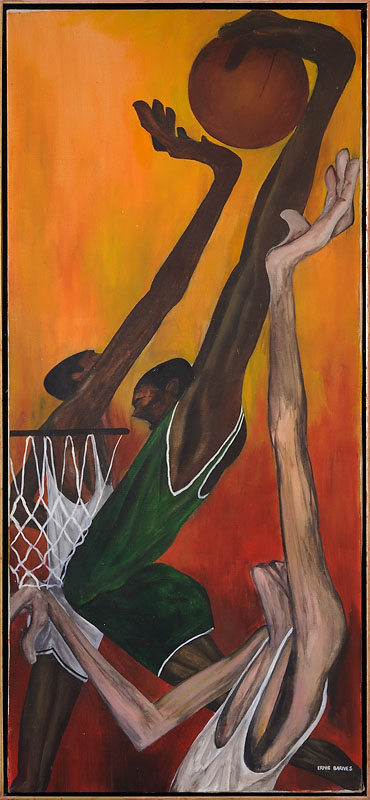
Slam Dunk
Acrylic on canvas
60x27 inches
c.1970
Signed
Photo credit: John Wilson White Studio
Romare Bearden (1911-1988)
Romare Bearden (September 2, 1911 – March 12, 1988) was an Afro-American artist. He worked with many types of media including cartoons, oils and collages. Born in Charlotte, North Carolina, educated in Pittsburgh, Pennsylvania, Bearden moved to New York City after high school and went on to graduate from NYU in 1935. He began his artistic career creating scenes of the American South. Later, he endeavored to express the humanity he felt was lacking in the world after his experience in the US Army during World War II on the European front. He later returned to Paris in 1950 and studied Art History and Philosophy at the Sorbonne in 1950.
Bearden's early work focused on unity and cooperation within the African-American community. After a period during the 1950s when he painted more abstractly, this theme reemerged in his collage works of the 1960s, when Bearden became a founding member of the Harlem-based art group known as The Spiral, formed to discuss the responsibility of the African-American artist in the struggle for civil rights.
Bearden was the author or coauthor of several books, and was a songwriter who co-wrote the jazz classic "Sea Breeze", which was recorded by Billy Eckstine, a former high school classmate at Peabody High School, and Dizzy Gillespie. His lifelong support of young, emerging artists led him and his wife to create the Bearden Foundation to support young or emerging artists and scholars. In 1987, Bearden was awarded the National Medal of Arts. His work in collage led the New York Times to describe Bearden as “the nation's foremost collagist”[1] in his 1988 obituary.
Bearden was born in Charlotte, North Carolina. Bearden's family moved him to New York City as a toddler, and their household soon became a meeting place for major figures of the Harlem Renaissance.[2] His mother, Bessye Bearden, played an active role with New York City's Board of Education, and also served as founder and president of the Colored Women's Democratic League. Bessye Bearden was also a New York correspondent for The Chicago Defender, an African-American newspaper.[3] Young Romare Bearden traveled frequently, to Pittsburgh, Pennsylvania and to visit family members in Charlotte, North Carolina.
In 1929 he graduated from Peabody High School in Pittsburgh, Pennsylvania. He then enrolled in Lincoln University, the nation's first Historically Black College and University founded in 1854. He later transferred to Boston University where he served as art director for Beanpot, Boston University's student humor magazine.[4]Bearden continued his studies at New York University (NYU), where he started to focus more on his art and less on athletics, and became a lead cartoonist and art editor for the Eucleian Society's (a secretive student society at NYU) monthly journal, The Medley.[5] Bearden studied art, education, science and mathematics, graduating with a degree in science and education in 1935. He continued his artistic study under German artist George Grosz at the Art Students League in 1936 and 1937. During this period he supported himself as a political cartoonist for African-American newspapers, including the Baltimore Afro-American, where he did a weekly cartoon from 1935 until 1937.[6]
During his career, Bearden received the following honorary doctorates: Pratt Institute, New York, 1973; Carnegie Mellon University, Pittsburgh, 1975; Maryland Institute of Art, Baltimore, 1976; North Carolina Central College University, Durham, 1977; and Davidson College, North Carolina, 1978.[7]
Bearden grew as an artist not by learning how to create new techniques and mediums, but by his life experiences. His early paintings were often of scenes in the American South, and his style was strongly influenced by the Mexican muralists, especially Diego Rivera and José Clemente Orozco. In 1935, Bearden became a case worker for the Harlem office of the New York City Department of Social Services.[3] Throughout his career as an artist, Bearden worked as a case worker off and on to supplement his income.[3] During World War II, Bearden joined the United States Army, serving from 1942 until 1945.[7] After serving in the army, Bearden joined the Samuel Kootz Gallery, an avant-garde commercial gallery in New York, where he produced paintings in "an expressionistic, linear, semi-abstract style."[3] He would return to Europe in 1950 to study philosophy with Gaston Bachelard and art history at the Sorbonne under the auspices of the GI Bill.[3][7] Bearden then traveled throughout Europe visiting Picasso and other artists.[3]
This completely changed his style of art as he started producing abstract representations of what he deemed as human; specifically scenes from the Passion of the Christ. He had evolved from what Edward Alden Jewell, a reviewer for the New York Times, called a "debilitating focus on Regionalist and ethnic concerns" to what became known as his stylistic approach which participated in the post-war aims of avant-garde American art.[8] His works were exhibited at the Samuel M. Kootz gallery until his work was deemed not abstract enough.
During his success in the gallery, however, he produced Golgotha, a painting from his series of the Passion of the Christ (see Figure 1). Golgotha is an abstract representation of the Crucifixion. The eye of the viewer is drawn to the middle of the image first, where Bearden has rendered Christ's body. The body parts are stylized into abstract geometric shapes, yet still too realistic to be concretely abstract; this work has a feel of early Cubism. The body is in a central position and yet darkly contrasting with the highlighted crowds. The crowds of people are on the left and right, and are encapsulated within large spheres of bright colors of purple and indigo. The background of the painting is depicted in lighter jewel tones dissected with linear black ink. Bearden used these colors and contrasts because of the abstract influence of the time, but also for their meanings.
Bearden intended to not focus on Christ but he wanted to emulate rather the emotions and actions of the crowds gathered around the Crucifixion. He worked hard to "depict myths in an attempt to convey universal human values and reactions".[9]According to Bearden himself, Christ's life, death, and resurrection are the greatest expressions of man's humanism, not because of Christ's actual existence but the idea of him that lived on through other men. This is why Bearden focuses on Christ's body first, to portray the idea of the myth, and then highlights the crowd, to show how the idea is passed on to men.
While it may seem as if Bearden was emphasizing the Biblical interpretations of Christ and the Crucifixion, he was actually focusing on the spiritual intent. He wanted to show ideas of humanism and thought that cannot be seen by the eye, but "must be digested by the mind".[10] This is in accordance with the time he produced this image, as other famous artists creating avant-garde abstract representations of historically significant events, such as Robert Motherwell’s commemoration of the Spanish Civil War, Jackson Pollock’s investigation of the Northwest Coast Indian art, Mark Rothko’s and Barnett Newman’s interpretations of Biblical stories, etc. Bearden used this form of art to depict humanity during a period of time when he didn’t see humanity in existence through the war.[5] However, Bearden stands out from these other artists as his works, including Golgotha, are a little too realistic for this time, and he was kicked out of Sam Kootz's gallery.
Bearden turned to music, co-writing the hit song Sea Breeze, which was recorded by Billy Eckstine and Dizzy Gillespie; it is still considered a jazz classic.[11] In 1954, at age 42, he married Nanette Bearden, a 27-year-old dancer who herself became an artist and critic. The couple eventually created the Bearden Foundation to assist young artists.
In the late 1950s, Bearden's work became more abstract, using layers of oil paint to produce muted, hidden effects. In 1956, Bearden began studying with a Chinese calligrapher, whom he credits with introducing him to new ideas about space and composition in painting. He also spent a lot of time studying famous European paintings he admired, particularly the work of the Dutch artists Johannes Vermeer, Pieter de Hooch, and Rembrandt. He began exhibiting again in 1960. About this time the couple established a second home in the Caribbean island of St. Maarten. In 1961, Bearden joined the Cordier and Ekstrom Gallery in New York City, which would represent him for the rest of his career.[3]
In the early 1960s in Harlem, Bearden was a founding member of the art group known as The Spiral formed "for the purpose of discussing the commitment of the Negro artist in the present struggle for civil liberties, and as a discussion group to consider common aesthetic problems."[12] The first meeting was held in Bearden's studio on July 5, 1963 and was attended by Bearden, Hale Woodruff, Charles Alston, Norman Lewis, and James Yeargans, Felrath Hines, Richard Mayhew, and William Pritchard. Woodruff was responsible for naming the group The Spiral suggesting the way in which the Archimedes spiral ascends upward as a symbol of progress. Over time the group expanded to include Merton Simpson, Emma Amos, Reginald Gammon Alvin Hollingsworth, Calvin Douglas, Perry Ferguson, William Majors and Earle Miller. Stylistically the group ranged from Abstract Expressionists to social protest painters.[12]
Bearden's collage work began in 1963 or 1964.[3] Bearden created his collages by first combining images cut from magazines and colored paper, which he would often with further alter with the use of sandpaper, bleach, graphite or paint.[3] Bearden would then enlarge these collages through the photostat process.[3] Building on the momentum from a successful exhibition of his photostat pieces at the Cordier and Ekstrom Gallery in 1964, Bearden was invited to do a solo exhibition at the Corcoran Gallery of Art in Washington, D.C., which increased his public profile.[3] Bearden's collage techniques changed over the years and in later pieces, he would use blown-up photostat photographic images, silk-screened, colored paper, and billboard pieces to create large collages on canvas and fiberboard.[3]
In 1971, the Museum of Modern Art held a retrospective exhibition of Bearden's work.[3]
His early works suggest the importance of African Americans' unity and cooperation. For instance, The Visitation implies the importance of collaboration of black communities by depicting intimacy between two black women who are holding hands together. However, not only because of the message conveyed, but also Bearden's vernacular realism represented in the work makes The Visitation noteworthy; Bearden describes two figures in The Visitation somewhat realistically but does not fully follow the pure realism by distorting and exaggerating some parts of their body, to “convey an experiential feeling or subjective disposition.”[13] Bearden’s quotation also demonstrates his supportive view to vernacular realism: “the Negro artists [...] must not be content with merely recording a scene as a machine. He must enter wholeheartedly into the situation he wishes to convey.”[13]
In 1942, Bearden produced Factory Workers (gouache on casein on brown kraft paper mounted on board), which was commissioned by Forbes magazine to accompany an article titled The Negro's War.[14] The article "examined the social and financial costs of racial discrimination during wartime and advocated for full integration of the American workplace."[15] Factory Workers and its companion piece Folk Musicians serve as prime examples of the influence that Mexican muralists played in Bearden's early work.[14][15]
Bearden had struggled with two artistic sides of himself: his background as “a student of literature and of artistic traditions, and being a black human being involves very real experiences, figurative and concrete”,[16] which was at combat with the mid-twentieth century “exploration of abstraction”.[17] His frustration with abstraction won over, as he himself described his paintings’ focus as coming to a plateau. Bearden then turned to a completely different medium at a very important time for the country.
During the 1960s civil rights movement, Bearden started to experiment again, this time with forms of collage.[18] After helping to found an artists group in support of civil rights, Bearden's work became more representational and more overtly socially conscious. He used clippings from magazines, which in and of itself was a new medium as glossy magazines were fairly new. He used these glossy scraps to incorporate modernity in his works, trying to show how not only were African-American rights moving forward, but so was his socially conscious art. In 1964, he held an exhibition he called Projections, where he introduced his new collage style. These works were very well received, and these are generally considered to be his best work.[19]
There have been numerous museum shows of Bearden's work since then, including a 1971 show at the Museum of Modern Artentitled Prevalence of Ritual, an exhibition of his highly prized prints entitled A Graphic Odyssey showing the work of the last fifteen years of his life,[20] and the 2005 National Gallery of Art retrospective entitled The Art of Romare Bearden. In 2011, Michael Rosenfeld Gallery exhibited its second show of the artist's work, Romare Bearden (1911–1988): Collage, A Centennial Celebration, an intimate grouping of 21 collages produced between 1964 and 1983.[21]
One of his most famous series, Prevalence of Ritual, concentrated mostly on southern African-American life. He used these collages to show his rejection of the Harmon Foundation’s (a New York City arts organization) emphasis on the idea that African Americans must reproduce their culture in their art.[22] Bearden found this to be a burden on African artists, because he saw this idea creating an emphasis on reproducing something that already exists in the world. He used this new series to speak out against this limitation on Black artists, and to emphasize modern art.
In this series, one of the pieces is entitled Baptism. Bearden was influenced by Francisco de Zurbarán, and based Baptism on Zurbarán’s painting The Virgin Protectress of the Carthusians. Bearden wanted to show how the water that is about to be poured on the subject being baptized is always moving, giving the whole collage a feel and sense of temporal flux. This is a direct connection with the fact that African Americans’ rights were always changing, and society itself was in a temporal flux at the time he created this image. Bearden wanted to show how nothing is fixed, and represented this idea throughout the image: not only is the subject being baptized about to have water poured from the top, but the subject is also about to be submerged in water. Every aspect of the collage is moving and will never be the same more than once, which was congruent with society at the time.
In "The Art of Romare Bearden", Ruth Fine describes his themes as "universal". "A well-read man whose friends were other artists, writers, poets and jazz musicians, Bearden mined their worlds as well as his own for topics to explore. He took his imagery from both the everyday rituals of African American rural life in the south and urban life in the north, melding those American experiences with his personal experiences and with the themes of classical literature, religion, myth, music and daily human ritual."
A mural by Romare Bearden in the Gateway Center subway station in Pittsburgh is worth $15 million, more than the cash-strapped transit agency expected, raising questions about how it should be cared for once it is removed before the station is demolished. "We did not expect it to be that much," Port Authority of Allegheny County spokeswoman Judi McNeil said. "We don't have the wherewithal to be a caretaker of such a valuable piece." It would cost the agency more than $100,000 a year to insure the 60-foot-by-13-foot tile mural, McNeil said. Bearden was paid $90,000 for the project, titled "Pittsburgh Recollections." It was installed in 1984.[23]
Before his death, Bearden claimed the collage fragments aided him in ushering the past into the present: "When I conjure these memories, they are of the present to me, because after all, the artist is a kind of enchanter in time."[24]
The Return of Odysseus, one of his collage works in the Art Institute of Chicago, exemplifies Bearden's effort to actively represent African-American rights in a form of collage. This collage describes one of the scenes in Homer's epic Odyssey, in which the hero Odysseus is returning home from his long journey. When one first sees the collage, the focal point that first captures one's eyes is the main figure, Odysseus, situated at the center of the work reaching his hand to his wife. However, if one takes a closer look at Odysseus, he or she would wonder why Odysseus and his wife, as well as all the other figures in the collage, are depicted as blacks, since according to the original story, Odysseus is a Greek king. This is one of the ways in which Bearden actively endeavours in his collage works to represent African-American rights; by replacing white characters with blacks, he attempts to defeat the rigidness of racial roles and stereotypes and open up the possibilities and potentials of blacks. In addition, the original epic depicts Odysseus as a strong character who has overcome numerous difficulties, and thus “Bearden may have seen Odysseus as a strong mental model for the African-American community, which had endured its own adversities and setbacks.”[25] Therefore, by describing Odysseus as black, Bearden maximizes the effect of potential black audiences empathizing to Odysseus.
One may wonder why Bearden chose the technique of collage to support the Civil Rights Movement and assert African-American rights. The reason he used this technique was because “he felt that art portraying the lives of African Americans did not give full value to the individual. [...] In doing so he was able to combine abstract art with real images so that people of different cultures could grasp the subject matter of the African American culture: The people. This is why his theme always exemplified people of color.”[26] In addition, collage’s technique of gathering several pieces together to create one assembled work “symbolizes the coming together of tradition and communities.”[25]
Romare Bearden died in New York City on March 12, 1988 due to complications from bone cancer. In their obituary for him, the New York Times called Bearden "one of America's pre-eminent artists" and "the nation's foremost collagist."[1]
Link to full bio: https://en.wikipedia.org/wiki/Romare_Bearden
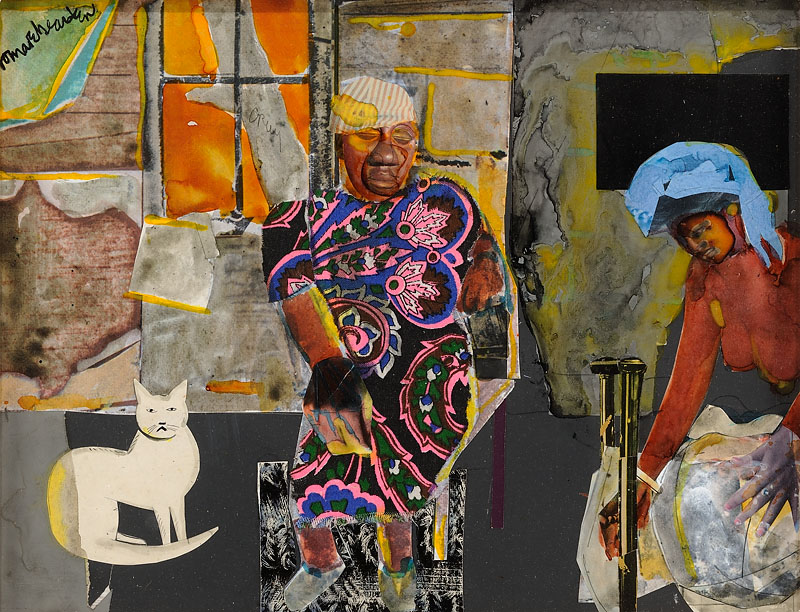
Mecklenburg Morning
Mixed media collage on board
14x18 inches
1978
Signed
Photo credit: John Wilson White Studio
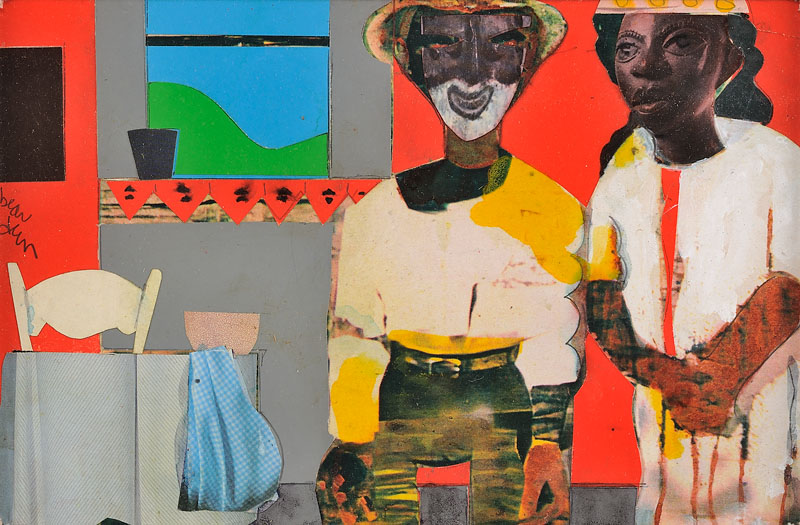
Old Couple
Mixed media collage on board
6x9 inches
1978
Signed
Photo credit: John Wilson White Studio
Cleveland Bellow (1951-2009)

Catch a Southern Beauty
Photo Transfer Collage
23 1/4x19 1/2 inches
Year unknown
Signed
Photo credit: John Wilson White Studio
Robert Blackburn (1920-2003)
Robert Hamilton Blackburn (December 10, 1920 – April 21, 2003) was an African-American artist, teacher and printmaker. Blackburn was born in Summit, New Jersey, to parents who were from Jamaica, and he grew up in Harlem, where his family moved when he was seven years old.[1] He attended P.S. 139 and then Frederick Douglass Junior High School (1932–36), where his English teacher was Countee Cullen. Starting in 1936, he went to DeWitt Clinton High School in the Bronx, where he worked on the literary magazine The Magpie as a writer and artist.[2] He graduated in 1940.
And at the age of 13, he began attending classes at the Harlem Arts Community Center operated by the Works Progress Administration's Federal Art Project, studying with Charles Alston and Augusta Savage, among others. He studied lithographyand other print-making techniques with Riva Helfond, and he frequented the Uptown Community Workshop, a gathering place for black artists and writers such as Langston Hughes, Richard Wright and Jacob Lawrence.
From early prints that portrayed cityscapes and figures on abstract backgrounds, he moved into more abstract work. From 1940 to 1943, a work scholarship to the Art Students League made it possible for him to study painting with Vaclav Vytlacil and lithography with Will Barnet, who became his friend. Between 1943 and 1948 he supported himself with difficulty with arts-related freelance work, producing maps, charts and other graphics.
In 1948, Barnet helped Blackburn establish the Printmaking Workshop, an 8,000-square-foot (740 m2) loft at 55 West 17th Street in New York City.[3] In the early 1950s, Blackburn and Barnet produced a suite of Barnet's lithographs that were a technical tour de force, requiring up to seventeen colors and multiple stones in the printing process.[4]
Blackburn was famously generous to other artists who came through the Workshop and fostered an atmosphere of openness to diversity. Among the many artists who have worked with Blackburn at the Printmaking Workshop are Leonora Carrington, Roy DeCarava, Faith Ringgold, Betye Saar, and Faith Wilding. His commitment to sponsoring minority and third-world students and developing community programs profoundly influenced younger printmakers, who seeded similar workshops around the United States and internationally.[5]
In 1956, when the Printmaking Workshop struggled financially and faced the threat of closing, fellow artist and printmaker Chaim Koppelman devised a means to save the studio by transforming it into a cooperative with annual dues. Blackburn credited Koppelman with saving the Workshop, and in 1992, Blackburn, Barnet, and Koppelman received a New York Artists Equity Award for their "dedicated service to the printmaking community."[6]
Blackburn's most productive period as an artist and printmaker was between the late 1950s and the early 1970s.[4] During this period he produced a large body of abstract still lifes and color compositions, mostly in lithography. In the 1970s, Blackburn turned away from lithography and began producing woodcuts, as well as some monotypes and intaglios.
Blackburn also served between 1957 and 1963 as the first master printer at Universal Limited Art Editions (ULAE), where he produced editions for such artists as Helen Frankenthaler, Grace Hartigan, Jasper Johns, Robert Rauschenberg, and Larry Rivers.[4]
In 1971, Blackburn put in place a board of trustees to help run the Printmaking Workshop and incorporated it as a nonprofit. Over the years the Workshop had accumulated a large collection of artists' prints, and efforts to find a permanent home for them were led by Deborah Cullen, who was the collection's curator between 1993 and 1996. By 1997, over 2,500 of these works had been deposited with the Library of Congress in Washington D.C. Smaller selections of the Workshop's prints have been placed with the Schomburg Center for Research in Black Culture and El Museo Del Barrio, New York.
Over the years, Blackburn taught at the New School for Social Research, Cooper Union, Pratt Institute, and Columbia University. In 1981, Blackburn was elected to the National Academy of Design as an Associate member, and he became a full member in 1994. In 1988, Blackburn and the nonprofit Printmaking Workshop received a Governor's Art Award from the New York State Council on the Arts. He also received a MacArthur fellowship in 1992. He died in New York City.[7]
On September 18, 2003, the Great Hall of Cooper Union in New York City held an exhibition and memorial to honor the work of this master printer, artist, and teacher. Blackburn's early work at DeWitt Clinton High School, where classmates included artists Burton Hasen, David Finn and Harold Altman, was exhibited at the Metropolitan Museum in 2009.
Link to full bio: https://en.wikipedia.org/wiki/Robert_Blackburn_(artist)
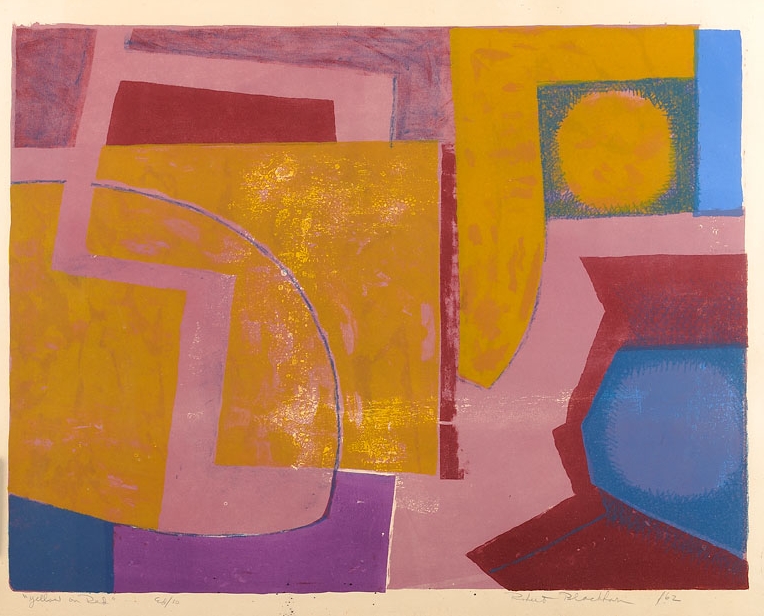
Yellow on Red
Serigraph
19x24 inches
1962
Signed and dated
Charles Bohannah (1910-1985)
Charles Bohannah, a native New Yorker, was born in Brooklyn, New York, in 1910. Bohannah began his career as an artist in high school, later enrolling in the Cooper Union School of Art. Around this time Bohannah also joined the prestigious Art Students League. While studying drawing and painting, he began doing "wash drawings" for use in magazines. Bohannah's first critical success was winning a scholarship, as a result of an exhibition at the Roak Art Museum in New York. This occurred around the beginning of World War II, when Charles chose to attend the Bell Signal Corp. School of radio to help the war effort.
During the war, Bohannah began to use photography as a means of self expression, working in both color and black and white. After the war, Bohannah resumed his artistic career working in oils, producing figurative, landscape as well as still life compositions. In 1976, Bohannah enjoyed success again with a solo exhibition at the Humanities Gallery of Long Island University as well as at the Community Gallery at the Brooklyn Museum. It was reported that in 1977, Nelson A. Rockefeller then Governor of New York State, began collecting Bohannahs work. For eleven years, Bohannah showed work at the Washington Square Outdoor Art Exhibition, winning several awards.
Charles Bohannah died in New York , 1985.
Link to full bio: http://www.askart.com/artist_bio/Charles_F_Bohannah/10005355/Charles_F_Bohannah.aspx
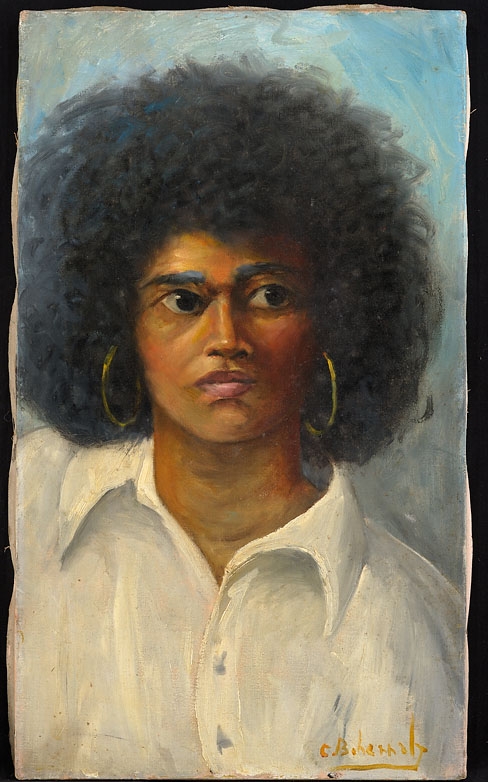
Portrait of a Woman
Oil on canvas
24x14 inches
c. 1950
Signed
Photo credit: John Wilson White Studio
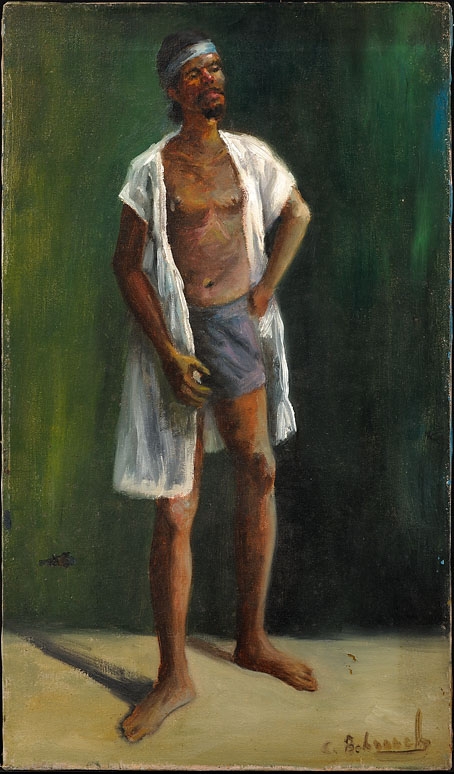
Standing Man
Oil on canvas
24x30 inches
c. 1950
Signed
Photo credit: John Wilson White Studio
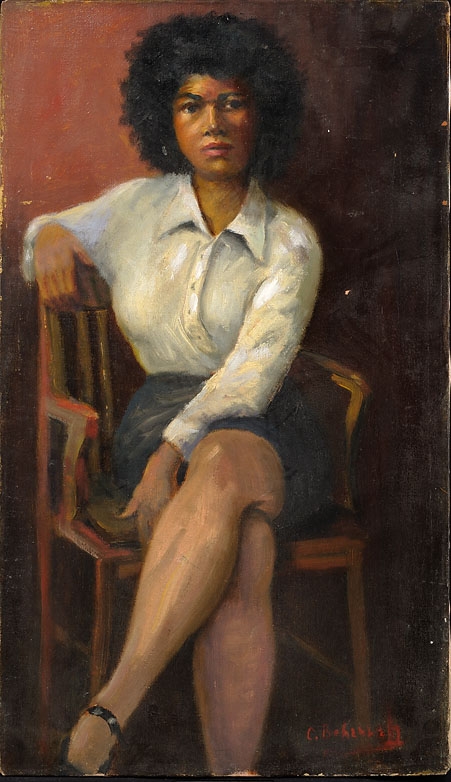
Seated Woman
Oil on canvas
24x14 inches
c. 1940
Signed and includes artist's business card on verso with Brooklyn, NY address
Photo credit: John Wilson White Studio
Benjamin Britt (b.1923)
Seven African Men Dancing
Oil on canvas
24x48
c. 1970
Photo credit: John Wilson White Studio
Benjamin Britt, born in Windfall, North Carolina, attended Philadelphia's Museum College of Art, Hussian School of Art, and the Arts Student League in New York City. Britt's oil paintings and charcoal drawings, seen in some of the finest private collections in the country, range from strong symbolic African themes, charcoal drawings depicting neighborhood children, beautifully rendered portraits, to his widely acclaimed surrealist works. These works form a sense of balance, and space and present strong symbolic messages that cannot be ignored.
Bio found on: http://www.askart.com/artist/Benjamin_Britt/10006654/Benjamin_Britt.aspx

Grafton Tyler Brown (1841-1918)
Cascade Cliffs, Columbia River
Oil on canvas
17x32 inches
1885
The Golden Gate
Oil on canvas
30x20 inches
1887
Gold Stream Falls
Oil on canvas
21x12 1/2 inches
1883
Grand Canyon and Falls
Oil on canvas
30x20 inches
1887
Photo credit: John Wilson White Studio
Grafton Tyler Brown was a cartographer, lithographer, and painter, widely considered the first professional African American artist in California. Born in Harrisburg, Pennsylvania in 1841, Brown learned lithography in Philadelphia and then became part of a cohort of African Americans who sought better economic and social opportunities in the West during the 1850s.
Brown migrated to San Francisco in the mid-1850s, where he found work as a lithographer at Kuchel and Dresel. He bought the business in 1867 and renamed it G.T. Brown & Co., continuing his efforts to document the gold rush towns and other Bay Area settlements. Brown sold his business in 1872 in order to devote his time to traveling and painting. In 1882, Brown settled in Victoria, British Columbia, where he opened a studio. During Brown’s travels throughout the Pacific Northwest, his work transformed from concentrating on commercial and expansionist aims, to focusing on the loss of open lands and the need to preserve them. In 1886 Brown moved to Portland, Oregon where he belonged to the Portland Art Society and opened up his own studio. He left Portland for Helena, Montana in 1890. While in Helena Brown continued his work and produced a map of Yellowstone Park which was published in 1894. By that point, however, Brown had moved on. He arrived in St. Paul, Minnesota in 1892 to begin work as a draughtsman for the U.S. Army Engineer's Office. Brown spent the rest of his life in the Minnesota city and died there in 1918.
Brown's maps, prints, and paintings are housed in archives in Victoria, British Columbia, San Francisco, California, and Tacoma, Washington. Major exhibitions of his work in Los Angeles, Oakland, and Tacoma demonstrate Brown's significant contribution to the settlement of the West as well as reflecting the beauty and diversity of the Pacific Northwest.
Bio found on: http://www.blackpast.org/aaw/brown-grafton-tyler-1841-1918




Selma Burke (1900-1995)
Female Torso
Bronze
6 1/4x3x2 inches
1995
Untitled (Facial Sculpture)
Bronze
12x 1/4x7x4 inches
unknown
Monument to the Tuskegee Airmen
Bronze
9 1/4x6x6 inches
1942
Female Bust
Plaster
17x10x10 inches
1973
Photo credit: John Wilson White Studio
Selma Hortense Burke (December 31, 1900 – August 29, 1995) was an American sculptor and a member of the Harlem Renaissance movement.[1] Burke is best known for her bas relief of President Franklin D. Roosevelt on the Recorder of Deeds Building in Washington, D.C.[2] Her other work includes a bust of Duke Ellington, portraits of Mary McLeod Bethune and Booker T. Washington, and sculptures of John Brown (abolitionist) and President Calvin Coolidge.[3]
Selma Burke was born on December 31, 1900, in Mooresville, North Carolina, the seventh of 10 children of Neal and Mary Jackson Burke. Her father was an AME Church Minister.[4] As a child, she attended a one-room segregated schoolhouse.[3] Her interest in sculpting was ignited by her maternal grandmother, who was a painter, although her mother thought she should pursue a more marketable vocation.[5] Her father nurtured her interest in art by bringing home souvenirs and art objects from his international travels in Europe, Africa, and the Caribbean as an ocean liner chef.[5]
Burke attended Winston-Salem State University, and then graduated in 1924 from the St. Agnes Training School for Nurses in Raleigh. She moved to Harlem, where she found work as a private nurse.[4][6]
Burke became involved in the Harlem Renaissance during her marriage to Claude McKay. She worked for the Works Progress Administration and the Harlem Artists Guild, teaching art to children in Harlem. One of her WPA works, a bust of Booker T. Washington, was given to Frederick Douglass High School in Manhattan in 1936.[7]
In the late 1930s she traveled to Europe on a Rosenwald fellowship to study sculpture in Vienna and in Paris with Aristide Maillol. In 1940 she founded the Selma Burke School of Sculpture in New York City, finishing a Master of Fine Arts degree at Columbia University the following year.[4][8]
She was committed to teaching art; after teaching at her in New York City school, Burke opened the Selma Burke Art Center in Pittsburgh, Pennsylvania.[2][9] Open from 1968 to 1981, the center "was an original art center that played an integral role in the Pittsburgh art community," offering courses ranging from studio workshops to puppetry classes.[10]
After competing in a national contest, Burke won a commission to sculpt a portrait honoring then-President Franklin D. Roosevelt and the Four Freedoms. She created the sculpture based on sketches made during a 45-minute sitting with Roosevelt at the White House.[2] The 3.5-by-2.5-foot plaque was completed in 1944 and unveiled in September 1945 at the Recorder of Deeds Building in Washington, D.C., where it still hangs today.[10] It is generally accepted, although not without some controversy, that John R. Sinnock's obverse design on the Roosevelt dime was based on Burke's plaque.[3][11][12][13] Sinnock later denied that Burke's portrait was an influence.[14][15]
Burke's other public sculpture pieces include a bust of Duke Ellington at the Performing Arts Center in Milwaukee, as well as works on display at the Hill House Center in Pittsburgh, the Schomburg Center for Research in Black Culture in New York City, Atlanta University, Spelman College, and the Smithsonian Museum of American Art.[16]
Selma Burke was among the artists featured at The National Urban League's inaugural exhibition at Gallery 62 in 1978.[17] Her last monumental work, created in 1980 when she was 80 years old, is a bronze statue of Martin Luther King, Jr. in Charlotte, N.C.[3]
Burke is an honorary member of Delta Sigma Theta sorority.[18] She received three honorary doctorate degrees during her lifetime, including one awarded by Livingston College in 1970.[3][4] Milton Shapp, then-governor of Pennsylvania, declared July 29, 1975, Selma Burke Day in recognition of the artist's contributions to art and education.[19]
Burke was a member of the first group of women – along with Louise Nevelson, Alice Neel, Georgia O'Keefe, and Isabel Bishop – to receive lifetime achievement awards from the Women's Caucus for Art, in 1979.[20] She received the award from President Jimmy Carter in a private ceremony in the Oval Office.[21][22] She received a Candace Award from the National Coalition of 100 Black Women in 1983.[23]
Burke retired to New Hope, Pennsylvania, and died in 1995, at the age of 94.[3]
Bio found on: https://en.wikipedia.org/wiki/Selma_Burke

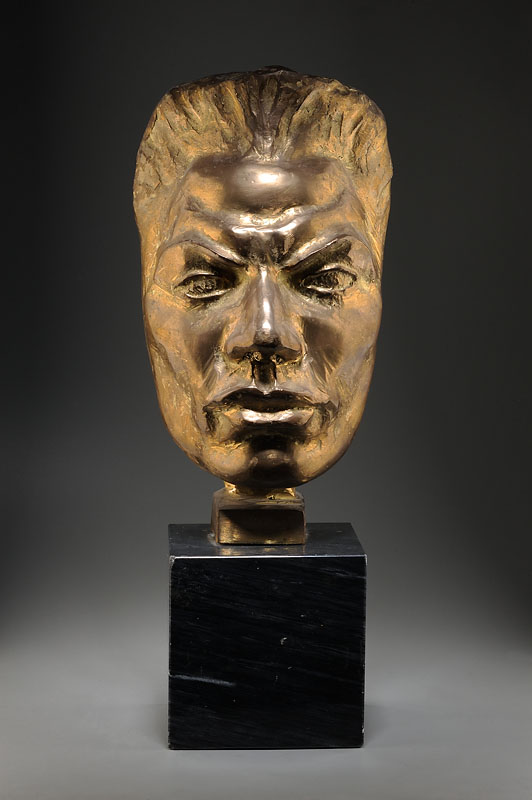


Eugene Alexander Burkes

Calvin Burnett (1921-2007)
Obituary By Bryan Marquard, Boston Globe Staff | October 12, 2007
As an artist and an art teacher, Calvin W. Burnett believed in knowing the rules and having the insight to break them.
"It's almost as though everything is right in relation to some aspect of whatever they happen to be doing," he said of his students in a 1980 oral history interview for the Smithsonian Institution Archives of American Art. "That is, any kind of line you draw with any kind of tool is right and good depending on what you are drawing. It's like there is no such thing as a good color or bad color or a correct color combination; it's only what you're trying to express with the color and what it's all about."
Proudly eclectic, he worked in many mediums, sometimes mixing one with another, and taught at the Massachusetts College of Art for 33 years. Mr. Burnett died Monday in Medway Country Manor nursing home of complications of Alzheimer's disease. He was 86 and had lived in Medway for three decades.
Writing in the Globe about a 1972 exhibition, Robert Taylor said Mr. Burnett's best pieces presented "the visual equivalent of the sound of Billie Holiday or Bessie Smith - a dark, indelible sorrow like the weight of an endless gloomy Sunday and, despite its burden, a determination to survive."
Mr. Burnett, Taylor wrote, "is essentially an artist who realizes his concepts graphically. Black, white, and half-tones of gray lend his angular, swooping line a mood of introversion."
From sketches to paintings, woodcuts, collage, and photographic elements, Mr. Burnett followed his muse down any avenue and felt a kinship with each approach. In the Smithsonian oral history, he called the interviewer's attention to the disparate styles of his work in the room where they were speaking.
"Just look around the room here," he said. "You see those things up there, and you see those things over there. They are very different from each other, and yet I love them both. I got a big bang out of doing them both, and I will continue to do them. And I do all sorts of things. And I think that's me. I wish what is me was something a good deal simpler, but it isn't, so tough!"
Torrey Burnett said her husband "enjoyed changing his style."
"The critics like to pigeonhole artists, but Cal wasn't like that," she said. "One year he'd be doing one thing,; the next he would be doing something completely different."
Born in Cambridge, Mr. Burnett was one of four children and grew up during the Great Depression, when his father's work as a physician afforded the family little financial security. Some patients were so poor that they paid his father with chickens or beans, Mr. Burnett told the Smithsonian.
"That may have been one of the reasons that none of the boys - there were three of us - wanted to follow in his footsteps," he said.
Not fond of school, Mr. Burnett found he had a talent for drawing, beginning with copying comic strips from the newspaper. He graduated from Cambridge High and Latin School and went to the Massachusetts College of Art.
"We were the young turks; we were the people who were going to change the world, you know," he said in the oral history of his college friends. "We wanted the latest in everything, you see. We'd read James Joyce, and . . . movies were important because they were the latest thing out. Jazz, of course, was terribly important at that time."
During World War II, Mr. Burnett worked in a shipyard because his eyesight was so poor he could not serve in the military. Afterward, he returned to the Massachusetts College of Art to train as a teacher. The experience, he said, illuminated the roles of the artist and the teacher and how one person sometimes could not be both.
"It's a big difference between the person who can teach somebody and the person who can do it," he said in the interview. "And there's no correlation between the person who can do it being able to tell another person how to do it. And I find that over at the art college all the time. There are people who are excellent artists who are terrible teachers."
Mr. Burnett also went to Boston University, where he received a master's in fine arts.
A few years after the war ended, he met Torrey Milligan. She had attended the Rhode Island School of Design and graduated from the Massachusetts College of Art. After knowing each other for about a decade, they married in 1960.
Romance between blacks and whites was less common at the time, "and they were predicting that because we were interracial our marriage wouldn't last," she said. "Well guess what? The others folded up, and ours lasted."
After they married, she became an art historian at the Massachusetts College of Art, where Mr. Burnett began teaching in the early 1950s.
Along with being part of private collections, Mr. Burnett's work is included in collections at the Smithsonian, and in Boston at the Museum of Fine Arts and the Museum of African-American History, his family said. He also published a book, "Objective Drawing Techniques."
As a teacher, Mr. Burnett emphasized to students what he called "discovery learning."
"You can't really make a mistake," he told the Smithsonian. "If an engineer builds a bridge wrong or a building, the thing will fall down and kill somebody. Or if a doctor makes a mistake, then of course somebody gets hurt. But if you are an artist trying to see how a pen works or a brush, all you have to do is take it and dip it in the ink and do it a million different ways."
In addition to his wife, Mr. Burnett leaves a daughter, Tobey of Leven, a village in East Yorkshire, England.
A memorial service will be held at 10 a.m. today in Community Church of West Medway.
© Copyright 2007 Globe Newspaper Company.
Click here to listen to a 5 minute oral interview with Mr. Burnett
https://www.aaa.si.edu/collections/interviews/oral-history-interview-calvin-burnett-11452
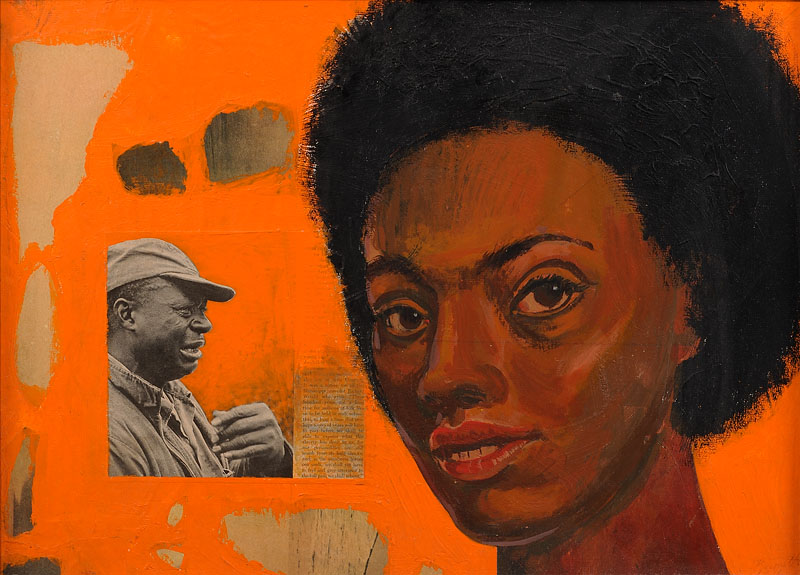
Father and Daughter
Collage and paint on board
14 1/4x20 inches
1976
Signed and dated
Photo credit: John Wilson White Studio
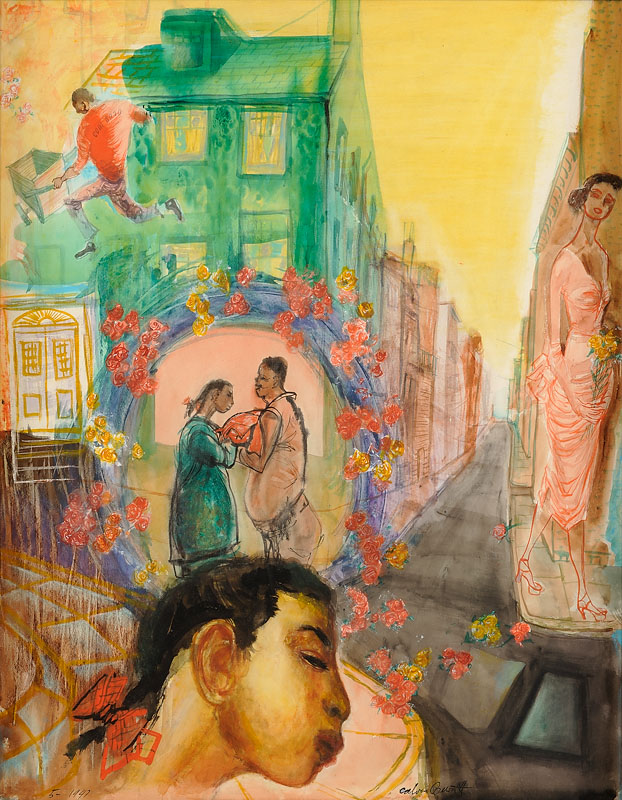
A Girls Dream
Oil on board
22x26 inches
1947
Signed
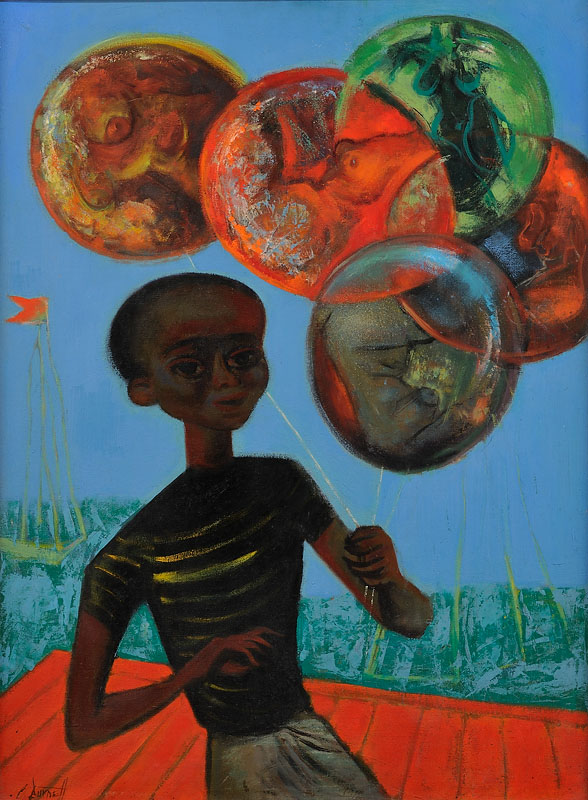
Boy with Balloons
Oil on canvas
30x22 inches
Year unknown
Signed
Photo credit: John Wilson White Studio
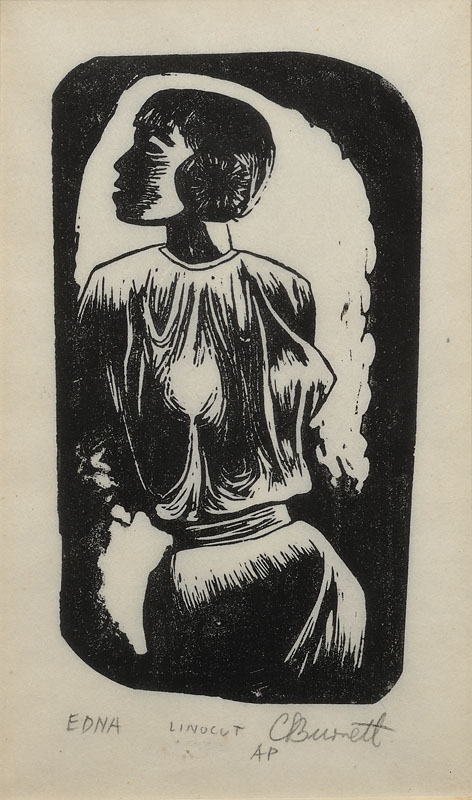
Edna
Linocut
6x3 1/3 inches
c. 1970
Signed
Photo credit: John Wilson White Studio
Margaret Burroughs (1917-2010)
Margaret Taylor-Burroughs (November 1, 1915[1][2] – November 21, 2010), was an American visual artist, writer, poet, educator, and arts organizer. She co-founded the Ebony Museum of Chicago, now the DuSable Museum of African American History. An active member of the African-American community, she also helped to establish the South Side Community Art Center, whose opening on May 1, 1941 [3] was dedicated by the First Lady of the United States Eleanor Roosevelt.[4]There at the age of 23 Burroughs served as the youngest member of its board of directors. She was a prolific writer, with her efforts directed toward the exploration of the Black experience and to children, especially to their appreciation of their cultural identity and to their introduction and growing awareness of art. She is also credited with the founding of Chicago's Lake Meadows Art Fair in the early 1950s.
Burroughs was born Victoria Margaret Taylor in St. Rose, Louisiana, where her father worked as a farmer and laborer at a railroad warehouse and her mother as a domestic. The family moved to Chicago in 1920 when she was five years old.[5]There she attended Englewood High School along with Gwendolyn Brooks, who in 1985-1986 served as Consultant in Poetry to the Library of Congress (now United States Poet Laureate). As classmates, the two joined the NAACP Youth Council. She earned teacher's certificates from Chicago Teachers College in 1937. She helped found the South Side Community Arts Center in 1939 to serve as a social center, gallery, and studio to showcase African American artists. In 1946, Taylor-Burroughs earned a Bachelor of Arts degree in art education from the School of the Art Institute of Chicagowhere she also earned her Master of Arts degree in art education, in 1948. Taylor-Burroughs married the artist Bernard Goss (1913–1966), in 1939, and they divorced in 1947. In 1949, she married Charles Gordon Burroughs and they remained married for 45 years until his death in 1994.[6]
Taylor-Burroughs taught at DuSable High School on Chicago's South side from 1946 to 1969, and from 1969 to 1979 was a professor of humanities at Kennedy-King College, a community college in Chicago. She also taught African American Art and Culture at Elmhurst College in 1968. She was named Chicago Park District Commissioner by Harold Washingtonin 1985, a position she held until 2010.
In one of Burroughs' linocuts, Birthday Party, both black and white children are seen celebrating. The black and white children are not isolated from each other; instead they are intermixed and mingling around the table together waiting for birthday cake.[12] An article published by The Art Institute of Chicago described Burroughs' Birthday Party and said, "Through her career, as both a visual artist and a writer, she has often chosen themes concerning family, community, and history. 'Art is communication,' she has said. 'I wish my art to speak not only for my people - but for all humanity.' This aim is achieved in Birthday Party, in which both black and white children dance, while mothers cut cake in a quintessential image of neighbors and family enjoying a special day together".[13] The painting puts in visual form Burroughs' philosophy that "the color of skin is a minor difference among men which has been stretched beyond its importance".[14]
Burroughs was impacted by Harriet Tubman, Gerard L. Lew, Sojourner Truth, Frederick Douglass, and W.E.B. Du Bois. In Eugene Feldman’s The Birth and Building of the DuSable Museum Feldman writes about the influence Du Bois had on Burroughs’ life. He believes that Burroughs greatly admired Du Bois and writes that she campaigned to bring him to Chicago to lecture to audiences. Feldman wrote, “If we read about ‘cannabalistic and primitive Africa,’…It is a deliberate effort to put down a whole people and Dr. Du Bois fought this… Dr. Burroughs saw Dr. Du Bois and what he stood for and how he suffered himself to attain exposure of his views. She identified entirely with this important effort." Therefore, Burroughs clearly believed in Dr. Du Bois and the power of his message.[15]
In many of Burroughs' pieces, she depicts people with half black and half white faces. In The Faces of My People Burroughs carved five people staring at the viewer. One of the women is all black, three of the people are half black and half white and one is mostly white. While Burroughs is attempting to blend together the black and white communities, she also shows the barriers that stop the communities from uniting. None of the people in The Faces of My People are looking at each other, and this implies a sense of disconnect among them.[12] On another level, The Faces of My People deals with diversity. An article from the Collector magazine website describes Burroughs' attempts to unify in the picture. The article says, "Burroughs sees her art as a catalyst for bringing people together. This tableau of diverse individuals illustrates her commitment to mutual respect and understanding".[16]
Burroughs once again depicts faces that are half black and half white in My People. Even though the title is similar to the previously referenced piece, the woodcut has some differences. In this scene, there are four different faces – each of which is half white and half black. The head on the far left is tilted to the side and close to the head next to it. It seems as both heads are coming out of the same body – taking the idea of split personalities to the extreme. The women are all very close together, suggesting that they relate to each other. In The Faces of My People there were others pictured with different skin tones, but in My People all of the people have the same half black and half white split. Therefore, My People focuses on a common conflict that all the women in the picture face.
Link to full bio: https://en.wikipedia.org/wiki/Margaret_Taylor-Burroughs
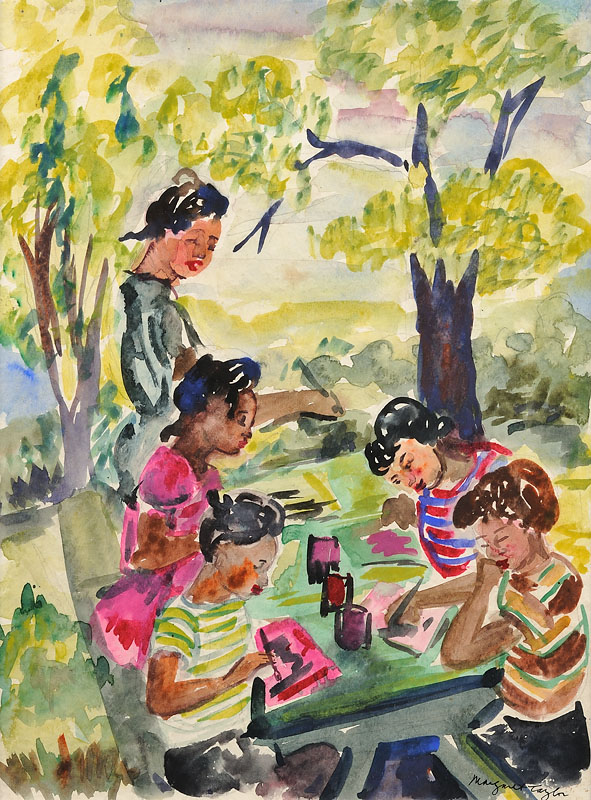

Manchild
Lithograph
14x9 3/4 inches
1986
Signed and dated
Numbered (8/18)
Photo credit: John Wilson White Studio

Mexican Girl
Linocut
18 3/4x 16 inches
1953
Signed and dated
Numbered (5/5)
Photo credit: John Wilson White Studio
Elizabeth Catlett (1915-2012)
Elizabeth Catlett (April 15, 1915[2] – April 2, 2012)[3] was an African-American graphic artist and sculptor best known for her depictions of the African-American experience in the 20th century, which often had the female experience as their focus. She was born and raised in Washington, D.C. to parents working in education, and was the grandchild of freed slaves. It was difficult for a black woman in this time to pursue a career as a working artist. Catlett devoted much of her career to teaching. However, a fellowship, awarded to her in 1946, allowed her to travel to Mexico City, where she would work with the Taller de Gráfica Popular for twenty years and become the head of the sculpture department for the Escuela Nacional de Artes Plásticas. In the 1950s, her main means of artistic expression shifted from print to sculpture, though she would never give up the former.
Her work is a mixture of abstract and figurative in the Modernist tradition, with influence from African and Mexican arttraditions. According to the artist, the main purpose of her work is to convey social messages rather than pure aesthetics. While not very well known to the general public, her work is heavily studied by art students looking to depict race, gender and class issues. During her lifetime, Catlett received many awards and recognitions including membership in the Salón de la Plástica Mexicana, the Art Institute of Chicago Legends and Legacy Award, honorary doctorates from Pace University and Carnegie Mellon and the International Sculpture Center's Lifetime Achievement Award in contemporary sculpture.
Catlett was born and raised in Washington, DC.[3][4] Both her mother and her father were the children of freed slaves, and her grandmother told her stories about the capture of blacks in Africa and the hardships of plantation life.[4][5][6] She was the youngest of three children. Both parents worked in education. Her mother was a truant officer and her father taught at Tuskegee University then at the DC public school system.[2] Her father died before she was born, leaving her mother to hold several jobs to support the household.[2][4][6]
Her interest in art began early. As a child she became fascinated by a wood carving of a bird that her father made. In high school, she studied art with a descendant of Frederick Douglass.[5]
Catlett did her undergraduate studies at Howard University, graduating cum laude, although it was not her first choice.[2][7] She was also admitted into the Carnegie Institute of Technology but was refused admission when the school discovered she was black.[2][4] But in 2007, as Cathy Shannon of E&S Gallery was giving a talk to a youth group at the August Wilson Center for African American Culture in Pittsburgh, PA, she recounted Catlett's tie to Pittsburgh because of this injustice. An administrator with Carnegie Mellon University was in the audience and heard the story for the first time. She immediately told the story to the school's president, Jared Leigh Cohon, who was unaware of it as well and deeply appalled that such a thing had happened. In 2008, President Cohon presented Catlett with an honorary Doctorate degree and a one-woman show of her art was presented by E&S Gallery at The Regina Gouger Miller Gallery on the campus of Carnegie Mellon University.[8]
While at Howard University, Catlett's professors included artist Lois Mailou Jones and philosopher Alain Locke.[4] She also came to know artists James Herring, James Wells, and future art historian James A. Porter.[5][9] Her tuition was paid for by her mother's savings and scholarships that the artist earned, and she graduated with honors in 1937.[1][2][3][4] At the time, the idea of a career as an artist for blacks was far-fetched, so she did her undergraduate studies with the aim of being a teacher.[5] After graduation, she moved to her mother's hometown of Durham, NC to teach high school.[2][5]
Because Catlett became interested in the work of landscape artist Grant Wood, she entered the graduate program of the University of Iowa.[2] There, she studied drawing and painting with Wood, as well as sculpture with Henry Stinson.[10] Wood advised her to depict images of what she knew best, so Catlett began sculpting images of African-American women and children.[2][11][12] However, despite being accepted to the school, she was not permitted to stay in the dormitories, requiring her to rent a room off-campus.[10] One of her roommates was future novelist and poet Margaret Walker.[5] Catlett graduated in 1940, one of three to earn the first masters in fine arts from the university, and the first African-American woman to receive the degree.[1][3][10] Later in life, Catlett donated money to the university to fund the Elizabeth Catlett Mora Scholarship Fund, which supports African-American and Latino students studying printmaking.[10]
After Iowa, Catlett moved to New Orleans to work at Dillard University, spending the summer breaks in Chicago. During her summers, she studied ceramics at the Art Institute of Chicago and lithography at the South Side Community Art Center.[3][9][12] In Chicago, she also met her first husband, artist Charles Wilbert White. The couple married in 1941.[3][5][13] In 1942, the couple moved to New York, where Catlett taught adult education classes at the George Washington Carver School in Harlem. She also studied lithography at the Art Students League of New York, and received private instruction from Russian sculptor Ossip Zadkine,[3][9][12] who urged her to add abstract elements to her figurative work.[2] During her time in New York, she met intellectuals and artists such as Gwendolyn Bennet, W.E.B. Dubois, Ralph Ellison, Langston Hughes, Jacob Lawrence, Aaron Douglass, and Paul Robeson.[5][6]
In 1946, Catlett received a Rosenwald Fund Fellowship to travel with her husband to Mexico and study.[4][12] She accepted the grant in part because at the time American art was trending toward the abstract while she was interested in art related to social themes.[5] Shortly after moving to Mexico that same year, Catlett divorced White.[13] In 1947, she entered the Taller de Gráfica Popular, a workshop dedicated to graphic promoting leftist social causes and education. There she met printmaker and muralist Francisco Mora, whom she married in the same year.[3][9][13] The couple had three children, all of whom developed careers in the arts: Francisco in jazz music, Juan in filmmaking and David in the visual arts. The last worked as his mother's assistant doing the heavy aspects of sculpting when she no longer could.[5][6][14]In 1948, she entered the Escuela Nacional de Pintura, Escultura y Grabado "La Esmeralda" to study wood sculpture with José L. Ruíz and ceramic sculpture with Francisco Zúñiga.[3][12] During this time in Mexico, she became more serious about her art and more dedicated to the work it demanded.[9] She also met Diego Rivera, Frida Kahlo and David Alfaro Siqueiros .[6]
She worked with the Taller until 1966. However, the fact that a number of its members were Communist Party members, along with her political activism, which had led to an arrest in 1949 while protesting during a railroad strike in Mexico City, Catlett came under surveillance by the US embassy.[2][13][15] Eventually, she was barred from entering the United States and declared an "undesirable alien," and was unable to return home to visit her ill mother before her parent died.[5] In 1962, she renounced her American citizenship and became a Mexican citizen.[2][3][9]
In 1971, after a letter-writing campaign to the State Department by colleagues and friends, she was issued a special permit to attend an exhibition of her work at the Studio Museum in Harlem.[2][5]
After retiring from her teaching position at the Escuela Nacional de Artes Plásticas, she moved to the city of Cuernavaca, Morelos in 1975.[2] In 1983, she and Mora bought an apartment in Battery Park City, NY, where from then until Mora's death in 2002, the couple spent part of the year.[2][6][13] Catlett regained her American citizenship in 2002.[6][9]
Catlett is recognized primarily for sculpting and print work.[3] Her sculptures are known for being provocative but her prints are more widely recognized, mostly because of her work with the Taller de Gráfica Popular.[3][5] Although she never left printmaking, starting in the 1950s, she shifted primarily to sculpture.[13] Her printwork was mostly woodcuts and linocuts with sculptures made of a variety of materials such as clay, cedar, mahogany, eucalyptus, marble, limestone, onyx, bronze, and Mexican stone (cantera).[2][9] She often recreated the same piece in several different media.[14] Sculptures range in size and scope from small wood figures inches high to others several feet tall to monumental works for public squares and gardens. This latter category includes a 10.5-foot sculpture of Louis Armstrong in New Orleans and a 7.5-foot work depicting Sojourner Truth in Sacramento.[5]
Much of her work is realistic and highly stylized two- or three-dimensional figures,[4] applying the Modernist principles (such as organic abstraction to create a simplified iconography to display human emotions) of Henry Moore, Constantin Brancusi and Ossip Zadkine to popular and easily recognized imagery. Other major influences include African and pre-Hispanic Mexican art traditions. Her works do not explore individual personalities – not even those of historical figures. Instead, they convey abstracted and generalized ideas and feelings.[13] Her imagery arises from a scrupulously honest dialogue with herself on her life and perceptions, and between herself and "the other", that is, contemporary society's beliefs and practices of racism, classism and sexism.[21] Many young artists study her work as a model for themes relating to gender, race and class, but she is relatively unknown to the general public.[15]
Her work revolved around themes such as social injustice, the human condition, historical figures, women and the relationship between mother and child.[13] These themes were specifically related to the African-American experience in the 20th century with some influence from Mexican reality.[1][2][9] This focus began while she was at the University of Iowa, where she was encouraged to depict what she knew best. Her thesis was the sculpture Mother and Child (1939), which won first prize at the American Negro Exposition in Chicago in 1940.[11][12]
Her subjects range from sensitive maternal images to confrontational symbols of Black Power, and portraits of Martin Luther King, Jr., Harriet Tubman and writer Phyllis Wheatley,[4][14] as she believed that art can play a role the construction of transnational and ethnic identity.[12] Her best-known works depict black women as strong and maternal.[2][15] The women are voluptuous, with broad hips and shoulders, in positions of power and confidence, often with torsos thrust forward to show attitude. Faces tend to be mask-like, generally upturned.[5] Mother and Child (1939) shows a young woman with very short hair and features similar to that of a Gabon mask. A late work Bather (2009) has a similar subject flexing her triceps.[2] Her linocut series The Black Woman Speaks, is among the first graphic series in Western art to depict the image of the American black woman as a heroic and complex human being.[21]:46 Her work was influenced by the Harlem Renaissance movement[3] and the Chicago Black Renaissance in the 1940s and reinforced in the 1960s and 1970s with the influence of the Black Power, Black Arts Movement and feminism.[12][13] With artists like Lois Jones, she helped to create what critic Freida High Tesfagiorgis called an "Afrofemcentrist" analytic.[18]
The Taller de Gráfica Popular pushed her to adapt her work to reach the broadest possible audience, which generally meant balancing abstraction with figurative images. She stated of her time at the TGP, "I learned how you use your art for the service of people, struggling people, to whom only realism is meaningful."[2]
Catlett also acknowledged her artistic contributions as influencing younger black women. She relayed that being a black woman sculptor "before was unthinkable ... There were very few black women sculptors – maybe five or six – and they all have very tough circumstances to overcome. You can be black, a woman, a sculptor, a print-maker, a teacher, a mother, a grandmother, and keep a house. It takes a lot of doing, but you can do it. All you have to do is decide to do it."[5]
No other field is closed to those who are not white and male as is the visual arts. After I decided to be an artist, the first thing I had to believe was that I, a black woman, could penetrate the art scene, and that, further, I could do so without sacrificing one iota of my blackness or my femaleness or my humanity.
— Elizabeth Catlett[22]
Catlett remained an active artist until her death.[4][15] The artist died peacefully in her sleep at her studio/home in Cuernavaca on April 2, 2012, at the age of 96.[1][3]She was survived by her three sons, ten grandchildren and six great-grandchildren.[2]
Abbreviated biography courtesy of Wikipidia. Link to full bio:
https://en.wikipedia.org/wiki/Elizabeth_Catlett
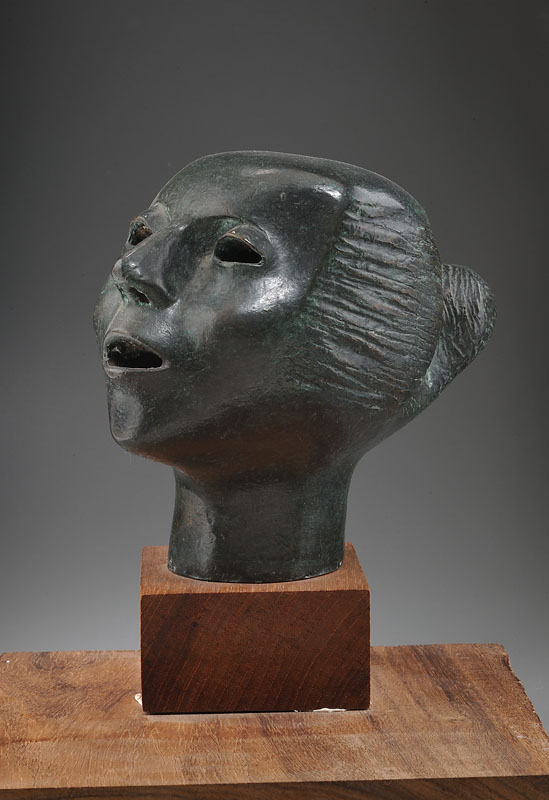
Cabeza Contando
Bronze
9 3/4 inches high
1960
Signed
Photo credit: John Wilson White Studio

El Baile
Color Lithograph
16x28 1/2 inches
1970
Signed and dated
Numbered 26/30
Photo credit: John Wilson White Studio
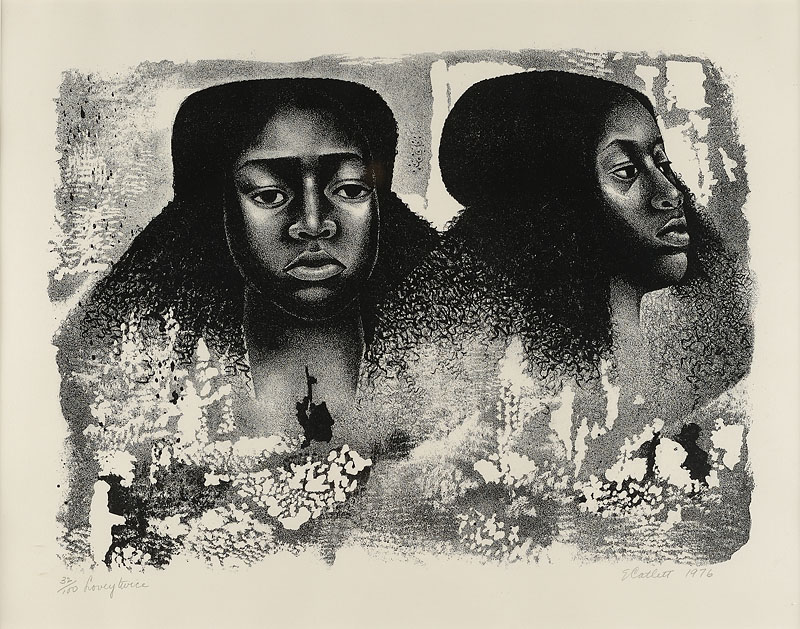
Lovey Twice
Lithograph
21x15 1/2 inches
1976
Signed and dated
Numbered 32/100
Photo credit: John Wilson White Studio

Harriet
Linocut
12 1/2x10 inches
1975
Signed and dated
Photo credit: John Wilson White Studio
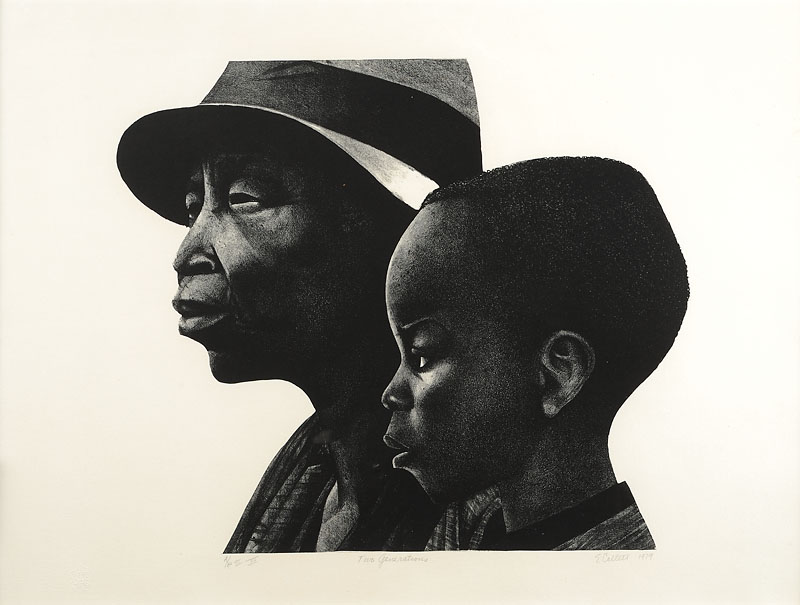
Two Generations
Lithograph
28x21 inches
1979
Signed and dated
(Annotation: Artist proof III/XX)
Photo credit: John Wilson White Studio
William Sylvester Carter (1919-1996)
Born in St. Louis, Missouri, William Carter (1909-1996) moved to Chicago in 1930, situating him in the midst of the Depression-era migration of African-Americans from the American South. He studied at the Art Institute of Chicago and the University of Illinois and was part of the WPA's Illinois Federal Art Project from 1937-39 and the Illinois Art and Craft Project (1943). He was an instructor at the South Side Community Arts Center of Chicago. While part of the WPA, he worked alongside Eldzier Cortor, Charles White, Earl Walker, Charles Davis and other noted African-American artists. Carter worked in several media including pastel, watercolor, ink, gouache and oils. Like many artists of the 1930s, he also painted in tempera, a medium that lent itself to the narrative scenes and murals of the 1930s and which was then enjoying a revival. Carter worked in both representational and abstract styles. Among his most successful paintings are his still lifes and nudes which, while representational, are nevertheless influenced by his interest in abstraction. Executed in a loose style with bright colors, they playfully interpret shapes and perspective.
Carter exhibited in the Chicago area at the Art League, Hull House, South Side Community Art Center, the Art Institute, and the American Negro Exposition of 1940. He also exhibited at Atlanta University, Howard University, the Library of Congress, Smith College, City Art Museum of St. Louis, and the Boston Institute of Modern Art. His works are in collections at the Art Institute of Chicago, the DuSable Museum of African-American Art, and the South Side Community Art Center.
Biography courtesy of Roger King Gallery of Fine Art, www.antiquesandfineart.com/rking

Still Life with Purple Plum
Oil on canvas
18x32 inches
Year unknown
Signed
Photo credit: John Wilson White Studio

Seascape
Oil on canvas
11 1/4x 15 1/2 inches
1952
Not signed
Photo credit: John Wilson White Studio

Missouri Snow
Pastel
18x32 inche
Year unknown
Signed
Photo credit: John Wilson White Studio

Fear
Pastel
13x10 3/4 inches
c. 1950
Signed
Photo credit: John Wilson White Studio

Sorrow all the Cats Are In
Mixed media on panel
18x24 inches
1978
Signed and dated
Photo credit: John Wilson White Studio
Claude Clark Sr. (1915-2001)
Claude Clark (November 11, 1915 - April 21, 2001) was an African American painter, printmaker and art educator. Clark’s subject matter was the diaspora of African American culture, including dance scenes, street urchins, marine life, landscapes, and religious and political satire images executed primarily with a palette knife.
Claude Clark was born on a tenant farm in Rockingham, Georgia November 11, 1915. In early August 1923, Clark’s parents left the south for a better life in Philadelphia, Pennsylvania during the Great Migration. Clark attended Roxborough High School[1] where he wrote poetry but also discovered a talent for painting. His Sunday School teacher encouraged him to exhibit in Sunday school class and at church.[2]
Clark studied at the Philadelphia Museum of Art (1935-1939) following high school graduation. He applied to and was eventually accepted to the Barnes Foundation in 1939.[1]
In 1941, Claude met the daughter of an African Methodist Episcopal Church minister, Effie May Lockhart from California. They married in June 1943[1] and formed a dynamic “power” partnership in art, education and philosophy.[3] He continued his paint studies at The Barnes Foundation while teaching art in the Philadelphia Public School system during the early years of their marriage. The couple moved to Alabama and finally California while continuing their careers.
During the Great Depression Clark contacted the Artists Union for work through the Works Progress Administration (WPA). He worked with the WPA from 1939 – 1942. Clark joined the graphics art shop where he worked with Raymond Seth and Dox Thrash.[1]
Clark was the subject of many articles and publications. He also was the author of A Black Art Perspective, a Black Teachers Guide to a Black Visual Arts Curriculum, Merritt Press 1970. As a member of the Black West Coast Arts Movement he co-developed the first African American Studies curriculum. He also mentored and supported many young emerging scholars and artists.[4]
Claude Clark attended high school in Philadelphia, PA, graduating from Roxborough High School. From 1935 - 1939, Clark studied at the Philadelphia Museum School of Industrial Art (later the Philadelphia Museum of Art on full scholarship. While studying there, he came across the work of Van Gogh. Van Gogh's style and method formed the basis of Clark's approach to drawing and painting, with thick creamy texture and loosely applied paint using a palette knife.[1]
In 1939 Clark applied to the Barnes Foundation in Merion, Pennsylvania and was accepted. Clark studied at Barnes from 1939 – 1944. The Albert Barnes collection consisted of an array of works that included African art, European Impressionism and American art. He was able to investigate the hundreds of original “old masters” and modernist works and to study first hand one of the first important collections of African art in America.
While studying at Barnes in 1939, Clark found a job through the Federal Arts Project of the Works Progress Administration(WPA). He also performed independent research from 1944 – 1958. Clark moved his family to Talladega, Alabama and subsequently Sacramento, California. He received a BA from Sacramento State University in 1958 and a Master of Arts from the University of California, Berkeley in 1962.[1]
Clark matured in art by recognizing his opportunity to develop without being constrained by the racism, poverty and inherent inequality of circumstance prejudice and labels bring. His work exhibited social realism, modern and abstract styles. When Clark could not afford paint, he salvaged throw away paint cans from trash bins in the back of art schools and mixed his own. Unable to afford to buy paint brushes and chemicals to clean them, he mastered use of the palette knife.[citation needed]
Clark painted and exhibited from a very early age and sold his first works in his early twenties. Collectors continue to seek Clark’s works 70 years later. Clark worked at various jobs throughout the late 30’s and mid 40’s before accepting a position as an art instructor with Philadelphia Public school in 1945 – 1948.
Clark became interested in working for a Black college as his interest in African and African American history developed further. He accepted a position at Talladega College, Talladega, Alabama as an Associate Professor of Art (1948 – 1955).[5] Clark painted, taught, exhibited and researched his interest further while supporting his family consisting of a wife Diama (Effie), son Claude Lockhart Clark and daughter Alice.
In 1955, while teaching at Talladega, Clark began feeling the financial pressures and made the decision to move his family to his wife’s native state of California to seek greater opportunity. Clark enrolled in Sacramento State University and taught art classes to other undergraduate students while simultaneously obtaining his Bachelor of Arts degree. Following graduation in 1958, Clark accepted an art instruction position with Alameda County, California (1958 – 1967) and eventually secured a faculty position within the University of California system as an art instructor (Merritt College, 1968 – 1981).[1]
Clark helped curate the first national African American exhibition at the Oakland Museum in 1967.[2]
Clark continued to paint, research and exhibit throughout this period. Clark worked from his studio in Oakland, California following his Merritt College retirement from 1981 – 1998. He has exhibited in the United States, Africa, Caribbean, Europe and South America.
He died in Oakland, California on April 21, 2001 after a long illness.[2]
Abbreviated bio courtesy of Wikipidia. Link to full bio: https://en.wikipedia.org/wiki/Claude_Clark

Irene Clark (1927-1984)
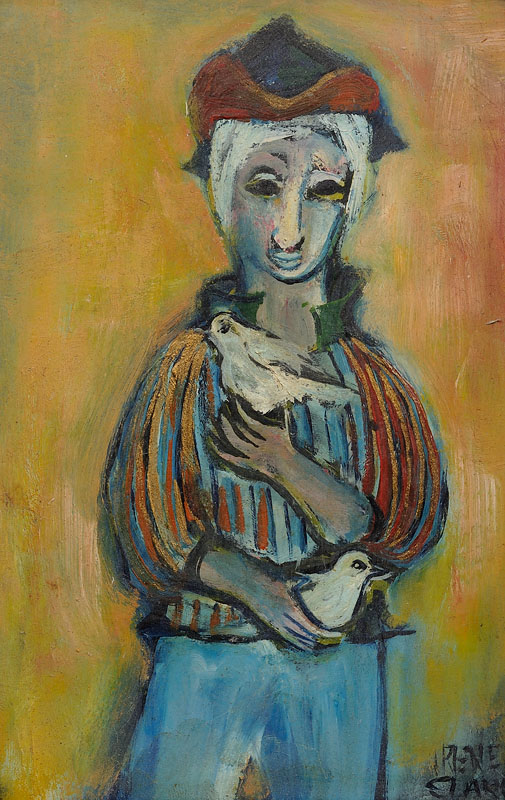
Keeper of the Birds
Oil on board
7x5 inches
c. 1950
Signed
Photo credit: John Wilson White Studio
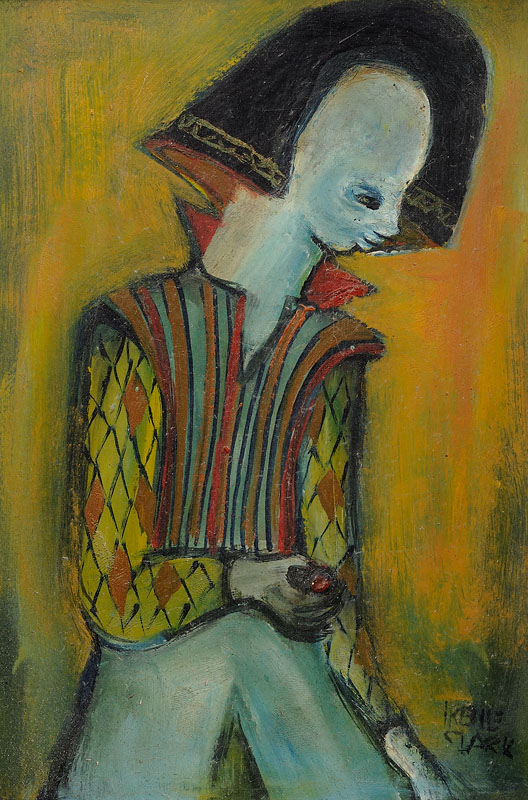
The Marble
Oil on board
7x5 inches
c. 1950
Signed
Photo credit: John Wilson White Studio
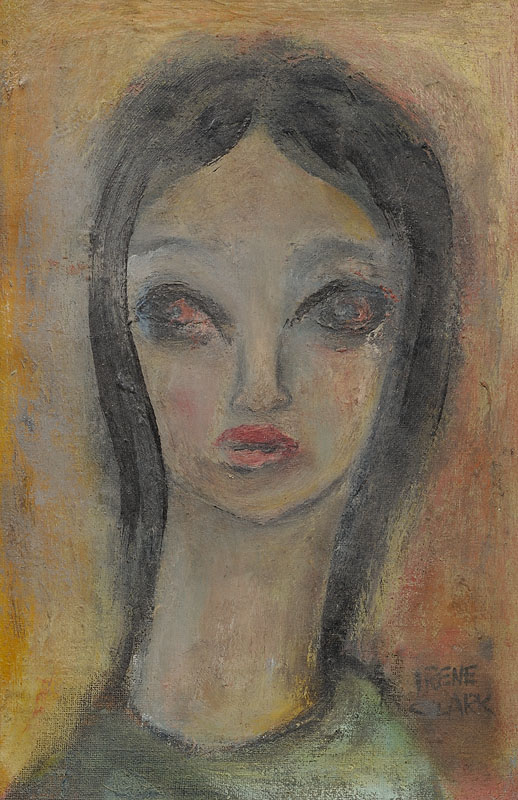
Portrait of a Girl
Oil on board
7x5 inches
c. 1950
Signed
Photo credit: John Wilson White Studio

Sunflowers
Mixed media on board
12x16 inches
Year unknown
Signed
Photo credit: John Wilson White Studio
Eldzier Cortor (1916-2015)
Eldzier Cortor (January 10, 1916 – November 26, 2015) was an African-American artist and printmaker. His work typically features elongated nude figures in intimate settings,[1] influenced by both traditional African art and European surrealism.[2][3]
Cortor was born in Richmond, Virginia,[4][5] to John and Ophelia Cortor.[6] His family moved to Chicago when Cortor was about a year old, eventually settling in that city's South Side, where Cortor attended Englewood High School. Fellow students at Englewood included the African-American artists Charles Wilbert White and Margaret Burroughs.[7] Cortor attended the Art Institute of Chicago, along with artist Gus Nall, gaining a degree in 1936.[8] In 1940 he worked with the Works Progress Administration (WPA),[9] where he drew scenes of Depression-era Bronzeville, a neighborhood on Chicago's South Side. In 1949, he studied in Jamaica, Cuba, and Haiti on a Guggenheim Fellowship,[10] and taught at the Centre d'Art in Port-au-Prince from 1949 to 1951.
Growing up, he was an avid reader of the Chicago Defender, which was a popular newspaper that focused on celebrating the successes of African Americans.[11] This is ultimately translated into the main thematic focus of his artwork, which is to portray African Americans in a positive light and highlight their beauty and achievements. For the majority of his career, Cortor played with different representations of the black female figure and how to represent her strength and beauty. Cortor saw the black female figure as being the essential spirit of the black race. His style is often described as experimenting with black physiognomy while infusing it with surrealism.
In 1944 and in 1945, Cortor won two fellowships that allowed him to travel to the Sea Islands off the coast of Georgia and South Carolina. The Gullah people resided in these islands and Cortor was particularly interested in this area because of how untouched their culture had been by white people and American culture. In this regard, Cortor decided to explore a different African diasporic culture that had more African elements prevalent overall in their culture.[11] He spent two years living on the islands and immersed himself into the Gullah culture. “As a Negro artist I have been particularly concerned with painting Negro racial types not only as such but in connection with particular problems in color, design and composition…I have felt an especial interest in…painting Negroes whose cultural traditions had been only slightly influenced by whites…I should like to…paint a series of pictures which would reflect the particular physical and racial characteristics of the Gullahs.[5]”
Studying the African sculptures at an exhibit at the Field Museum transformed his work.[12] He said "That was the most important influence in all my work, for to this day you will find in my handling of the human figure that clylindrical and lyrical quality I was taught...to appreciate in African art."[13]
Cortor was one of the first African-American artists to make African-American women his dominant theme,[14] explaining, "the Black woman represents the Black race, continuance of life."[15] His treatment of women has been criticised, for instance in a 1985 article in Art, which described the figure in Southern Gate (1942–43) as, "Stripped of integrity and reduced to a mere object…"[16] According to Adrienne Childs, Cortor’s Cuban Souvenir "presents an exoticized black woman whose red dress, red lips…evoke the stereotypical notion of the Latin female sexuality." (Childs 1998: 122).
Mel Edwards mentions Cortor as an example of an African-American artist influenced by surrealism, "who often uses the female figure in a surreal interior and exterior environment."
Cortor is considered to be the first African American artists to depict nude women as the central theme of his work. This was an unpopular choice for many artists at the time as a reaction to the dominant European and American cultural landscape at the time (Farrington 2004: 20). This was also unfavored because of the historical legacy of the sexual exploitation of black women during slavery. Cortor refutes these notions by showing the nude black female body as a source of strength. Cortor also believed that the black woman conveys a sense of eternity and continuance of life (Jennings 1988:, 47). An example of this is Cortor’s famous painting named Southern Gate, which is illustrated in Figure 2. The central figure to this painting is a young, naked black woman. The background of the painting is very dark; the gate is in ruins and the clouds are indicative of a storm. Immediately behind the woman, there are less clouds and more light, which illuminates her figure. The woman also has a flower in her hair and a bird on her shoulder, perhaps indicating the dawn of a new day. The figure in the painting stands stall, giving an overall sense of a triumphant figure still standing throughout the crumbling ruins and the resilience of black women in general (Dallow 2004:98).
Starting in the 1950s, Cortor became further inspired by African sculptures. In these works, one can see that he works more with cylindrical, graceful and elongated limbs. This is evident through Cortor’s painting Dance Composition No. 31, which was produced in 1978 as a part of a series. It is seen as a reflection of his time that he spent with the Gullah people. In this painting, he evokes basketry and dance, which were two activities considered essential to the Gullah people. The swirling lines and the subtle incorporation of vibrant colors implies a sense of visual movement of the dancers (Bearden 1993: 57).[5] The women’s faces’ are depicted like sculptures, giving them a marble feel within the painting, referencing African art along with the decorative patterning. The sculptural women are also conveyed with a sense of peacefulness. This shows how important basket weaving and dancing are to the Gullah people and their culture.
Another example of this subtle shift in Cortor’s work is a painting of his named Classical Study No. 34 which was created in 1968 and also a part of a different series. In this painting, the woman is resting her head on her hand in a profile representation. Cortor plays with her features and makes them rather elongated, which gives a sculptural feel to the subject. She is also wearing a red, yellow and green scarf which is symbolic of the Pan-African flag, which pays homage to her African roots. The figure also resembles ancient marble sculptures, which were used in the past to celebrate someone. This painting is representative of celebrating the beauty and strength of black women, while emphasizing her African roots.
Cortor died on November 26, 2015, at the age of 99.
Abbreviated bio courtesy of Wikipidia. Link to full bio:
https://en.wikipedia.org/wiki/Eldzier_Cortor

Stopping Place
Woodcut
16x9 1/2 inches
1937
Signed and numbered (6/10)
Photo credit: John Wilson White Studio
Allan Rohan Crite (1910-2007)
Allan Rohan Crite Born in 1910 in Plainfield, New Jersey, of African, Indian, and European ancestry, Crite has spent most of his life in Boston. During the course of his long life, Crite enjoyed an extensive career as a painter, draftsman, printmaker, author, librarian, and publisher. At an early age his mother encouraged him to draw and paint, and he took art classes at the School of the Museum of Fine Arts, Massachusetts School of Art, and Boston University. Later he focused on history and the natural sciences, earning a Bachelor of Arts from Harvard University and an honorary doctorate from Suffolk University in Boston. During the 1930s, Crite worked under the auspices of the Works Progress Administration, and in the early 1940s began a thirty-year career as a technical illustrator for the Department of the Navy. A visual chronicler of life in Boston, he is active in the Episcopal Church and is a prolific creator of liturgical art.
Crite’s longstanding interest in recording the urban scene reveals his desire to depict black people as ordinary citizens rather than as Southern sharecroppers or Harlem jazz musicians, images that were becoming prevalent and stereotypical by the 1930s. Crite frequently taps history and autobiography to connect people of color and himself to a larger context, carefully composing the settings of his works to ground them in reality and to make the images accessible to the viewer.
"I've only done one piece of work in my whole life and I am still at it. I wanted to paint people of color as normal humans. I tell the story of man through the black figure"
(quote from www.askart.com)
The figures in Crite’s work are individualized in appearance and clothing. An emphasis on fine detail is in part a manifestation of Crite’s ongoing study of the detailed paintings found in Flemish Late Gothic art. Variations in brushwork, along with rich colors, animate the surface of Crite’s paintings. Even though he was aware of modernism, Crite chose a representational style because it was natural to him and appropriate to his form of communication. “I'm a storyteller, telling a story of people,” Crite claimed, “and I started out with my own people in the immediate sense, like the neighborhood, and people in a general sense when I make a neighborhood out of the whole world.”
Bio courtesy of The Phillips Collection. Link to bio:
http://www.phillipscollection.org/research/american_art/bios/crite-bio.htm

Winter Scene from my Window
Watercolor
15 1/2x11 inches
1933
Signed and dated
On loan to the National Museum of African American History and Culture. Currently on display as part of the 4th floor Visual Arts Exhibit.
Photo credit: John Wilson White Studio

Stations of the Cross
Oil on board
24x18 inches
1947
Signed and dated
Currently on loan to the National Museum of African American History and culture and on display as part of the 4th floor Visual Arts Exhibit.
Photo credit: John Wilson White Studio
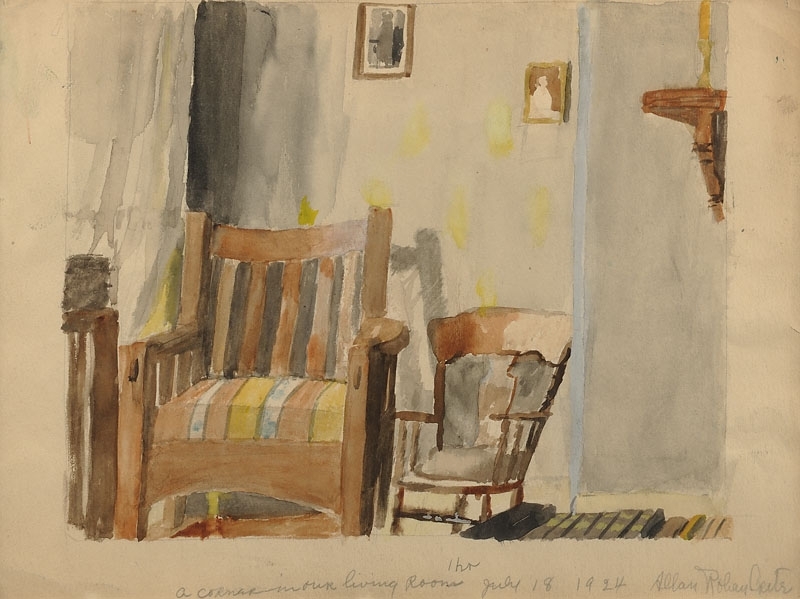
A Corner in our Living Room
Watercolor
1924
10x8 inches
Signed, dated, inscribed and titled
Photo credit: John Wilson White Studio

My front Room
Graphite on paper
9x11 inches
1925
Signed and titled
Photo credit: John Wilson White Studio

Martha's Vineyard
Watercolor
7x9 1/4 inches
1927
Signed and dated
Photo credit: John Wilson White Studio

Still Life
Watercolor
7x7 1/4 inches
1925
Signed
Photo credit: John Wilson White Studio
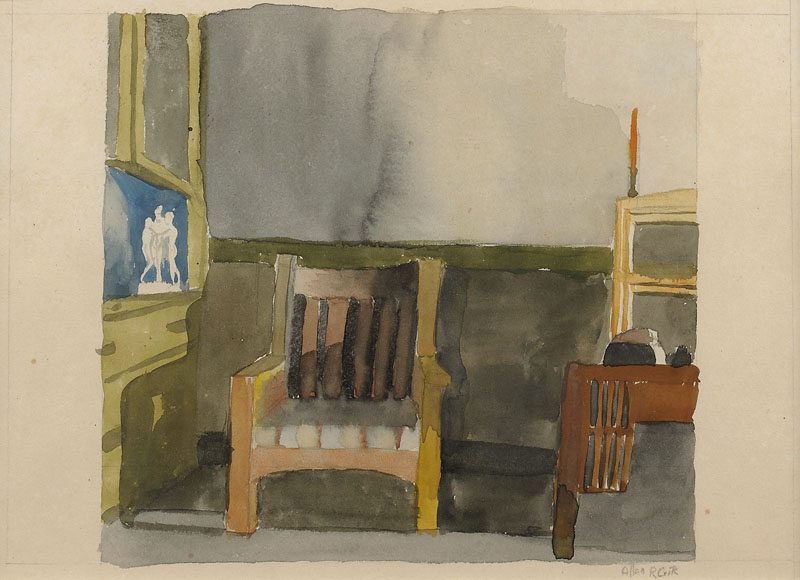
The Living Room
Watercolor
6 1/2x7 inches
1925
Signed
Photo credit: John Wilson White Studio
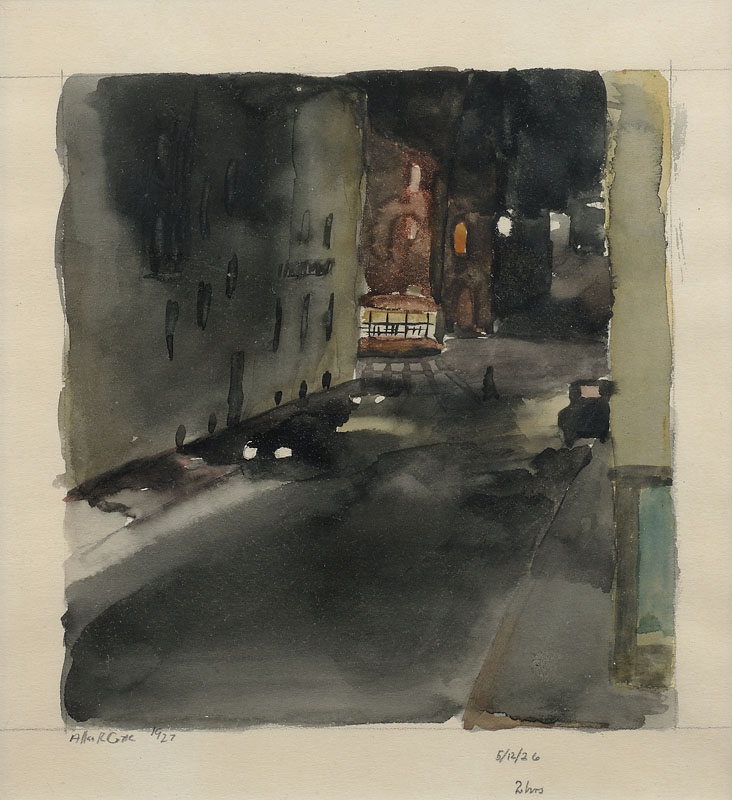
Night Scene from my Window
Watercolor
6 1/4x6 inches
1927
Signed, dated and inscribed
Photo credit: John Wilson White Studio
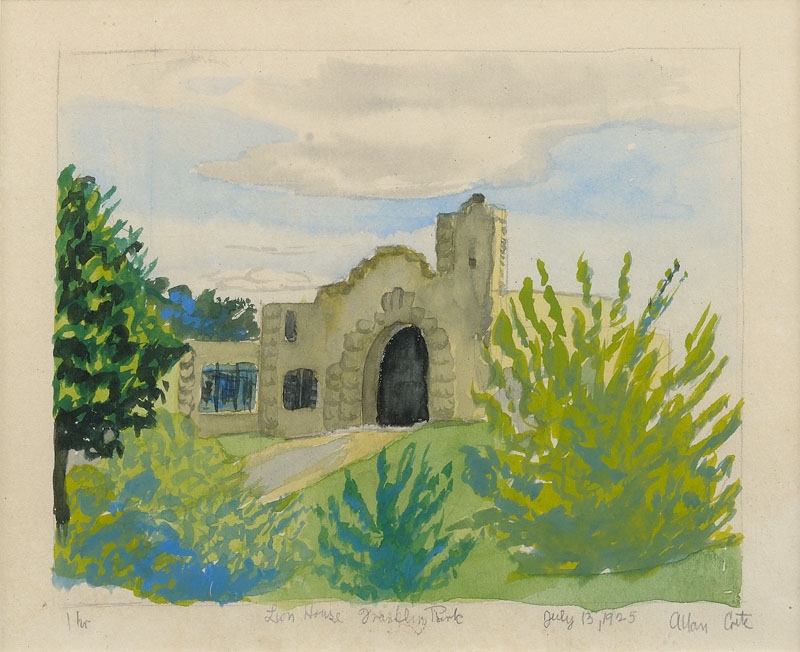
Lion House at Franklin Park
Watercolor
7x8 1/2 inches
1925
Signed, dated and inscribed
Photo credit: John Wilson White Studio

Black Nativity
7x4x1 inches
c. 1930
Stamped in metal (Allan Rohan Crite)
Photo credit: John Wilson White Studio

Port Scene with Airplane
Watercolor
6 1/2x8 1/2 inches
Year unknown
Signed
Photo credit: John Wilson White Studio

Port Scene with Airplane
Watercolor
5 3/4x8 1/2 inches
Year unknown
Signed
Photo credit: John Wilson White Studio
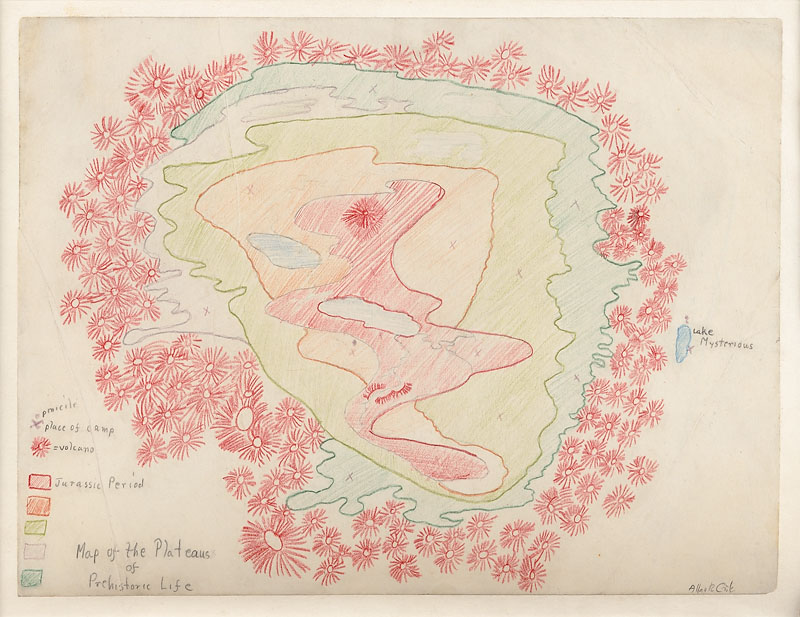
Map of the Plateaus of Prehistoric Life
Colored pencil drawing on cardboard
8 1/2 x11 inches
c. 1990
Signed
Photo credit: John Wilson White Studio

Nativity Scene with Mary and Christ
Crayon drawing
21x16 1/2 inches
c. 1990
Signed
Photo credit: John Wilson White Studio

Memory Sketch of Myself
Graphite on paper
14x17 inches
1927
Signed, titled, dated and inscribed
Photo credit: John Wilson White Studio
Nicholas Davis (b.1937)

Four Black Cyclists in Harlem
Oil on canvas
30x24 inches
1971
Signed and dated
Photo credit: John Wilson White Studio
Charles Dawson (1889-1981)
Best known for his illustrated advertisements, Charles Dawson was an influential Chicago designer and artist through the 1920s and 30’s.
He was born in 1898 in Georgia and went on to attend Booker T. Washington’s Tuskegee Institute. After two years there, he left when he became the first African American to be admitted into the Arts Students League of New York. Dawson abandoned the pervasive racism of the league when he gained acceptance to the Art Institute of Chicago where, in his own words, their attitude was “entirely free of bias.” During his time there, Dawson was heavily involved and went on to become a founding member of the first black artists collective in Chicago, The Arts & Letters Collective.
After graduation, he went on to serve in the segregated forces of WWI where he faced combat in France. He returned to find a changed Chicago: one racially charged due to a slowed economy and trouble finding jobs. In 1922, Dawson began freelancing, producing work for other black entrepreneurs. Five years later, Dawson played a major role in the first exhibition of African American art at his alma mater called Negro In Art Week.
Dawson took part in two different Works Progress Administration programs, under Roosevelt’s New Deal, including the National Youth Administration where he designed the layout for the American Negro Exposition, a piece composed of 20 dioramas showcasing African American history.
He eventually returned to Tuskegee where he became a curator for the institute’s museum and passed away at the ripe old age of 93 in Pennsylvania. For his great contributions to African America art, design, and advancement, Dawson will always be remembered.
Bio courtesy of: https://glenfordlaughton.com/13-african-american-graphic-designers-know-part-1/
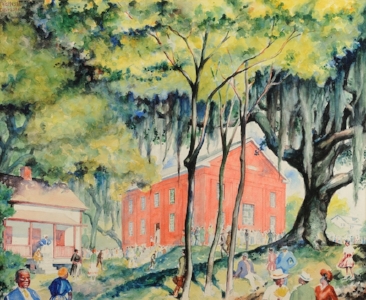
Title Unknown
33x29
Signed
Photo credit: John Wilson White Studio
Richard Dempsey (1909-1987)
Richard W. Dempsey was born in Ogden, Utah, September 14, 1909. His youth was spent in Oakland, California where he attended Sacramento Junior College (1929-31) as an art major and then studied at the following institutions: The California School of Arts and Crafts (1932-34) in Oakland, California; the Students Art Center (1935-40). He held his first one-man exhibition in Oakland, 1935, then headed for San Francisco where he held three exhibitions. In 1941, he moved to Washington, D.C. to work as an engineering draftsman with the Federal Power Commission.
Dempsey also studied at Howard University in Washington, D.C. He studied sculpture with Sargent Johnson, painting with Maurice Logan, Raymond Strong, Katherine Gans, Edward Leslie, Sidney Lemos and lithography with James Wells. He also worked as an engineering draftsman for the US government. In 1946, along with Elizabeth Catlett, he was awarded a Julius Rosenwald Fellowship for a series of paintings of outstanding American Negroes. In 1951, he was awarded a Purchase Award in the Corcoran Gallery's Tenth Annual Exhibition.
Dempsey was a prolific painter and worked on as many as six canvases at one time, switching as his moods changed. His paintings were highly influenced by colors in his Caribbean environment, using them to express feelings of emotions and dimension. His sensitivity to colors was heightened by frequent trips to Jamaica and Haiti. With Dempsey, color, texture, and form unite in his later abstract paintings to compose symphonic poems for the eye of the beholder.
Bio courtesy of: www.Peytonwright.com
http://peytonwright.com/modern/artists/richard-w-dempsey/

Mountains and Fields, Jamaica
Oil on board
38x30 inches
1965
Signature is unintelligible
Photo credit: John Wilson White Studio
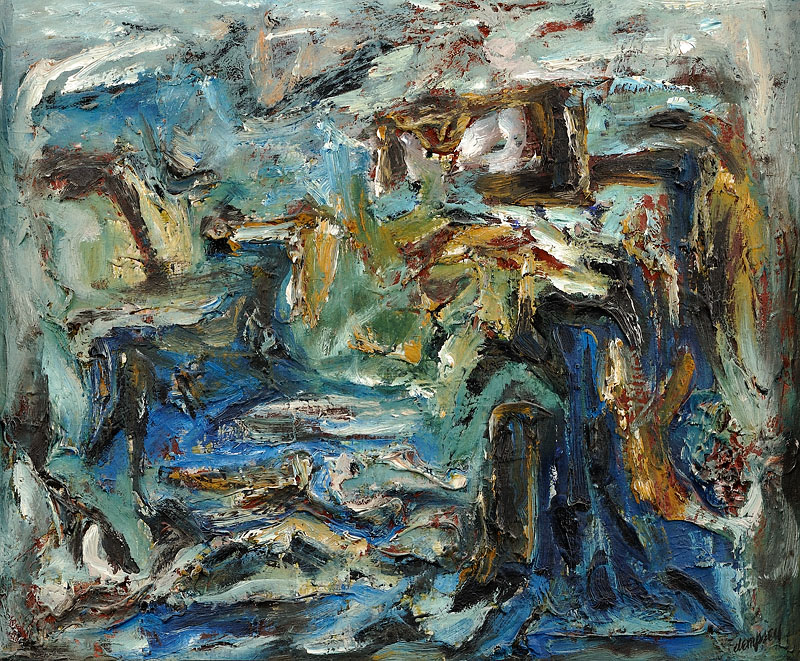
In the Forest
Oil on canvas
20-24 inches
1935
Signed
Photo credit: John Wilson White Studio
Frank Dillon (1865-1954)
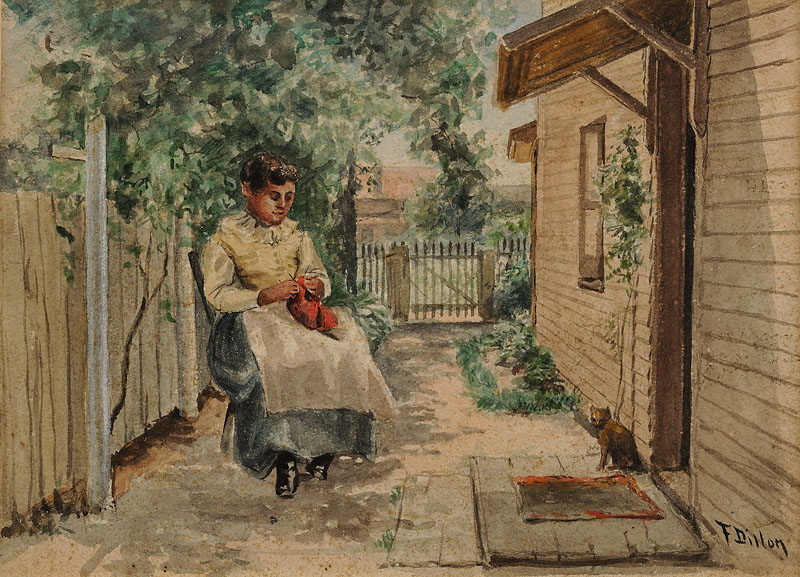
Untitled (Woman Knitting)
Watercolor
6 1/2x9 1/8
Year unknown
Signed
Photo credit: John Wilson White Studio
Aaron Douglas (1899-1979)
Born in Topeka, Kansas, Aaron Douglas was a leading figure in the artistic and literary movement known as the Harlem Renaissance. He is sometimes referred to as "the father of black American art." Douglas developed an interest in art early on, finding some of his inspiration from his mother's love for painting watercolors.
After graduating from Topeka High School in 1917, Douglas attended the University of Nebraska, Lincoln. There, he pursued his passion for creating art, earning a Bachelor of Fine Arts degree in 1922. Around that time, he shared his interest with the students of Lincoln High School in Kansas City, Missouri. He taught there for two years, before deciding to move to New York City. At the time, New York's Harlem neighborhood had a thriving arts scene.
Arriving in 1925, Douglas quickly became immersed Harlem's cultural life. He contributed illustrations to Opportunity, the National Urban League's magazine, and to The Crisis, put out by the National Association for the Advancement Colored People. Douglas created powerful images of African-American life and struggles, and won awards for the work he created for these publications, ultimately receiving a commission to illustrate an anthology of philosopher Alain LeRoy Locke's work, entitled The New Negro.
Douglas had a unique artistic style that fused his interests in modernism and African art. A student of German-born painter Winold Reiss, he incorporated parts of Art Deco along with elements of Egyptian wall paintings in his work. Many of his figures appeared as bold silhouettes.
In 1926, Douglas married teacher Alta Sawyer, and the couple's Harlem home became a social Mecca for the likes of Langston Hughes and W. E. B. Du Bois, among other powerful African Americans of the early 1900s. Around the same time, Douglas worked on a magazine with novelist Wallace Thurman to feature African-American art and literature. Entitled Fire!!, the magazine only published one issue.
With his reputation for creating compelling graphics, Douglas became an in-demand illustrator for many writers. Some of his most famous illustration projects include his images for James Weldon Johnson's poetic work, God's Trombone (1927), and Paul Morand's Black Magic (1929). In addition to his illustration work, Douglas explored educational opportunities; after receiving a fellowship from the Barnes Foundation in Pennsylvania, he took time to study African and modern art.
Douglas created some of his best-known painting in the 1930s. In 1930, he was hired to create a mural for the library at Fisk University. The following year, he spent time in Paris, where he studied with Charles Despiau and Othon Friesz. Back in New York, in 1933, Douglas had his first solo art show. Soon after, he started one of his most legendary works—a series of murals entitled "Aspects of Negro Life" that featured four panels, each depicting a different part of the African-American experience. Each mural included a captivating mix of Douglas's influences, from jazz music to abstract and geometric art.
In the late 1930s, Douglas returned to Fisk University, this time as an assistant professor, and founded the school's art department. Taking his educational responsibilities quite seriously, he enrolled at Columbia University's Teachers College in 1941, and spent three years earning a master's degree in art education. He also established the Carl Van Vechten Gallery at Fisk and helped secure important works for its collection, including pieces by Winold Reiss and Alfred Steiglitz.
Douglas remained committed to learning and growing as an artist, outside of his work in the classroom. He received a fellowship from the Julius Rosenwald Foundation in 1938, which funded his painting trip to Haiti and several other Caribbean islands. He later won other grants to support his artistic endeavors. Continuing to produce new works, Douglas had a number of solo exhibits over the years.
In his later years, Douglas received countless honors. In 1963, he was invited by President John F. Kennedy to attend a celebration of the centennial of the Emancipation Proclamation, held at the White House. He also earned an honorary doctorate from Fisk University in 1973, seven years after his retirement from the school. He remained an active painter and lecturer until the end of his life.
Douglas died at the age of 79 on February 2, 1979, in a Nashville hospital. According to some reports, he died of a pulmonary embolism.
A special memorial service was held for Douglas at Fisk University, where he had taught for nearly 30 years. At the service, Walter J. Leonard, the university's president at the time, remembered Douglas with the following statement: "Aaron Douglas was one of the most accomplished of the interpreters of our institutions and cultural values. He captured the strength and quickness of the young; he translated the memories of the old; and he projected the determination of the inspired and courageous."
Born in Topeka, Kansas, Aaron Douglas was a leading figure in the artistic and literary movement known as the Harlem Renaissance. He is sometimes referred to as "the father of black American art." Douglas developed an interest in art early on, finding some of his inspiration from his mother's love for painting watercolors.
After graduating from Topeka High School in 1917, Douglas attended the University of Nebraska, Lincoln. There, he pursued his passion for creating art, earning a Bachelor of Fine Arts degree in 1922. Around that time, he shared his interest with the students of Lincoln High School in Kansas City, Missouri. He taught there for two years, before deciding to move to New York City. At the time, New York's Harlem neighborhood had a thriving arts scene.
Arriving in 1925, Douglas quickly became immersed Harlem's cultural life. He contributed illustrations to Opportunity, the National Urban League's magazine, and to The Crisis, put out by the National Association for the Advancement Colored People. Douglas created powerful images of African-American life and struggles, and won awards for the work he created for these publications, ultimately receiving a commission to illustrate an anthology of philosopher Alain LeRoy Locke's work, entitled The New Negro.
Douglas had a unique artistic style that fused his interests in modernism and African art. A student of German-born painter Winold Reiss, he incorporated parts of Art Deco along with elements of Egyptian wall paintings in his work. Many of his figures appeared as bold silhouettes.
In 1926, Douglas married teacher Alta Sawyer, and the couple's Harlem home became a social Mecca for the likes of Langston Hughes and W. E. B. Du Bois, among other powerful African Americans of the early 1900s. Around the same time, Douglas worked on a magazine with novelist Wallace Thurman to feature African-American art and literature. Entitled Fire!!, the magazine only published one issue.
With his reputation for creating compelling graphics, Douglas became an in-demand illustrator for many writers. Some of his most famous illustration projects include his images for James Weldon Johnson's poetic work, God's Trombone (1927), and Paul Morand's Black Magic (1929). In addition to his illustration work, Douglas explored educational opportunities; after receiving a fellowship from the Barnes Foundation in Pennsylvania, he took time to study African and modern art.
Douglas created some of his best-known painting in the 1930s. In 1930, he was hired to create a mural for the library at Fisk University. The following year, he spent time in Paris, where he studied with Charles Despiau and Othon Friesz. Back in New York, in 1933, Douglas had his first solo art show. Soon after, he started one of his most legendary works—a series of murals entitled "Aspects of Negro Life" that featured four panels, each depicting a different part of the African-American experience. Each mural included a captivating mix of Douglas's influences, from jazz music to abstract and geometric art.
In the late 1930s, Douglas returned to Fisk University, this time as an assistant professor, and founded the school's art department. Taking his educational responsibilities quite seriously, he enrolled at Columbia University's Teachers College in 1941, and spent three years earning a master's degree in art education. He also established the Carl Van Vechten Gallery at Fisk and helped secure important works for its collection, including pieces by Winold Reiss and Alfred Steiglitz.
Douglas remained committed to learning and growing as an artist, outside of his work in the classroom. He received a fellowship from the Julius Rosenwald Foundation in 1938, which funded his painting trip to Haiti and several other Caribbean islands. He later won other grants to support his artistic endeavors. Continuing to produce new works, Douglas had a number of solo exhibits over the years.
In his later years, Douglas received countless honors. In 1963, he was invited by President John F. Kennedy to attend a celebration of the centennial of the Emancipation Proclamation, held at the White House. He also earned an honorary doctorate from Fisk University in 1973, seven years after his retirement from the school. He remained an active painter and lecturer until the end of his life.
Douglas died at the age of 79 on February 2, 1979, in a Nashville hospital. According to some reports, he died of a pulmonary embolism.
A special memorial service was held for Douglas at Fisk University, where he had taught for nearly 30 years. At the service, Walter J. Leonard, the university's president at the time, remembered Douglas with the following statement: "Aaron Douglas was one of the most accomplished of the interpreters of our institutions and cultural values. He captured the strength and quickness of the young; he translated the memories of the old; and he projected the determination of the inspired and courageous."
Bio courtesy of www.biography.com
https://www.biography.com/people/aaron-douglas-39794

Haitian Street Scene
Oil on canvas
17x19 inches
1937
Signed
Donated to the National Museum of African American History and Culture. Currently on display as part of the Visual Arts Exhibit on the 4th floor.
Photo credit: John Wilson White Studio

Pier at Sausalito
Watercolor
13 1/2X19 3/4 inches
1952
Signed and dated
Photo credit: John Wilson White Studio
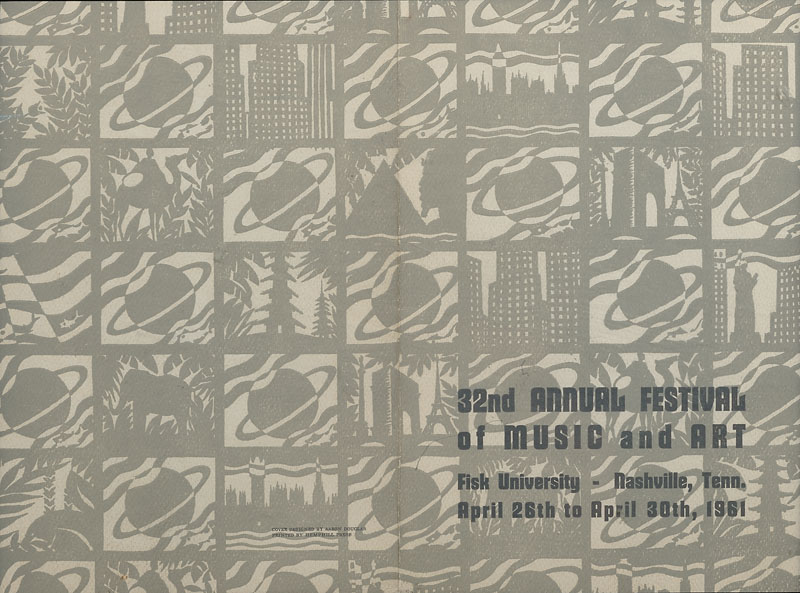
Thirty-Second Annual Festival of Music and Art
Lithograph
9 1/4x12 1/2 inches
April 1961
Unsigned
Photo credit: John Wilson White Studio
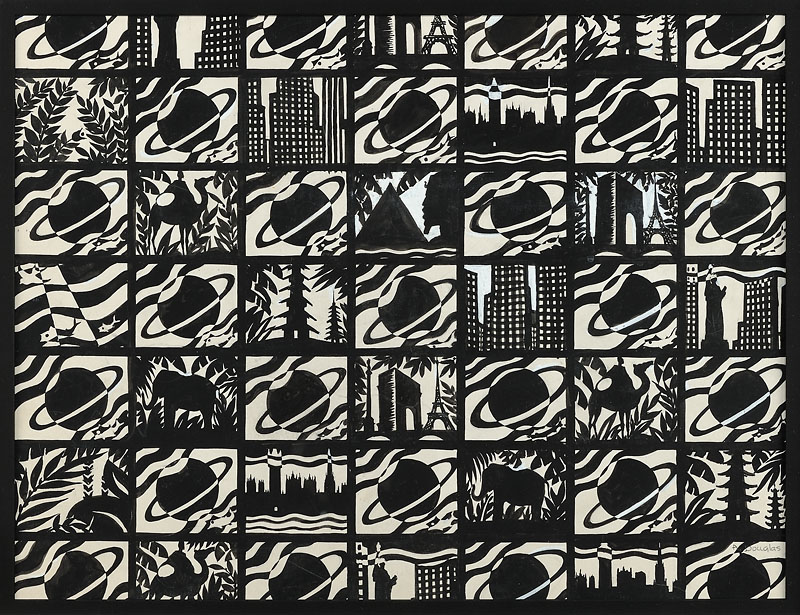
James W. Edwards
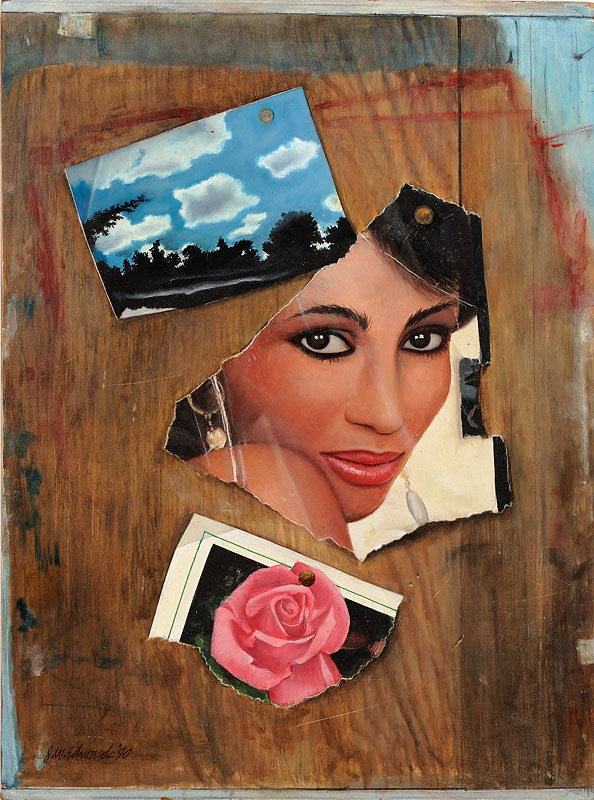
Iman
Collage on board
16x12 inches
1990
Signed and dated
Photo credit: John Wilson White Studio

Black Woman with White Legs
Oil on canvas
16x12 inches
1983
Signed and dated
Photo credit: John Wilson White Studio

Nude Woman
Oil on canvas
20x12 inches
1971
Signed and dated
Photo credit: John Wilson White Studio

The Tear
Oil on canvas
24x20 inches
1989
Signed and dated
Photo credit: John Wilson White Studio

The Dancer
Collage on board
24x9 1/2 inches
1978
Signed and dated
Photo credit: John Wilson White Studio

Minnie Evans (1892-1987)
Minnie Eva Evans[1] (December 12, 1892 – December 16, 1987) was an African American artist who worked in the United States from the 1940s to the 1980s.[2] Evans used different media in her work, but started with using wax and crayon.[2] She was inspired to start drawing due to visions and dreams that she had when she was a young girl.[2] She is known as a southern folk artist and as a surrealist and visionary artist as well.[2]
Evans (born Minnie Eva Jones) was born to Ella Jones on December 12, 1892 in Long Creek, Pender County, North Carolina.[2] Ella was only thirteen years old at the time. Evans' biological father, George Moore, left after she was born. After Evans was only two months old, she and her mother moved to Wilmington, North Carolina to live with Evans' grandmother, Mary Croom Jones in 1893.[3] Minnie Jones attended school until the sixth grade and in 1903, Minnie Jones, Ella, and Mary Croom Jones moved to Wrightsville Sound which was a town close to Wilmington.[4] In Wrightsville, Ella Jones met her future husband, Joe Kelly, and they married in 1908.[3] During this time, Jones worked as a "sounder" selling shellfish door to door.[5] In 1908, one of Joe Kelly's daughter's from a previous marriage introduced Minnie Jones to Julius Caesar.[3] Minnie Jones, who was sixteen at the time, married Julius (19) that same year.[4] The couple had three sons, Elisha Dyer, David Barnes Evans, and George Sheldon Evans.[4]
Beginning in 1916, Minnie Evans was employed as a domestic at the home of her husband's employer, Pembroke Jones, a wealthy industrialist.[4] The Evans family lived on Jones's hunting estate, "Pembroke Park," known today as the subdivision Landfall. Pembroke Jones died in 1919 and his wife, Sadie Jones remarried Henry Walters. The couple moved nearby to the Arlie Estate which was left to Sadie Jones from Pembroke Jones. Evans continued to work from Sadie Jones and now Henry Walters, on the Arlie Estate. After Walters died, Sadie Jones decided to turn the Arlie Estate into gardens which later became one of the most famous gardens of the south.[3] After Sadie Jones died, a man named Albert Corbet bought the property in 1947 and assigned Evans to be the gatekeeper and take admission from public visitors.[3] She held this position for the rest of her life.[3] She retired from her job as the gatekeeper when she was 82 years old in 1974.[3]
Evans began drawing on Good Friday 1935, where she finished two drawings using pen and ink "dominated by concentric and semi-circles against a background of unidentifiable linear motifs".[6] She heard a voice in her head that said ‘Why don't you draw or die?'[4] After this, Evans did not resume drawing until 1940.[4] She started using pencil and wax on paper for her beginning works and she later worked with oil paints and mixed media collages.[2] Her subject matter were usually either biblical scenes or scenes from nature. Her influences included African, Caribbean, East India, Chinese, and Western cultures.[2] Since she held the position as gatekeeper at the Arlie Gardens, she often used the gardens as her inspiration in her work to depict nature scenes.[2]
Evans first started selling her work at the Arlie Gardens by hanging her pieces on the front gate of the gardens. Those who would come and visit the Arlie Gardens began purchasing her work. Soon she became known throughout the south and visitors would come to the gardens just to see her work.[3] In 1961, she had her first formal exhibition of drawings and oils at the Artists Gallery in Wilmington, NC.[3]
In 1962, she met Nina Howell Starr, who would publicize her work for the next 25 years. Starr, also an artist herself (photographer), knew of Evans' work in 1961 and wanted to meet the artist in person. Evans sold her first painting for 50 cents apiece. Folk art specialist and photographer,Howell, encouraged Evans to sell her paintings for better prices, and assisted Evans throughout her career. Evans felt her work was too personal to share with the public which held her from releasing anything until 1961 when she had her first major art exhibition at The Little Gallery in Wilmington, now known as St. John’s Museum. From 1962-1973, Starr recorded interviews with Evans about her work. At first, Evans was weary to trust Starr with her work, but they gained a mutual respect for each other.[3] Starr helped to launch Evans' career by storing and selling her art in New York City. She also guided her in the art world by making her sign and date her pieces.[7] In 1966, Starr arranged for Evans' first New York exhibit at The Church of Epiphany and Clements Episcopal Church.[3] In August 1969, another exhibition of Evans' work took place at the Art Image Gallery of New York and in 1975, curated a major Evans exhibition at the Whitney Museum of American Art.[3] With failing health, another exhibition of her work was curated in 1980 at the St. John's Museum.[3] She also had many other exhibitions in New York as well.[3]
Many art critics have labelled Evans work as “surrealistic”, “visionary”, and “psychedelic”. Religion played a vital role in many of Evans paintings. Evans later confessed she wasn’t sure of the meanings behind her paintings, stating, “When I get through with them I have to look at them like everybody else. They are just as strange to me as they are to anybody else.”[8]
Evans created "one of the most powerful works of art "[9] which was a self-portrait on the cover of a scrapbook in 1981. Evans died December 16, 1987 at age 95, leaving more than 400 artworks to the St. Johns Museum of Art (now the Cameron Art Museum) in Wilmington. After Evans's death, artist Virginia Wright-Frierson designed and built the Minnie Evans Bottle Chapel at Airlie Gardens in her memory. "Minnie Evans" day was proclaimed on May 14, 1994 in Greenville, NC.[3]
Evans was the subject of the documentary The Angel that Stands By Me: Minnie Evans' Art in 1983.
Her first works, titled My Very First and My Second are ink on paper. The entire surface is filled with abstract designs and shapes with nature images and themes in both. These works are not in color.[11]
Another work titled "Design: Airlie Garden" depicts flowers, plants, and butterflies. The nature theme is shown here, but this piece is somewhat atypical due to the asymmetry of the painting.[3]
Two other works, both untitled are more typical works by Evans. One, dated 1996, depicts a woman with a feathered headdress and a green bird. This piece has bold colors, symmetrical, and includes nature themes. The media used is graphite, ink, tempera, and wax crayon on paper. The other is a female portrait including the theme of eyes, bold colors, and nature designs as well. The media used is Gauache, ink and wax crayon on paper.[12]
Now recognized as one of the most important visionary folk artists of the 20th century, her work is highly collected by many museums and collectors all across the world. Despite her prolific and long career, her works do not come up for sale often. When they do, there is always strong competition.[citation needed] Her work has been, and in some cases is still, on display at many museums across the country. Her work can be viewed at such museums as the Museum of Modern Art, the Smithsonian Institution, the Abby Aldrich Rockefeller Folk Art Museum, the American Folk Art Museum, the Whitney Museum of American Art, the Ogden Museum of Southern Art, and the High Museum of Art.
A review of a 2017 exhibit notes the contrast between Evans' later works -- "increasingly sophisticated" faces and greater "familiarity with nature" -- with her first drawings between 1935 and 1940, which "indicate her innate genius and awareness, in the raw and in transition."
Bio courtesy of Wikipidia. Link to full bio: https://en.wikipedia.org/wiki/Minnie_Evans

His Eyes are Watching You
Crayon on paper
12x9 inches
1962
Signed and dated
Tom Feelings (1933-2003)
Tom Feelings (May 19, 1933 – August 25, 2003)[1] was a cartoonist, children's book illustrator, author, teacher, and activist. Through his works, he framed the African-American experience. His most famous book is The Middle Passage: White Ships/Black Cargo.
Feelings was a prolific and accoladed illustrator, the recipient of numerous awards for his art in children's picture books; he was the first African-American artist to win the Caldecott Honor Award, and was the recipient of a grant from the National Endowment for the Arts. He lived in New York City, Ghana, and Guyana.[2][3]
Feelings was born on May 19, 1933 in the Bedford-Stuyvesant section of Brooklyn, New York.[4] He attended the George Westinghouse Vocational High School, where he majored in art, and later the Cartoonists' and Illustrators' School, which he attended for two years on a scholarship. During this freelance period, he primarily depicted African-American residents of his community.[3]
His earliest known (signed) comic book work may be the story "Scandal" in Key Publication's third issue of Radiant Love (February 1953).
A skilled cartoonist, Feelings created the groundbreaking comic strip Tommy Traveler In the World of Negro History for the New York Age in 1958 after leaving the Air Force. Based on his own experience after discovering the adult section of the public library while researching a school project, Tommy Traveler is a black youth's dream adventures in American history while reading of notable black heroes. This material was released in book form in 1991.
In about 1960 Feelings illustrated the NAACP's four-color comic for voter registration, The Street Where You Live. Another early piece was for Look magazine, doing portraits of children in New Orleans in 1962.
Around 1968 he met Bertram Fitzgerald and he became one of the first contributors to Fitzgerald's new line of black history comics with the umbrella title Golden Legacy. In an interview Fitzgerald recalled at this time Feelings had done a previous biography of Crispus Attucks,[5] the first casualty of the American Revolution, which was adapted into the Golden Legacy series. Crispus Attucks was one of the characters in the Tommy Traveler newspaper strip.
From the late 1960s through the 1990s, Feelings concentrated on children's books, illustrating other authors' works as well as writing his own. Notable titles included To Be a Slave (written by Julius Lester), Moja Means One: Swahili Counting Book, Jambo Means Hello: A Swahili Alphabet Book, and The Middle Passage: White Ships/Black Cargo.
Feelings died aged 70 in 2003, in Mexico, where he had been receiving treatment for cancer.
Bio courtesy of Wikipidia. Link to full bio: https://en.wikipedia.org/wiki/Tom_Feelings

Untitled (OB Clinic)
Charcoal
9x8 inches
Year unknown
Signed
Photo credit: John Wilson White Studio

Untitled (Woman)
Mixed media on paper
7 1/2 x5 1/2 inches
1964
Signed, dated and inscribed
Photo credit: John Wilson White Studio
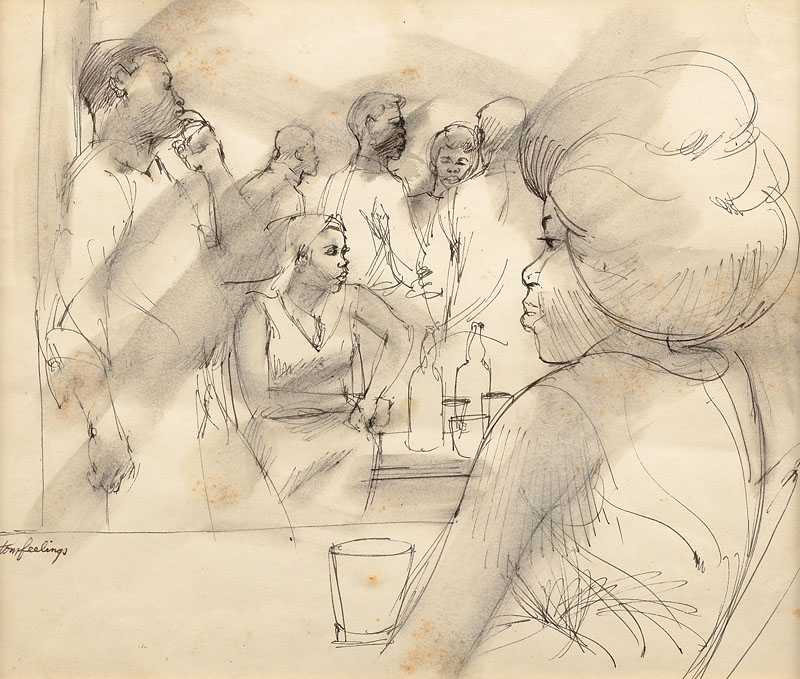
Untitled (Bar Scene)
Ink wash
9 1/2x11 inches
c. 1950
Signed
Photo credit: John Wilson White Studio

Untitled (Seated Woman)
Charcoal
11x14 1/2 inches
Year unknown
Signed
Photo credit: John Wilson White Studio
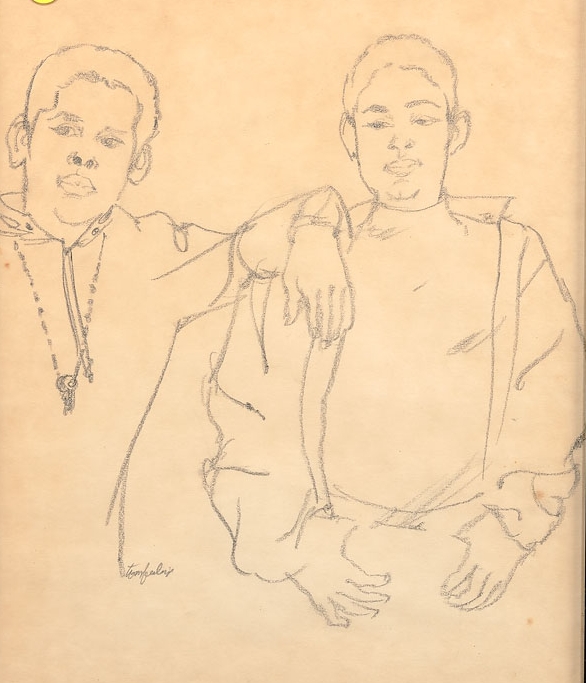
Untitled (Two Boys)
Charcoal
16x12 1/2 inches
Year unknown
Signed
Photo credit: John Wilson White Studio
Alan Randall Freelon (1895-1960)
Allan Randall Freelon, Sr. (September 2, 1895 – August 6, 1960),[1] a native of Philadelphia, US, was an African American artist, educator and civil rights activist. He is best known as an African American Impressionist-style painter during the time of the Harlem Renaissance and as the first African American to be appointed art supervisor of the Philadelphia School District.
Born in Philadelphia on September 2, 1895, to Douglas Freelon and Laura E. (Goodwin) Freelon,[2] a "middle-class family of notable academic achievement",[3] Freelon was the oldest of three children. On September 4, 1918, he married Marie J. Cuyjet,[4] and they had one child, Allan Randall Freelon, Jr. At some point Freelon and Cuyjet divorced; Freelon was married to Mary Kouzmanoff at the time of his death, August 6, 1960. He died while at his art studio in Telford, Pennsylvania.[5] Architect Philip Freelon is his grandson.[6]
Freelon attended the South Philadelphia High School for Boys, followed by a four-year scholarship (1912–1916) to the Pennsylvania Museum and School of Industrial Art,[6] from which he graduated in 1916 with a diploma in normal art instruction (what would be called art education today). From there he attended the Philadelphia School of Pedagogy,[7] an upper division of Central High School created to prepare men for teaching careers. Following a stint in the Army from 1917 to 1919, where he served as a second lieutenant,[2] he attended the University of Pennsylvania and graduated in February 1924 with a BS in education. Further studies ensued at the Barnes Foundation (1927 through 1929),[8] followed by private studies with Emile Gruppe, modernist Earl Horter (1881–1940), neo-Impressionist Hugh Breckenridge (1870–1937), and printmaker Dox Thrash (1892–1965),[2] and the earning of an MFA in 1943[9] from Tyler School of Art of Temple University.
One of Freelon's earliest documented exhibitions also happened to be the first exhibition of African-American art in Harlem, at the 135th Street Branch of the New York Public Library,[10] now part of the Schomburg Center for Research in Black Culture. He later exhibited from 1928 to 1932 and in 1934 with the William E. Harmon Foundation,[2] whose exhibitions traveled widely in the United States. Other exhibition venues included the Albright-Knox Gallery (Buffalo, NY), the National Gallery of Art(Washington, DC), Howard University Gallery of Art (Washington, DC), New Jersey State Museum (Trenton, NJ), Arthur U. Newton Gallery (New York, NY), Whitney Museum of American Art (New York, NY), Lincoln University,[11] and Lehigh Art Alliance (Lehigh, PA).[2]
Freelon was one of seven African-American artists who participated in the exhibition Art Commentary on Lynching, organized by the NAACP in response to deaths such as that of Claude Neal. The exhibition was held February 15 to March 2, 1935, in New York. Freelon's work, Barbecue – American Style, portrays a naked man, tortured and in flames, encircled by the feet of spectators.[12][13] He wrote:
I have not attempted to portray any particular lynching, but merely to record the horror of what has come to be a major sports event...[13]
Freelon was a member of Alpha Phi Alpha fraternity, Philadelphia Art Teachers Association, Philadelphia Art Week Association,[8] Artists' Equity, Tra Club, Pyramid Club,[10] Society of New Jersey Artists,[14] North Shore Art Association of Gloucester, MA, American Federation of Arts,[8] and was the first person of color elected to the Print Club of Philadelphia.[15]
Formed in 1937, the Pyramid Club provided prominent African Americans, who were excluded from most clubs, with opportunities to meet and network.[16][17] From March 2–16, 1941, the Pyramid Club sponsored the first of its annual invitational art exhibits, 20th Century Negro Contemporary Artists and Memorial Paintings of Henry O. Tanner.[18][19] Freelon was asked to speak at the inaugural event, and discussed the role of the Black artist and his influence in current events.[10]
Coming of artistic age during the time of the "New Negro", Freelon found himself in aesthetic disagreement with fellow Philadelphian Alain LeRoy Locke, who urged African American artists to take up African themes as the source for their art in The New Negro (NY: Boni, 1925). Freelon "vigorously defended the artist's right to freedom of expression",[2] writing in a 1944 review[20] of James A. Porter's book, Modern Negro Art:
In his chapter on the "New Negro" movement, Mr. Porter analyzes that most interesting and fecund period of the late twenties, when opposite schools of thought were attempting to direct the Negro artist into this "African background," or insisting that he be accorded the same freedom of choice as that granted any other artist as regards subject matter and means of expression. The author dispassionately evaluates both theories and his conclusions are valid and sound. He brands the "African background" theory for what it was: propaganda.
Following his 1919 graduation from the Philadelphia School of Pedagogy,[2] Freelon became an art teacher in the Philadelphia public school system. In 1921 he was appointed as assistant director of art education, the first African American to be appointed to the district's Department of Superintendence.[8] In July 1939 he was named "special assistant to Theodore M. Dilliway [sic: Dillaway], director of art in the Philadelphia public schools, and will supervise art work in vocational and junior high schools. He has been supervising art projects in the elementary schools for a number of years, and his promotion follows competitive examination for the new post, held recently by Board of Education."[21] He placed first in that examination[22] and held that position until his death. Deeply interested in printmaking, Freelon taught etching and lithography at the Philadelphia Museum of Art from 1940 to 1946.[14]
Bio courtesy of Wikipidia. Link to full bio: https://en.wikipedia.org/wiki/Allan_Randall_Freelon

Untitled (Harbor)
Oil on board
8x10 inches
c. 1940
Signed
Photo credit: John Wilson White Studio
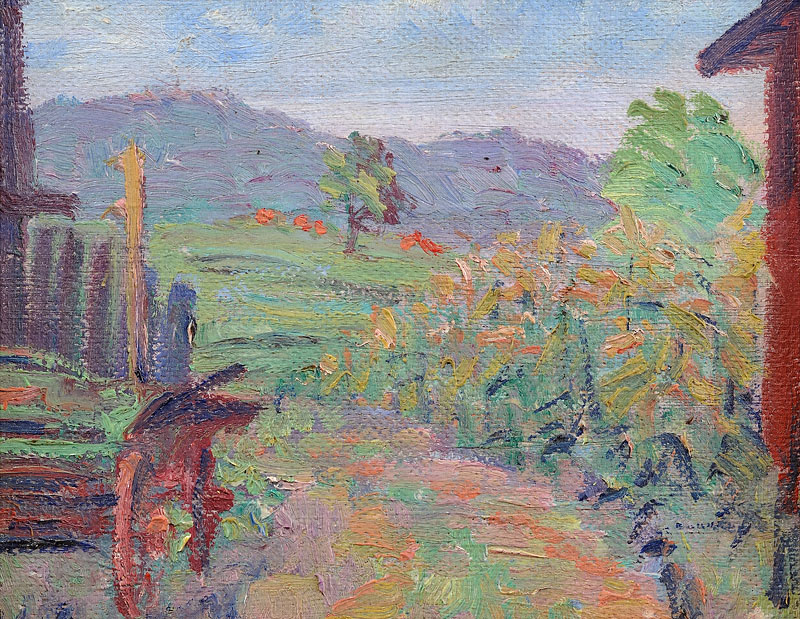
Untitled (Landscape)
Oil on board
7 1/2x9 1/2 inches
Year unknown
Not signed
Photo credit: John Wilson White Studio
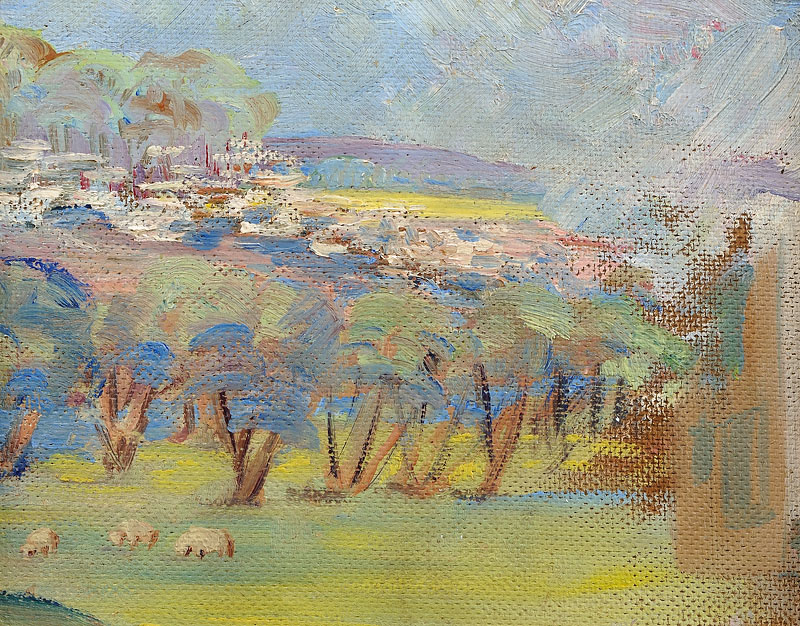
Untitled (Sheep Grazing)
Oil on board
7 1/2x9 1/2 inches
Year unknown
Not signed
Photo credit: John Wilson White Studio
Ramon Gabriel (b.1911)
Ramon Gabriel was a Chicago School painter active in the 1940’s & 50’s. Gabriel disappeared in the late 1950’s at the height of his career. He is recognized as one of the standout WPA artists active with the South Side Center for Art in Chicago.
According to The Chicago Council on Fine Arts catalog for their 1978 show, ‘Gabriel was cited by American Magazine of Art as belonging to ... “One of the most lively and original groups of American artists anywhere to be found.” Gabriel is an artist who found his metaphor quite early and all of his work show no marked departure from those done in the late 1940’s.’
Bio courtesy of www.artadoo.com. Link to full bio:
http://www.artadoo.com/en/display/artist/name/ramon-gabriel/id/18943

On South Parkway
Watercolor
23 1/4x18 inches
1941
Signed
Photo credit: John Wilson White Studio
Alice Taylor Gafford (1886-1981)
Alice Taylor Gafford (August 15, 1886 – October 27, 1981) was an American nurse, teacher, and artist, based in Los Angeles.
Alice Taylor was born in Tecumseh, Kansas, one of ten children. Her parents were Benjamin and Alice Armstead Taylor.[1][2]
Gafford was a nurse for twenty-five years before beginning her career in art. Notable from her first career are a stint with the American Red Cross in Alaska (1915–16), and work with Daniel Hale Williams in Chicago.[3]
She moved to Los Angeles in 1922. She trained at Otis Art Institute and earned a teaching certificate at UCLA in 1951, when she was sixty-five years old, and taught art in an adult education program.[4][5]
She was active in the Val Verde community, teaching and holding art exhibitions, and chairing the Val Verde Women's Cultural Society.[6][7] Her works, mostly still life or landscape scenes, were exhibited often in her later years.[8][9][10] At 81, she accepted a commission to paint portraits of twelve notable African Americans, for display at the Family Savings and Loan Association offices in Los Angeles.[11]
Gafford was involved in founding the Los Angeles Negro Art Association in 1937, and the Eleven Associated Artists gallery (later Art West Association) in downtown Los Angeles.[12] She was called "the dean of black artists in Los Angeles" in recognition of her community leadership.[13][14] Her oil paintings were part of a Negro History Week exhibit at Doheny Library in 1953.[15]
Alice Taylor married Louis Sherman Gafford, a World War I veteran, in 1928. She was widowed in 1959, and stopped painting in 1975, after developing cataracts. Alice Taylor Gafford died in 1981, age 95, and her remains were buried at Los Angeles National Cemetery.[16]
The annual Val Verde art show she founded was later named in honor of Gafford.[17] She is remembered as an early African-American woman artist in Los Angeles, and as an artist who became especially productive at an advanced age.[18][19] She is represented by paintings in the collections of Howard University, the Long Beach Museum of Art, and the Bowers Museum, among other institutions.[20]
Bio courtesy of Wikipidia. Link to full bio: https://en.wikipedia.org/wiki/Alice_Taylor_Gafford
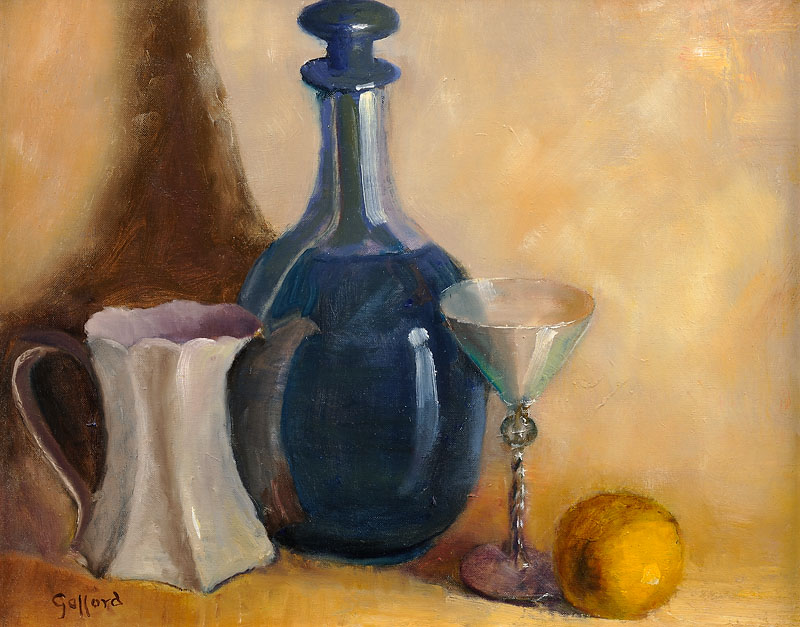
Still Life, Bottle of Wine, Pitcher, Glass and Lemon
Oil on board
15x19 inches
Year unknown
Signed
Photo credit: John Wilson White Studio
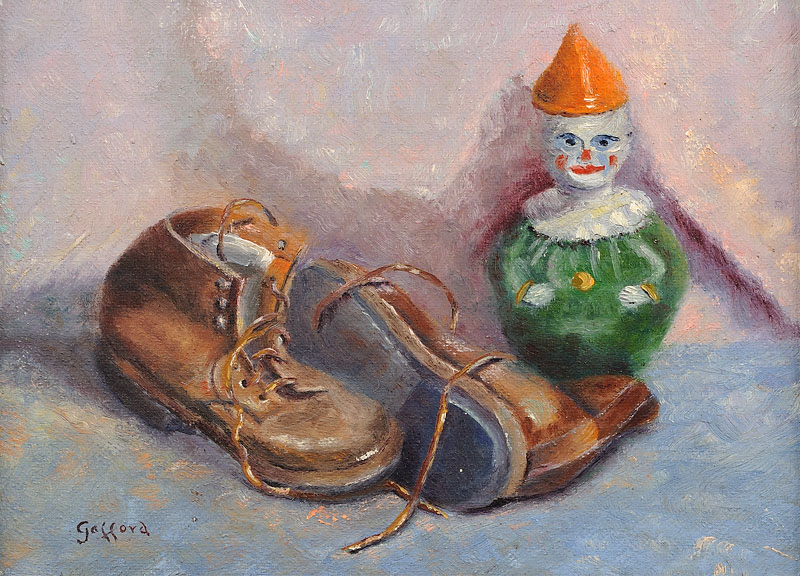
Untitled (Still Life of Shoe and Clown)
Oil on board
12x16 inches
Year unknown
Signed
Photo credit: John Wilson White Studio
Herb Gentry (1919-2003)
Herbert Alexander Gentry, popularly known as Herb Gentry (July 17, 1919 – September 8, 2003), was an African-American Expressionist painter who lived and worked in Paris, France (1946–70; 1976–80), Copenhagen, Denmark(1958–63), in the Swedish cities of Gothenburg (1963–65), Stockholm (1965–76; 2001–03), and Malmö (1980–2001), and in New York City (1970–2000) as a permanent resident of the Hotel Chelsea.
Gentry's paintings juxtapose faces and masks, shifting orientations of figures and heads—human and animal—into profiles, to the left, to the right, above and below. The direction of the head, as face or profile, leading right or left, or facing front, is played against the relative scale of each head, its position on the canvas, and in relationship to the others.
The faces evoke subtle expressions and moods. Rather than using images to depict a concrete story, Gentry releases his experiences upon the canvas. The act of spontaneous painting uses consciousness itself, and each painting reveals the self. When asked about direct influences, he avoids imposing external meanings upon primary experience, describing instead his creative process.[1]
Philosophically near the jazz musician, Gentry breathes rhythms into a personally inflected expressionism. "The staccato beat of jazz is fused with biomorphic form in paintings which never become totally abstract, but hold the picture plane in the Cubist tradition," wrote art historian Peter Selz (1994) about Gentry's work.[2] Gentry creates a foil for feelings and for emotion, and orchestrates his subjective figuration in dialogue with the immediacy of the painted gesture. Romare Bearden (1981) wrote that Gentry's "method is conceptual rather than realistic. One senses in the chromatic emotionalism, and in the biomorphic forms of the figures that often appear in Gentry's paintings, the strong pull of the unconscious."[3]
Herbert Alexander Gentry was born in Pittsburgh, Pennsylvania, on July 17, 1919. He was the son of James Jentry of Madison Courthouse, Virginia, and Violet Howden of Kingston, Jamaica. By 1924 Gentry was living in Harlem, New York City, with his mother and her family.
The Harlem Renaissance provided the backdrop for Gentry's childhood. His mother worked as a dancer and actress. Under the name Teresa Gentry, she danced in the chorus with Josephine Baker and Bessye Buchanen. Later, she was in the cast of the original rendition of the Ziegfeld musical Show Boat in 1927, as well as its revival in 1932. His mother's friends included Langston Hughes, Paul Robeson and Duke Ellington.
As a youngster Gentry had a role in the play Scarlet Sister Mary, which toured the country with actress Ethel Barrymore and opened on Broadway in 1931.[4] Gentry took inspiration from artists, musicians, writers, dancers, and actors, all of whom reinforced his belief in the creative world that lay beyond Harlem.
Educated in the New York City public schools, Gentry attended Cooper Junior High and George Washington High School. He pursued drawing in school took art classes at the Harlem YMCA and later studied art as part of the under the Federal Art Project of the WPA (Works Progress Administration) at Roosevelt High School.
In 1939, the leadership of Harlem protest demonstrations against employment discrimination is said to have included besides Rev. Adam Clayton Powell, Jr.[5] Gentry's older cousin Arnold P. Johnson. Protester Gentry, who was studying business at New York University, is said to have been Consolidated Edison New York's first Black employee in a white-collar position and to have tolerated being told by company directors to the effect that, "If you do well, we'll hire others."[6]
He served in the U.S. Army (1942–45), serving in the 90th Coast Guard Artillery / Anti-Aircraft Regiment working in Special Services. His U.S. Army Service in World War II took him to different countries in the Mediterranean and Northern Europe: Morocco, Algeria, Madeline Island (Italy), Corsica, Marseilles, Paris, Alsace-Lorraine (France), and Salzburg (Austria). At the end of the war, Gentry was stationed in the Paris suburb of Crepy-en-Vallois. He took every opportunity to visit Paris.[7]
The center of the Art World before World War II, Paris still held that title in 1946. Paris touched other memories for ex-soldier Gentry, who as a youth had heard many of his mother's friends speak of their travel and performances in Paris. Home in Harlem after his discharge from the Army, he wanted to study art in Paris. Not waiting for the administration of the GI Bill to be organized in Paris, and warned that the basic amenities were still rationed, Gentry arrived for the Fall 1946 academic term.
His first year back in Paris, Gentry resided at the American House at the Cité Internationale Universitaire de Paris, where he met fellow American students: sculptor Kosta Alex, pianist Julian Ketcham, and writers Marc Behm and Dan Kurzman. Moving beyond student circles, he sought out author Richard Wright, who encouraged him in his art; he got to know writer James Baldwin.
Gentry studied French at the Alliance Française, and was enrolled at the Ecole des Hautes Etudes Sociales. Académie de la Grande Chaumière had an approach to art teaching that matched his need for freedom. He spent three years studying with Ossip Zadkine and French painter Yves Brayer. By 1949 Gentry was teaching visiting Americans at the Académie de la Grande Chaumière and had his first solo Parisian exhibition at Galerie de Seine.
Gentry lived the café life in Montparnasse, meeting his fellow American artists at Le Dôme Café, Le Select café and La Coupole: sculptors Shinkichi Tajiri, Kosta Alex, and Harold Cousins, painters Herbie Katzman, John Hultberg, Burt Hasen, Haywood "Bill" Rivers, Sam Francis, Avel DeKnight, and painter-filmmaker Carmen D'Avino; as ex-GIs, students and young artists, they casually rubbed shoulders with the greats such as Alberto Giacometti and Georges Braque. There were many others, including Jimmy "Loverman" Davis, Romare Bearden, Serge Charchoune, George Spaventa, Corneille, Wifredo Lam, and Jean Cocteau.
Between 1948 and 1951, Gentry opened Chez Honey, a club-galerie in Montparnasse, an exhibition space by day and a jazz club by night. Featuring his wife, Honey Johnson, a singer who had come to Europe with Rex Stewart's Band, the club was known as the place to hear modern jazz. Pete Matz accompanied on piano, as would Dick Allen, Art Simmons and Don Byas. The club attracted an international crowd. Patrons included Jean-Paul Sartre, Simone de Beauvoir, Juliette Greco, Eartha Kitt, Orson Welles, Jean-Louis Barrault, and Marcel Marceau. Painter Larry Rivers, who arrived in 1950, jammed with the professional musicians.
In November 1951 Gentry left for New York. It proved a difficult adjustment; in 1953 he returned to Paris on the same boat as two painters who would become important friends: Beauford Delaney and Larry Potter. No longer on the GI Bill, Gentry got work in Paris jazz clubs; by 1955 he was arranging entertainment shows for the Allied and American Armed Forces in France and Germany. He met many American musicians and dancers, including Mary Lou Williams, Maya Angelou, and others in Paris such as Art Buchwald and Moune de Rivel. He studied privately with painter Georges Braque. Active in Parisian café life, he and Larry Potter congregated with African-American writers Chester Himes, Ollie Harrington, among others at the Café Tournon; Gentry socialized with visual artists at café Le Select and La Coupole in Montparnasse, where he also met the Dutch, Belgian and Scandinavian artists of the COBRA-group: Ejler Bille, Robert Jacobsen, Karel Appel, Carl-Henning Pedersen, Bram Bogart, and Guillaume Cornelis van Beverloo (aka Corneille). Gentry accepted the opportunity to exhibit at Galerie Hybler in Copenhagen in 1959, and relocated to Copenhagen to prepare.[7]
Copenhagen was an important jazz capital in Europe, and hosted a lively African-American community of musicians and artists. After his successful solo exhibition at Galerie Hybler, Gentry remained in Copenhagen to prepare for a series of solo exhibitions in Northern Europe, in Denmark, Sweden, Switzerland, and Netherlands. He was soon exhibiting paintings in galleries across Northern Europe. While associating Gentry's paintings with art of the COBRA movement, Danish critics Jen Jorgen Thorsen and Uffe Harder declared his work distinctly American.
Over the next five years Gentry had solo exhibitions at Galerie Suzanne Bollag, Zurich, 1959; Galerie Die Insel, Hamburg, 1960; Kunstudstillningsbygning, Odense, DK, 1960; Galerie Aestetica, Stockholm, SE, 1960; Galerie Perron, Geneva, 1961; Galerie Passpartout, Copenhagen, 1961, 1963; Galerie Leger, Malmö, 1962; Galerie Rudolph Meier, Davos, 1962. He was invited to exhibit at Den Frie, Copenhagen, in 1960 with the group 6 + 2; in 1964 at Den Frie Gentry was included in "10 American Negro Artists" with Harvey Cropper, Beauford Delaney, Clifford Jackson, Sam Middleton, Larry Potter, Walter Williams, and others.
Stockholm, 1963–76[edit]
Gentry moved to Gothenburg, Sweden in 1963, and had relocated to Stockholm by 1965. In Sweden he developed friendships with sculptors Torsten Rehnqvist and Willy Gordon, and painters Bengt Lindström, and Gösta Werner. Important solo exhibitions included Galerie Doktor Glas, Stockholm, 1967; Galerie Marya, Copenhagen, 1967; Galerie Zodiaque, Brussels, 1967 and Vikingsborg Museum, Helsingborg, 1966.
While living in Scandinavia, Gentry kept a studio in Paris through 1980. His dedication to mobility differentiated Gentry from most of his fellow American expatriates. He followed the model of artists like Cuban Surrealist Wifredo Lam, who kept studios in more than one country. Montparnasse in Paris remained a central hub for the European art world.
In Stockholm in 1975 Gentry was honored with a retrospective exhibition at the Royal Swedish Academy of Arts, which traveled to Norrköpings Museum, and Amos Andersson Museum in Helsinki, Finland.[8]
Paris, 1976–80[edit]
Gentry was awarded a studio at the Cité Internationale des Arts in Paris and worked there for four years. During this period he experimented, working in acrylic on raw linen. He befriended many artists he met at the Cité: Mordecai Ardon, Gerald Jackson, Francisca Lindberg, Christine O'Loughlin, Vicente Pimentel, Mary Anne Rose, Grace Renzi, and Ulla Waller. He had solo exhibitions in the United States and Sweden: Randall Gallery, NYC, 1978; Fabien Carlsson Gallery, Gothenburg, Sweden, 1977; Montclair State College, Montclair, New Jersey, 1977.
In 1971, Moderna Museet Director Pontus Hulten recommended the Chelsea Hotel as an ideal residence for Gentry and his family to take an apartment for a year's stay in New York City. Welcomed by hotel manager Stanley Bard, Gentry discovered a number of artist colleagues from Paris already living and working there. An ideal fit, having a home in New York made it possible for Gentry to return many times and be active in the New York art world. He had exhibitions at Andre Zarre Gallery (New York), 1974 and Selma Burke Art Center, Carnegie Institute (Pittsburgh, Pennsylvania), 1972. Gentry became a "permanent resident" of the Chelsea Hotel in 1982. He renewed old artistic friendships: Romare Bearden, Ed Clark, Bill Hutson, and Robert Blackburn, and made new ones.
Between 1975 and 1995, Gentry's creative production was fueled by mobility. He was in continuous movement, traveling several times a year. He commuted between New York and Paris (or Sweden), while he established an artistic reputation in the United States. During this period he showed in Europe as an American artist, while in the United States he was exhibited as an African-American artist.
Gentry's work is in the collections of the Metropolitan Museum of Art (New York); the American Art Museum and Hirshhorn Museum (Smithsonian [1], Washington, D.C.); the Studio Museum in Harlem (New York); the Masur Museum (Monroe, Louisiana); the Wadsworth Atheneum Museum of Art and the Amistad Center for Art and Culture (Hartford, Connecticut); the Dayton Art Institute (Dayton, Ohio); and the Brooklyn Museum[2] (Brooklyn, New York). In Europe and beyond, his work is collected by the Moderna Museet (Stockholm, Sweden), Norrköpings Art Museum (Norrköping, Sweden), Stedelijk Museum (Amsterdam, Netherlands), National Gallery of Modern Art (New Delhi, India) and Bibliothèque Nationale de Paris (France), as well as many private collections.
Bio courtesy of Wikipidia. Link to full bio: https://en.wikipedia.org/wiki/Herbert_Gentry
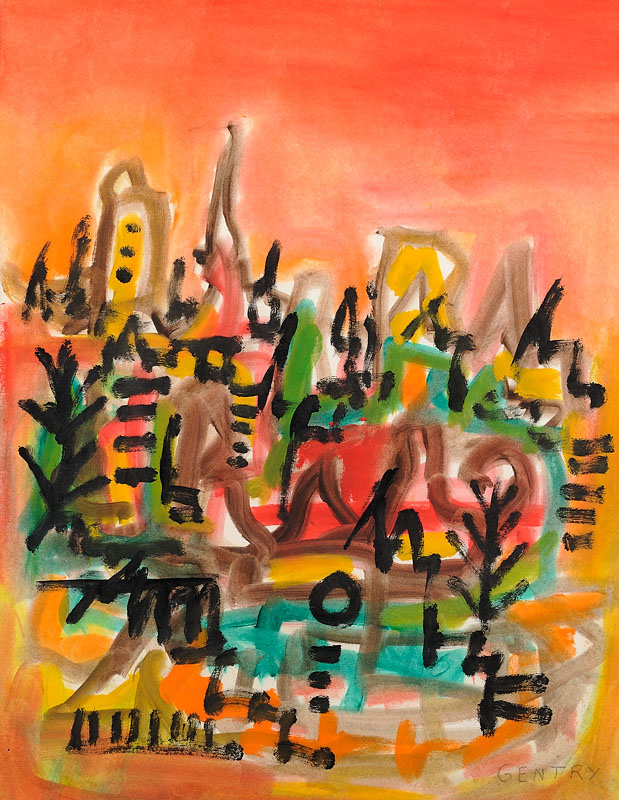
Untitled (Abstraction)
Oil on board
21 1/2 x 16 1/4
Year unknown
Signed
Photo credit: John Wilson White Studio
Sam Gilliam (b.1932)
Sam Gilliam (born November 30, 1933) is a Color Field painter and lyrical abstractionist artist. Gilliam, an African American, is associated with the Washington Color School,[1] a group of Washington, D.C. artists that developed a form of abstract art from color field painting in the 1950s and 1960s. His works have also been described as belonging to Abstract Expressionism and Lyrical Abstraction. He works on stretched, draped and wrapped canvas, and adds sculptural 3D elements. He is recognized as the first artist to introduce the idea of a draped, painted canvas hanging without stretcher bars around 1965, which was a major contribution to the Color Field School.[2]
In his more recent work, Gilliam has worked with polypropylene, computer generated imaging, metallic and iridescent acrylics, handmade paper, aluminum, steel, plywood and plastic.[3]
Sam Gilliam was born in Tupelo, Mississippi, the seventh of eight children born to Sam and Estery Gilliam. The Gilliams moved to Louisville, Kentucky, shortly after Sam was born. His father worked on the railroad, and his mother cared for the large family. As a child, Gilliam recalled wanted to be a cartoonist.[4] In 1951, Gilliam graduated from Central High School in Louisville. He received his bachelor's (1951) and master's degree (1961) of Fine Arts at the University of Louisville. In 1955, Gilliam had his first solo exhibition at the University of Louisville. Gilliam also served in the United States Army from 1956 to 1958. Gilliam also taught art in public schools.[5] In 1962, Gilliam moved to Washington, D.C. where he has lived ever since.[6]
In the 1960s, as the political and social front of America began to explode in all directions, the black artist began to take bold declarative initiatives, making definitive imagery, inspired by the specific conditions of the African American experience. Abstraction remained a critical issue for artists like Sam Gilliam. Gilliam's sense of color is modulated by his study of light, color, and its transformative and changing dynamics. He is most widely known for the large color-stained canvases he draped and suspended from the walls and ceilings during the late 1960s and early 1970s.[7] Gilliam's early style developed from brooding figural abstractions into large paintings of flatly applied color, pushing Gilliam to eventually remove the easel aspect of painting by eliminating the stretcher.
Gilliam was influenced by German Expressionists such as Emil Nolde, Paul Klee and the American Bay Area Figurative School artist Nathan Oliveira. Early influences included Morris Louis and Kenneth Noland. He states that he found lots of clues on how to go about his work from Tatlin, Frank Stella, Hans Hofmann, Georges Braque, Pablo Picasso, and Paul Cézanne. In 1963, Thomas Downing, an artist who identified himself with the Washington Color School, introduced Gilliam to this new school of thought. Around 1965, Gilliam became the first painter to introduce the idea of the unsupported canvas. He was inspired to do this by observing laundry hanging outside his Washington studio. His drape paintings were suspended from ceilings, arranged on walls or floors, representing a sculptural, third dimension in painting. Gilliam states that his paintings are based on the fact that the framework of the painting is in real space. He is attracted to its power and the way it functions. Gilliam's draped canvases change in each environment they are arranged in and frequently he embellishes the works with metal, rocks, and wooden beams.
In 1975, Gilliam veered away from the draped canvases and became influenced by jazz musicians such as Miles Davis and John Coltrane. He started producing dynamic geometric collages, which he called "Black Paintings" due to the hue. Again, in the 1980s Gilliam's style changed dramatically to quilted paintings reminiscent of African patchwork quilts from his childhood. His most recent works are textured paintings that incorporate metal forms. Gilliam's ability to move beyond the draped canvas, coupled with his ability to adopt new series keeps the viewers interested and engaged. This has assured his prominence in the art world as an exciting and innovative contemporary painter.
Gilliam taught for nearly a decade in the Washington public schools, and then at the Maryland Institute College of Art, and the University of Maryland, and for several years at Carnegie Mellon University in Pittsburgh, Pa. In addition, Gilliam still devotes time to conducting workshops, participating in panels, and delivering lectures in this country and abroad.
He has had many commissions, grants, awards, exhibitions and honorary doctorates. A major retrospective of Gilliam's work was held at the Corcoran Gallery of Art in 2005. He was named the 2006 University of Louisville Alumnus of the Year.
In 1987 he was selected by the Smithsonian Art Collectors Program to produce a print to celebrate the opening of the S. Dillon Ripley Center in the National Mall. He donated his talent to produce In Celebration, a 35-color limited-edition serigraph that highlighted his trademark use of color, and the sale of which benefitted the Smithsonian Associates, the continuing education branch of the larger Smithsonian Institution.[8] In early 2009, he again donated his talents to the Smithsonian Associates to produce a 90-color serigraph entitled Museum Moment, which he describes as "a celebration of art" [9]
In April 2003, a dedication of the installation of his work, "Matrix Red-Matrix Blue", was held at Rutgers Law School - Newark.[10]
In May 2011, his work From a Model to a Rainbow was installed in the Metro Underpass at 4th and Cedar, NW.[11]
In 2016, Gilliam was commissioned for a piece as part of the grand opening of the National Museum of African American History and Culture (NMAAHC).[12]
Sam Gilliam will be participating in the 2017 Venice Biennale, Viva Arte Viva, May 13 - November 16, 2017.[13]
In 1962, he married Dorothy Butler, a Louisville native and the first African-American female columnist at the The Washington Post. They divorced in the 1980s. His partner of more than 30 years, Annie Gawlak, owns the G Fine Art gallery in Washington DC.[14] Gilliam lives in Washington D.C. and has a studio on 14th Street, NW, just north of Colorado Avenue.
Bio courtesy of Wikipidia. Link to full bio https://en.wikipedia.org/wiki/Sam_Gilliam

Untitled (Lithograph)
21x26 inches
1971
Signed and dated
Photo credit: John Wilson White Studio
Rex Gorleigh (1902-1986)
Rex Goreleigh was born in Penllyn, PA, where he took to art as a way of coping with a speech impediment which he had since he was a child. He then moved to Philadelphia at the age of 15, when his mother died. A year later, he left for Washington DC, to attend high school there. In 1920, Goreleigh attended a series of displays of African-American art at the Harmon Foundation exhibition in New York. Seeing the exhibition inspired him to learn how to paint and draw, in the off time of his day job of waiting tables.
Thirteen years later, Goreleigh waited a table for the prominent Mexican muralist, Diego Rivera, who gave Goreleigh the opportunity to watch him work on portraits meant for Rockefeller Center. In 1934, under the WPA, Goreleigh met and worked with Ben Shahn, another popular artist. Until 1936, he studied art in Europe, and upon returning to America, he taught in both Harlem and established an art center in Greensboro, North Carolina. Alongside Norman Lewis, the pair worked in Chicago as well, in art centers in southern Chicago. Goreleigh moved to Princeton in 1947, and directed Princeton Group Arts for another 6 years. He died in 1986.
Relation to Princeton
Bio courtesy of www.nassauchurch.org. Link to full bio: http://nassauchurch.org/about/princetoncemetery/cemetery-bios/cemetery-bio06/

The Mourners
Oil on canvas
27x32 inches
1960
Signed
Photo credit: John Wilson White Studio

The Red Barn
Oil on canvas
18x22 inches
1945
Signed
Photo credit: John Wilson White Studio
Joseph Grey II (b. 1927)
JOSEPH E . GREY II (1927 - ) Raised in rural Ohio, Grey earned a masters degree from the Columbus College of Art and Design . His career as a painter peaked in 1958 when he won the prestigious Emily Lowe painting competition in New York, the year after Hughie Lee-Smith . His 1958 watercolor Bull and Fighter is illustrated in Cedric Dover's American Negro Art . Grey then went on to pursue a career in advertising, and was an award-winning art director for over 40 years . Grey's watercolors have also been shown extensively with the National Watercolor Society .
Bio courtesy of www.worthpoint.com. Link to bio:
https://www.worthpoint.com/worthopedia/african-american-artist-joseph-grey-485271772

Untitled (Self Portrait)
Oil on canvas
22x27 inches
1954
Signed
Photo credit: John Wilson White Studio

Untitled (Houses)
Oil on canvas
22x27 Inches
c. 1954
Signed
Photo credit: John Wilson White Studio
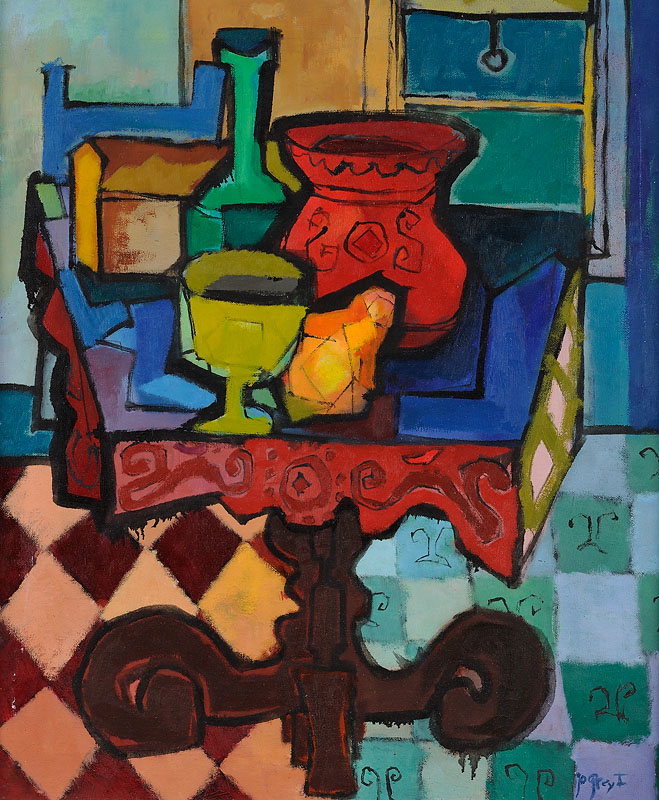
Untitled (Still Life)
Oil on canvas
17x16 inches
1954
Signed
Oliver Wendell Harrington (1912-1995)
Oliver Wendell "Ollie" Harrington (February 14, 1912 – November 2, 1995) was an American cartoonist and an outspoken advocate against racism and for civil rights in the United States. Of multi-ethnic descent, Langston Hughescalled him "America's greatest African-American cartoonist".[1] Harrington requested political asylum in East Germany in 1961; he lived in Berlin for the last three decades of his life.
Born to Herbert and Euzsenie Turat Harrington in Valhalla, New York, Harrington was the oldest of five children. He began cartooning to vent his frustrations about a viciously racist sixth grade teacher and graduated from DeWitt Clinton High School in 1929. Immersing himself in the Harlem Renaissance, Harrington found employment when Ted Poston, city editor for the Amsterdam News became aware of Harrington's already considerable skills as a cartoonist and political satirist.
In 1935, Harrington created Dark Laughter, a regular single panel cartoon, for that publication. The strip was later retitled Bootsie, after its most famous character, an ordinary African American dealing with racism in the U.S. Harrington described him as "a jolly, rather well-fed but soulful character." During this period, Harrington enrolled in Fine Arts at Yale University to complete his degree, but could not finish because of the United States entry into World War II.
On October 18, 1941, he started publication of Jive Gray (1941–1951), a weekly adventure comic strip about an eponymous African-American aviator; the strip went on until Harrington moved to Paris.
During World War II, the Pittsburgh Courier sent Harrington as a correspondent to Europe and North Africa. In Italy, he met Walter White, executive secretary of the NAACP. After the war, White hired Harrington to develop the organization's public relations department, where he became a visible and outspoken advocate for civil rights.
In that capacity, Harrington published "Terror in Tennessee," a controversial expose of increased lynching violence in the post-W.W. II South. Given the publicity garnered by his sensational critique, Harrington was invited to debate with U.S. Attorney General Tom C. Clark on the topic of "The Struggle for Justice as a World Force." He confronted Clark for the U.S. government's failure to curb lynching and other racially motivated violence.
In 1947 Harrington left the NAACP and returned to cartooning. In the postwar period his prominence and social activism brought him scrutiny from the Federal Bureau of Investigation and the House Un-American Activities Committee. Hoping to avoid further government scrutiny, Harrington moved to Paris in 1951. In Paris, Harrington joined a thriving community of African-American expatriate writers and artists, including James Baldwin, Chester Himes, and Richard Wright, who became a close friend.
Harrington was shaken by Wright's death in 1960, suspecting that he was assassinated. He thought that the American embassy had a deliberate campaign of harassment directed toward the expatriates. In 1961 he requested political asylum in East Germany.[2] He spent the rest of his life in East Berlin, finding plentiful work and a cult following. He illustrated and contributed to publications such as Eulenspiegel, Das Magazine, and the Daily Worker.
Bio courtesy of Wikipidia. Link to full bio: https://en.wikipedia.org/wiki/Ollie_Harrington
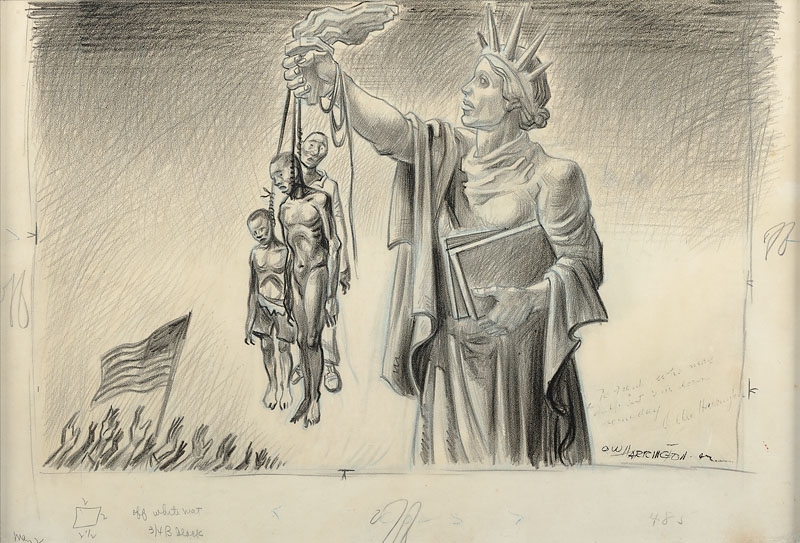
Statue of "Liberty"
Pencil and crayon on paper
13x19 1/2 inches
1942
Signed
Photo credit: John Wilson White Studio
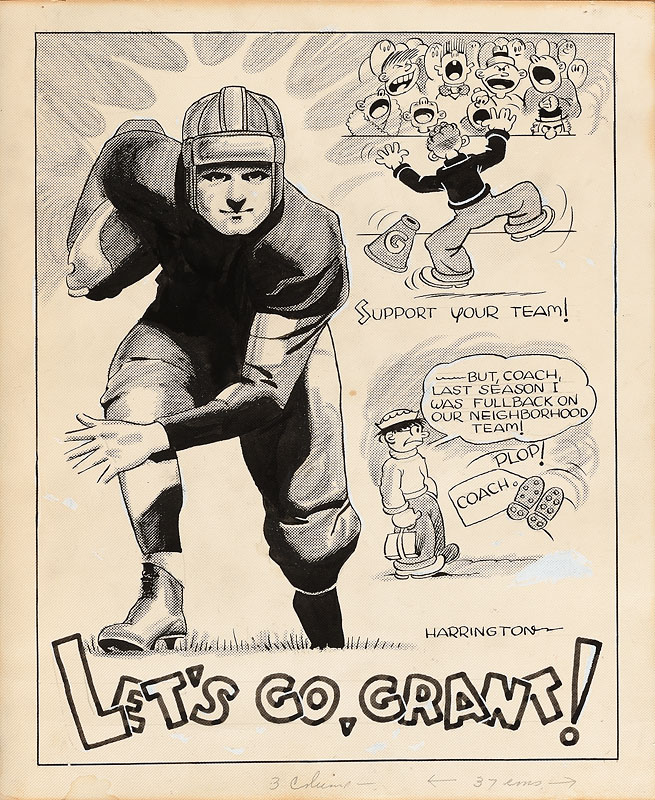
Lets Go Giant
Reproduction technique with hand retouching
15x3/4x12 1/4 inches
c. 1940
Signed
Photo credit: John Wilson White Studio
Palmer Hayden (1890-1973)
Palmer C. Hayden (January 15, 1890 – February 18, 1973) was an American painter who depicted African-American life, landscapes, seascapes, and African influences. He sketched, painted in both oils and watercolors, and was a prolific artist of his era.
Born Peyton Cole Hedgeman[1] on January 15, 1890, in Widewater, Virginia, Palmer C. Hayden drew during his childhood, and was introduced into the arts by his older brother who drew as well. (Speculations regarding how many other siblings he had exist, but cannot be proved.) Despite his early interest in art, Hayden's initial ambition was to become a fiddle player, but several obstacles prevented this, two of which were his demure nature and the financial hardships of his family. In reflection years into his seniority, Hayden stated he still continued to regret not following his initial ambition, unwavered by his success as an artist. This conflict is reflected at times in his art; in particular, Midnight at the Crossroads is a personal painting that depicts the decision he was forced to make. Interestingly, the explicit tilt of his feet and face in the direction of the musician's path, yet his ultimate descent down the path of the artist signifies just how powerful of a conflict this was for Hayden.
As an adolescent, Hayden relocated to Washington, D.C. in order to find work, where he became a porter and an errand boy. The subject of his sketches shifted to objects and activities he witnessed daily, such as sailboats and fishermen. It was in Washington, D.C. where Hayden ultimately began to pursue an art career, and where he first encountered an experience with explicit racism. Hayden had placed an ad in the local paper for an artist’s assistant, and was bewildered when he was rejected for being African-American upon arriving at the interview. Discouraged, Hayden decided to go into employment as a laborer for the Buffalo Bill Circus and then the Ringling Brothers Circus. He bounced from occupation to occupation with little commitment, then decided to enter the army's black company stationed in the Philippines. Hayden in the army.
During his army service, Hayden was stripped of his birth name and was given the name Palmer Hayden instead by a commanding sergeant during World War I. The justification behind this abrupt decision is speculated but ultimately unknown, and two popular theories have emerged within the community of art historian; one theory is employed in Bearden and Henderson's book A History of African American Artists: 1792 to the Present, in which the story follows Hayden asking for a letter of reference from his previous job but having his name mistakenly written as Palmer Hayden instead of Peyton Hedgeman.[2] Unwilling to ask for another letter that correctly identified him, he took the letter and adopted the name Palmer Hayden as he transitioned into the army. The alternate theory is stated in Driskell's Harlem Renaissance: Art of Black America, where it is claimed his commanding sergeant mispronounced his real name, giving him the name Palmer Hayden instead.[3]Despite the modern dispute, it has been factually determined that he thereafter referred to himself as Palmer Hayden and eventually legally changed his name a decade later. Within the army, he found himself pleased with the amount of spare time he had and even found a tutor in second lieutenant Arthur Boetscher, who enjoyed map drawing and would often loosely instruct Hayden. This marked Hayden's first real encounter with any form of artistic education. After four years of participation, Hayden decided to enlist again and this time, was assigned to the 10th Cavalry at West Point. While he was not a cadet, his role was taking care and training the horses that the cadets learned to ride on. At this time, he also enrolled himself in a correspondence drawing course, on which he spent $10 monthly out of the $18 he made monthly.
After he was discharged from the army, he relocated to Greenwich Village, a neighborhood located in lower Manhattan within New York City. During the pursuit of his slowly developing art career, he worked as a postal clerk, janitor, and a variety of other part-time jobs in order to provide for himself. This period of his life was disheartening, but was justified when Hayden eventually became a prolific Harlem artist of his era.[2]
Hayden pursued artistic professionalism by studying charcoal drawing at Columbia University as he simultaneously worked nights at the post office. While this initially satisfied him, he later determined that his night job ate up more of his time than he liked, so he quit and began janitorial services in various apartment buildings throughout New York City. Coincidentally, the first tenant he worked for was Victor Perard, an artist and art instructor at the Cooper Union, previously called the Cooper Institute. Hayden was hired to clean Perard's studio and was encouraged to continue to develop his art.
Hayden eventually decided to pursue a formal education, and studied at the Cooper Union in New York City, Columbia University, and privately with Perard, practicing independent studies at Boothbay Art Colony in Maine during the summers as well. A chance encounter with Alice Dike, a woman for whom he was moving furniture, lead to the discussion of art and his experience as an artist. Compelled by his cause, Dike provided him with a brochure from her church broadcasting The Harmon Foundation's Award for Distinguished Achievement, which encouraged individuals to participate and enter their pieces. Hayden decided to enter and in 1926, he won a sum of money and a gold medal for his painting Schooners after being recognized as the recipient of the Distinguished Achievement in Visual Arts in the Harmon Foundation's first awards ceremony.[4] In response to this honor, a New York Times headline crudely glorified him, stating “Negro Worker Wins Harmon Art Prizes: Gold Medal and $400 Awarded to Man who Washes Windows to Have Time to Paint", suggesting his employment and race were defining factors of his craft as opposed to his extensive efforts.[4] While racially involved themes were not quite yet prominent concepts in Hayden's work, The Harmon Foundation's white founder William E. Harmon was nonetheless making a blatant social statement by publicly praising art created by an African-American man from a struggling background. The award is additionally credited for launching his career as an artist because of how prestigious of an accomplishment it was seen for anyone, but especially for a simple janitor.[5]
Hayden's success with The Harmon Foundation allowed the existence of his premier solo show in April 1926 at the Civic Club. Following his achievements, Hayden combined accumulated funds, as well as his trophy money from The Harmon Foundation and a gracious gift of $3,000 from Dike, to travel to Paris, France, where he found further inspiration for his art. He did not enroll in art school there but the next five years spent in Paris were productive regardless, and Hayden captured not only Parisian society, but also the integration of Afro-European into the upscale environment. He was mentored for a short while by an artist named Clivette Le Fevre, but ultimately, the relationship ended because of Le Fevre's disbelief in Hayden's talents. Hayden's years in Paris, as well as his arguably primitive style, is particularly evident in the 1930 piece Nous Quatre a Paris, which portrays four black men in a cafe, drawn with stereotypically large lips and cartoonish facial features to emphasize characteristically black features that were shunned and often seen as revolting, as a result of the discourse from white beauty.
While in France, Hayden did not remain stationed in Paris and also traveled to the coasts in order to continue painting landscapes and seascapes. He was particularly fond of Concarneau, a small village primarily sustained by fishermen, and painted several scenes of the town, one of which being Concarneau - Andrée de la Mer. He also visited several museums and a variety of exhibits, such as the Louvre, and found inspiration within its walls. Hayden became acquainted with philosopher Alain Locke, who showed him African art he had collected from his extensive travels. Hayden's admiration for African art led him to paintings depicting African designs, patterns, and forms, such as Fetiche et Fleurs in 1933. He was also fascinated by the establishment of colonial Northern African towns and sketched what he saw in museums and exhibits.
After five years abroad, traveling with funds borrowed from the American Aid Society of Paris, a non-profit organization meant to support Americans abroad, Hayden decided to return to the United States on August 11, 1932. He remained in New York City, where he had lived before going abroad, and upon his return, he became a Works Progress Administration artist with an impressive salary of about $30 weekly.
In contrast to his active involvement with African culture and racism abroad, Hayden painted mostly buildings and landscapes at this time. In his free time, he continued with oil and watercolor paintings, but also dabbled in pen and ink drawings. His artwork is most notable for depicting African-American life during the Harlem Renaissance, as well as racial conflicts/obstacles, perceptions of racism, and African folklore. His paintings have been described by some critics as primitive and demeaning for depicting xenophobic stereotypes of African Americans by exaggerating bosoms, lips, and nostrils and portraying the mass consumption of watermelonand other foods associated with black racism, such as in The Watermelon Race. Other art historians find some of the earliest indications of black empowerment in Hayden's work for his ownership and embracement of defining stereotypes that he regurgitated at critics through their exaggerated impact. A great number of his paintings following his years in Paris were associated with the Harlem Renaissance and black urban life in the city. However, while depictions of African-American life are what he is most remembered for, they are not his sole claim to fame; Hayden's career began with landscape portrayal and this continued simultaneously alongside his racially influenced art, with nature originally more prominent than the depictions of African-American life.[6] A particular interest of his was seascapes and life in bustling harbors, as it had been in his adolescence. These particular scenes often held a religious significance for him, which was not further elaborated on by Hayden. Additionally, as his comfort within the artistic community grew, he offered a political voice in his paintings, and in 1935, he depicted The Execution of NIRA, which referenced the Supreme Court's refusal of the National Industrial Recovery Act on the grounds of unconstitutionality. Hayden branching out artistically became more evident as his work became more outspoken and experimental.
One of Hayden's most prolific works came in 1937, when he created the iconic alleged narrative The Janitor Who Paints. This painting, labeled a protest painting à la The Execution of NIRA, was thought by critics to be a personal commentary on Hayden's sentiments regarding the assorted, meagerly paid early jobs he had to take in order to survive that he was criticized for in the press. Despite his success and popularity not only in America, but also in Europe, Hayden was still regarded by some as an lowly janitor who had little to no artistic training and worth. In this painting, an African-American woman, man, and child are depicted in a crowded area which is made even more stifled by a canvas, cleaning supplies, and simple home decoration. All three are shown with thick, prominent lips, characteristic of caricatures of African people, and in the first draft, a bold portrait of Abraham Lincoln was hung on the wall. The title of the painting, as well as the contrast of cleaning supplies and art material, imply a balance, such as the one that existed in Hayden's own life before he was recognized for his work. Inevitably, Hayden was scrutinized by both the black and white community as problematic for seemingly endorsing negative stereotypes in this painting as well.
Ten years after his initial visit in 1926, Hayden returned to Paris briefly; little else is known about this visit. He was back in New York within a year and at the age of 50, he married Miriam Huffman. He decided in 1944 to begin a new project, which resulted in a three-year effort that culminated his most fulfilling works: The John Henry series.[7] The idea was rooted in a legend he had been told in childhood by his father and he took to researching the legitimacy of the folktale, drawing inspiration to integrate into his art. Any other explanations for why Hayden felt so strongly about John Henry and the series as a whole are unclear and unspecified, but are most likely linked to his proud ties to the African-American community.
In his elder years, Hayden continued to be active with his art, regularly being selected for prestigious awards and traveling between Paris and the United States to fuel his inspiration.[8] Racism remained a relevant topic in his life and art, leading him to publicly speak out against racist policies hindering the African-American and Hispanic communities. An example of this was seen in 1966, when Hayden wrote to William Booth, the Chairman of the City Commission on Human Rights, regarding the advocacy for an equal number of African Americans, Latinos, and white people on the board to prevent mistreatment fueled by prejudice and power.
Hayden died on February 18, 1973, shortly after receiving a grant to depict Negro soldiers between the world wars.
Bio courtesy of Wikipidia. Link to full bio: https://en.wikipedia.org/wiki/Palmer_Hayden
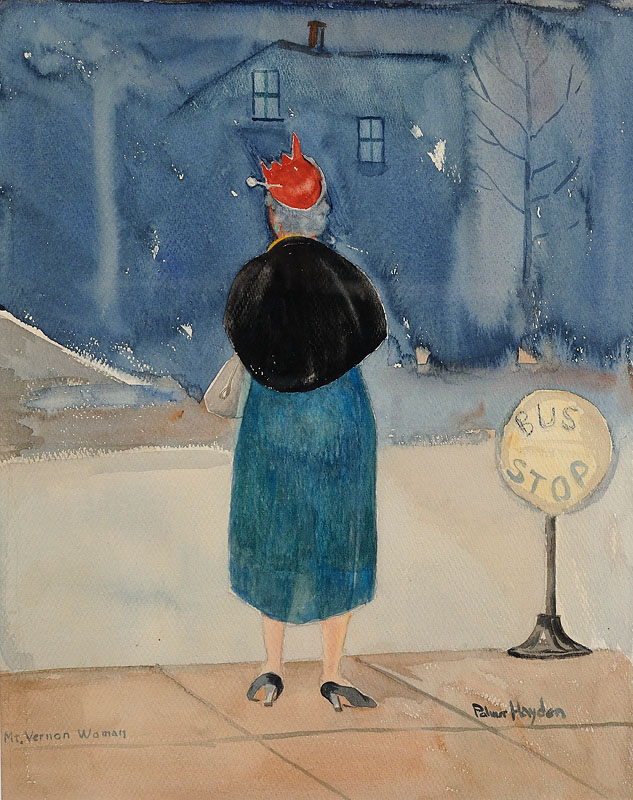
Mt. Vernon Woman
Watercolor
16 1/2x13 1/2 inches
1950
Signed
James Herring (1887-1969)
James Vernon Herring was an influential American artist and teacher in the early twentieth century. He played an integral role in devising new ways by which art would be viewed from both academic and commercial standpoints. He was also an important figure in the promotion of works of little known African American artists.
A native of Clio, South Carolina, James Herring studied at Syracuse, Columbia, and Harvard Universities. Upon graduation from Harvard, he became an instructor at Howard University in Washington, D.C. in 1921. One year later he founded the Art Department and served as mentor to artists/art historians James A. Porter and David C. Driskell. In 1930, Herring organized the art gallery at Howard, a first of its kind in two regards: it was the only gallery on a historically black university campus (HBCU) and it was the gallery to be directed and controlled by African Americans. While curating the gallery, Herring also served as chair of the Howard University’s art department for 21 years.
Herring, the artist, was trained in the tradition that artistic renderings should be relatively realistic. He was, however, also was capable of embracing newer artistic trends and was particularly influence by FrenchImpressionism. Although first introduced in Paris in the 1870s, by the early twentieth century Impressionism was rapidly gaining popularity among U.S. artists, art critics, and art consumers.
Herring’s own works reflect that change. His Campus Landscape (1922) employed a gentle Impressionist lighting technique as he portrayed university students near the reservoir at the Howard University campus. Another example was his Newport Scene, painted sometime in the 1920s. This work was an image of sailboats against the coastline in the distance under hazy light and reflection evocative of French Impressionism.
In 1943, Herring, along with Alonzo J. Aden, a former student and colleague, opened the Barnett-Aden Gallery in their home in Washington, D.C. Though the gallery’s prime focus was to collect and display African American art, it also collected works by non-black artists to emphasize the need to integrate the public presentation of art without the barrier of race. The Barnett-Aden Gallery became the first gallery to display the works of contemporary white and black artists side-by-side, emphasizing their artistic similarities rather than their racial differences.
The Barnett-Aden Gallery became an incredibly important resource to black artists because it gave them a platform from which various audiences from a variety of backgrounds could view and discuss their work. Besides integrating the work of black and white artists, the gallery purposely presented the works of relatively unknown painters alongside those of established, prominent artists.
The Gallery soon became the most prominent meeting place in Washington, D.C. for individuals of all walks of life to congregate. Writers, musicians, other artists, art patrons and public figures of all races mingled and interacted at the gallery at the time Washington was still an otherwise racially segregated city. The choice to have the gallery in a private residence also lent a sense of intimacy usually missing from more formal and impersonal galleries.
James V. Herring managed the Barnett-Aden Gallery for 25 years until his passing in 1969.
Sources:
Janet Gail Abbott, “The Barnett Aden Gallery: A home for diversity in a segregated city” (2013), retrieved from Udini: http://udini.proquest.com/view/the-barnett-aden-gallery-a-home-for-goid:304495536/; University of Maryland, “Artist Biographies” (2002), retrieved from Narratives of African American Art and Identity:http://www.driskellcenter.umd.edu/narratives/exhibition/artists/bio.htm#herr.
Bio courtesy of : www.blackpast.org. Link to full bio: http://www.blackpast.org/aah/herring-james-v-1887-1969

Museum Interior
Oil on board
12x10 inches
Year unknown
Signed
Photo credit: John Wilson White Studio
Leon Hicks (b.1933)
Leon Hicks- Since the sixties, Mr. Hicks has distinguished himself as an artist and educator. He emerged during the Black Arts Movement of the 1960s, producing powerful images rooted in self-discovery and social consciousness. By the late 1970s, he was preoccupied with autonomous form and giving his full attention to investigating the language of engraving. Since the 1980s, elegant abstractions born out of his deep interest in computer graphics theory, namely Generative Aesthetics, have held his attention. Throughout, Mr. Hicks has remained a committed student of art history, learning and mastering engraving techniques pioneered by giants like Albrecht Dürer (1471-1528), Rembrandt Harmenszoon van Rijin (1606-1669), and Mauricio Lasansky (b.1914), with whom he studied at the State University of Iowa. Prints created by Mr. Hicks over the past five decades are, at once, aesthetically beautiful, conceptually complex and inextricably grounded in the traditions of the medium.
.The 1960s also mark the start of Hicks’ teaching career. He assumed his first post in 1964 at Florida A&M University, where he taught for a year. From 1965, he taught for three years at Concord College (now University) in Athens, West Virginia. He spent three years at Lincoln University, in Jefferson City, Missouri and four years at Lehigh University in Bethlehem, Pennsylvania. Mr. Hicks joined the faculty at Webster University in Webster Grove, Missouri in 1974 and remained there for 25 years until his retirement to Florida in 1999. He remans active today as an artist, teacher, lecturer and inventor. Mr. Hicks is currently a professor emeritus in the Art Department at Webster University and an adjunct instructor at Florida A & M. He has presented engraving workshops and served in artist residences at Illinois State University (Normal, IL), Carleton College (Northfield, MN), Jackson State University (Jackson, MS), the University of Missouri (Columbia, MO) and other places to numerous to mention here.
.Mr. Hicks has exhibited widely in solo and group shows throughout the United States and around the world. His prints were featured in the Pacific States Biennial (University of Hawaii), Made by Hand III – Prints & Artists’ Books (Minneapolis College of Art and Design), and the Brandywine Workshop Collection: Mali, West Africa and Fourteen African Nations (Florida A & M University). Prints by Mr. Hicks were also included in Impressional Expressions: Black American Graphics (Smithsonian Institution, The Studio Museum in Harlem) and at the United States Embassy Art Exhibition in Ankara, Turkey.
.Several public and private collections across the United States permanently house his work. The University of Florida, the 7UP Company, The Oakland Art Museum, Atlanta University, Southwestern Bell Corporation, and the Charleston Art Gallery have his works in their collections. They can also be found in the collections of the Tuskegee Institute, Brandywine Graphic Workshop, Albrecht Art Museum and the Library of Congress. Fisk University Galleries includes among its permanent holdings Hicks’s dazzling Virtualscape installation, which is made up of 31 large copper plate burin engravings, including the largest engraving of this type in the world.
.He has been given numerous awards and honors. Mr. Hicks received the Missouri Arts Award in 2000 and was awarded the Elizabeth Catlett Mora Award of Excellence in 1978. He is also the recipient of two NEH Grants (1969, 1974) and other honors too numerous to mention here. Fisk University Galleries,1000 17th Avenue North, Nashville, TN, 37208, (615) 329-8720, www.galleries@fisk.edu
.His works have been discussed and reviewed widely. It is included in Directions of African-American Art, Herbert F. Johnson Museum (Ithaca, New York) and Prints by American Negro Artists (Cultural Exchange Center of Los Angeles). Similarly, critical essays on his work can be found in Black Artists on Art (Samella Lewis and Ruth Waddy, authors), Art News, The New Art Examiner, and in American Artists: A Bio-Bibliographical Directory (editor Theresa Dickinson/ Holm Cedar).
Mr. Hicks graduated with the B.S. degree in painting and sculpture from Kansas State University. He earned the M.A. in painting and the M.F.A degree in printmaking from the State University of Iowa. He also studied art history at Stanford University (Paolo Alto, CA), La Romita School of Art (Italy), and at Atlanta University (Atlanta, GA).
Bio courtesy of www.nashvillearts.com. Link to full bio: http://nashvillearts.com/2011/03/leon-hicks-the-ingenious-line-at-fisk-university/

Black Boy
Etching
18x10 inches
1961
Signed, dated, titled, and inscribed ("Studio Proof")
Photo credit: John Wilson White Studio
Geoffrey Holder (1930-2014)
Geoffrey Lamont Holder (August 1, 1930 – October 5, 2014) was a Trinidadian-American actor, voice actor, dancer, choreographer, singer, director and painter.[1] He was known for his height (6 ft 6 in, 1.98 m), "hearty laugh", and heavily accented bass voice[2] combined with precise diction. He is particularly remembered as the villain Baron Samedi in the 1973 Bond-movie Live and Let Die and for his 7 Up commercials of the 1970s and '80s.
Holder was born in Port of Spain, Trinidad. One of four children,[3] of parents who had emigrated to Trinidad from Barbados,[4] Holder attended Tranquillity School and then secondary school at Queen's Royal College in Port of Spain. At the age of seven, he made his debut in the dance company of his elder brother Boscoe Holder, from whom he had been receiving lessons in dancing and painting.[1]
In 1952, choreographer Agnes de Mille saw Geoffrey Holder dance in St. Thomas.[1][5] She invited him to New York; he would teach at the Katherine Dunham School of Dance for two years.[6]
Holder was a principal dancer with the Metropolitan Opera Ballet in New York City from 1955 to 1956.[7] He made his Broadway debut in House of Flowers, a musical by Harold Arlen (music and lyrics) and Truman Capote (lyrics and book).[8] He also starred in an all-black production of Waiting for Godot in 1957.[8]
Holder began his movie career in the 1962 British film All Night Long, a modern remake of Shakespeare's Othello. He followed that with Doctor Dolittle (1967) as Willie Shakespeare, leader of the natives of Sea-Star Island. In 1972, he was cast as the Sorcerer in Everything You Always Wanted to Know About Sex*. The following year he was a henchman – Baron Samedi – in the Bond-movie Live and Let Die.[3] He contributed to the film's choreography.
In addition to his movie appearances, Holder became a spokesman for the 1970s and 1980s 7 Up soft drink "uncola" and 1980s "crisp and clean, and no caffeine" and "never had it, never will" advertising campaigns.[9][10]
In 1975, Holder won two Tony Awards for direction and costume design of The Wiz, the all-black musical version of The Wizard of Oz. Holder was the first black man to be nominated in either category.[2] He won the Drama Desk Award for Outstanding Costume Design. The show ran for 1672 performances.[11]
As a choreographer, Holder created dance pieces for many companies, including the Alvin Ailey American Dance Theater, for which he provided choreography, music, and costumes for Prodigal Prince (1967),[12] and the Dance Theatre of Harlem, for which he provided choreography, music, and costumes for Dougla (1974), and designed costumes for Firebird (1982). In 1978, Holder directed and choreographed the Broadway musical Timbuktu![1][13][14][15] Holder's 1957 piece "Bele" is part of the Dance Theater of Harlem repertory.[1]
In the 1982 film Annie, Holder played the role of Punjab. He was in the 1992 film Boomerang with Eddie Murphy. He was also the voice of Ray in Bear in the Big Blue House and provided narration for Tim Burton's version of Roald Dahl's Charlie and the Chocolate Factory. He reprised his role as the 7 Up Spokesman in the 2011 season finale of The Celebrity Apprentice, where he appeared as himself in a commercial for "7 Up Retro" for Marlee Matlin's team.[16]
Holder was a prolific painter (patrons of his art included Lena Horne and William F. Buckley, Jr.),[17] ardent art collector, book author, and music composer. As a painter, he won a Guggenheim Fellowship[15] in fine arts in 1956.[18] A book of his photography, Adam, was published by Viking Press in 1986.[19]
In 1955, Holder married dancer Carmen de Lavallade, whom he met when both were in the cast of the musical House of Flowers.[2] They lived in New York City and had one son, Léo. They were the subject of a 2004 film, Carmen & Geoffrey.[5] His elder brother Boscoe Holder was a renowned dancer, choreographer, and artist. His nephew was Christian Holder (Boscoe's son), who has also won acclaim as a dancer, choreographer, and entertainer.
Geoffrey Holder died in Manhattan of complications from pneumonia on October 5, 2014, aged 84. His immediate survivors were his wife, Carmen, and their son Léo.[4
Abbreviated bio courtesy of Wikipidia. Link to full bio:
https://en.wikipedia.org/wiki/Geoffrey_Holder

Man and Woman
Oil on canvas
51x31 inches
c. 1970
Unsigned
Exhibited in 2001 at the Frederick Weisman Gallery, Pepperdine University, Malibu, CA.
Photo credit: John Wilson White Studio
Raymond Howell (1931-2002)
Raymond Howell, American (1931 - 2002)
Raymond Howell began painting when there was little public interest in African American art, and he tried during his lifetime to serve as a role model for artists in bringing images of African American culture to a larger public. He was especially committed to promoting arts education opportunities for minority children.
Raymond Howell's paintings are based in realism, with eclectic influences of surrealism and impressionism. In recent years he has experimented with collage, mural painting and printmaking and has created series of works on such subject matter as jazz musicians who were innovators in their art form. An artist whose work focuses on African Americans, Howell describes himself as a role model for artists who have traditionally been reluctant to paint African American subjects.
Howell has been a longtime fixture in the Bay Area art scene. In the mid-1960s he opened Art Associates West, a gallery and art school in San Francisco's Haight-Ashbury district, which operated for nearly a decade. Howell's 1965 painting "The Brown Family" was shown at the opening of the Oakland Museum, and was later purchased for the museum collection. His work has been exhibited widely throughout the United States, and in 1999 Stanford University presented a 40-year retrospective of his paintings.
Jan. 6 has been declared Raymond Howell Day in Oakland, and San Francisco celebrates Raymond Howell Day on Sept. 7th (his birthday).
Bio courtesy of www.rogallery.com. Link to bio: http://rogallery.com/Howell_Raymond/howell-bio.htm

Untitled
Oil on masonite board
44x22 inches
c. 2000
Signed
Photo credit: John Wilson White Studio
Earlie Hudnall Jr. (b.1946)
Earlie Hudnall Jr, born in Hattiesburg, Mississippi, has lived in Houston, Texas since the early 1970s. After two years in the Marine corps from 1966 – 1968, Earlie enrolled at Texas Southern University where he received a BA in Art Education.
He has been actively photographing for almost thirty years and his photographs have been part of numerous exhibitions, including Free Within Ourselves: African American Art in the Collection of the National Museum of American Art, Washington, DC; and a solo show, Project Galveston: Earlie Hudnall Jr. and the Children of the Galveston Housing Authority. His images are in many fine collections – The Museum of Fine Arts, Houston, TX; The National Museum of Art, Smithsonian Institution, Washington, DC; and the Harry Ransom Humanities Research Center, University of Texas at Austin.
Hudnall is the university photographer for Texas Southern University and is on the executive boards of the Houston Center for Photography and the Texas Photographic Society.
"I chose the camera as a tool to document different aspects of life: who we are, what we do, how we live, what our communities look like. Various patterns are interwoven like a quilt into important patterns of history. A unique commonality exists between young and old because there is always a continuity between the past and the future.
The camera really does not matter – it’s still just a tool. What is important to me is the ability to transform an instant – a moment – into a meaningful, expressive, and profound statement – some personal, some symbolic, and some universal. My photographs are archetypes of my own childhood. They represent a literal transciption of actuality – the equivalent of what I saw or felt. The viewer can accept the image as one’s own and respond emotionally and aesthetically to the captured image."
Bio courtesy of www.cpw.org. Link to bio: http://www.cpw.org/artists/earlie-hudnall-jr/

Hip Hop Galveston
Photograph (Silver Gelatin Print)
18 1/2x15 inches
1993
Signed
Photo credit: John Wilson White Studio
George Hunt
George Hunt was born more than 60 years ago of humble beginnings, and over a lifetime of living, learning, watching, growing, creating and translating his visions into paintings, he has emerged as one of the most important African-American artist in the South. George Hunt has made a significant mark on not just African-American art, but American art as a whole.
Memphis artist George Hunt was born in rural Louisiana, near Lake Charles, and his grandmother noted early in life that he had a special power to “see things.” In addition to large doses of indigenous music, one of the things he saw was the civil rights movement and that experience became a painting in 1997, which in turn, became a US Postage Stamp issued in 2005 as part of the United States Postal Service series, “To Form A More Perfect Nation.”
George Hunt was honored for his painting, “America Cares/Little Rock Nine” at ceremonies in Little Rock and Memphis. The paint was originally commissioned for the Central High School Museum, but first spent five years hanging in the White House in Washington, D.C. First Lady, Hillary Clinton, in a personal note to Mr. Hunt, wrote, “we are grateful that our visitors and staff have such a powerful image of hope and freedom to greet, inspire and inform them.”
In 2002, the U.S. Congress brought attention to America’s indigenous music by officially declaring 2003 as the “Year of the Blues.” George Hunt was named the Official Artist for the “Year of the Blues,” and he created a new body of work for a national tour. The exhibit, ‘Conjurating the Blues, The High Cotton Tour,” consisted of 26 large paintings that depicted the history of blues music in America. The title painting proudly hung in the grand lobby of Radio City Music Hall in New York during the opening tribute show for the Year of the Blues as Martin Scorcese filmed the documentary movie, “Lightnin’ in a Bottle.” The exhibit continued on to Seattle at Experience Music Project, Chicago, Memphis, Helena, AR (King Biscuit Festival) and Clarksdale, MS (Delta Blues Museum.)
George Hunt appeared at great length in many segments of the 13-part “Year of the Blues” PBS radio series telling vivid stories of his experience with blues music, rooted deep in the rural south. Later in 2003, the Blues Foundation bestowed a coveted “Keeping the Blues Alive” award on George.
George Hunt spent his childhood in Texas and Hot Springs, Arkansas. After high school, Hunt attended college at the University of Arkansas, Pine Bluff on a football scholarship and studied art as a career. He did postgraduate studies at the University of Memphis and at New York University. Mr. Hunt spent three decades teaching art education and coaching at George Washington Carver High School in Memphis before dedicating full time to painting. He now works in a studio overlooking world-famous Beale Street.
Ninety-nine percent of what George Hunt paints come from the Southern African-American experience, especially the folk tradition, civil rights movement, the mythic heroism of Black manhood, and of course blues music and culture. His mother-in-law owned a jukejoint in Helena, Arkansas called the Dreamland Cafe. There, George Hunt listened to blues legends like Sonny Boy Williamson and watched the patrons dance, drink, eat catfish, court, sport and score. The visions for George Hunt's art have been steeped in the music and life passages of blues people.
George Hunt’s name and images have become synonymous with The Memphis In May Beale Street Music Festival. For 15 years, he has been selected to paint an original blues image for the festival posters, which have become valuable collectors items.
In 2005, Hunt was honored by being selected as the artist for the New Orleans Jazz and Heritage Festival Congo Square poster. He was given a special exhibit during the festival at Stella Jones Gallery and was honored with an exhibit at the Ogden Museum.
His work has become definitive images for posters and promotion of many other blues festivals around the country including Chicago Blues Festival, Telluride Blues Festival, the Ultimate Rhythm & Blues Cruise, and the Arkansas Blues Festival. Hunt was selected to create a painting for the 25th Anniversary of the Blues Foundation’s prestigious Handy Awards.
The Memphis Chapter of The Garden Club of America selected George Hunt in 2004 as the featured artist for its highly competitive and prestigious national floral arranging competition held at Dixon Museum Gallery and Gardens in Memphis. Teams from around the country studied Hunt’s work for over a year, then imported both familiar and exotic flower from the western hemisphere and around the globe in an attempt to match the vibrant colors and unique forms in his paintings.
Mr. Hunt’s work has been exhibited in both individual and group shows nationally, and it is part of the permanent collections of museums as well private collectors such as Steve Wynn, Anthony Quinn, Eddie Murphy, Steven Seagal, Justin Timberlake and David Simmons. He has been featured and written about in many publications including an Ebony Magazine feature in 2005. Hunt is represented by LongRiver Entertainment Group, Memphis, Tennessee.
Bio courtesy of www.blackartinamerica.com link to full bio: http://blackartinamerica.com/profiles/blogs/artist-george-hunt

I Am a Man, No. 2
Serigraph
50x24 inches
2006
Copyright 2006, Edition 185, signed
Photo credit: John Wilson White Studio
Clementine Hunter (1886-1988)
Clementine Hunter (pronounced Clementeen) (late December 1886 or early January 1887 – January 1, 1988) was a self-taught black folk artist from the Cane River region of the U.S. state of Louisiana, who lived and worked on Melrose Plantation. She is the first African-American artist to have a solo exhibition at the present-day New Orleans Museum of Art.
Hunter was born into a Louisiana Creole family at Hidden Hill Plantation, near Cloutierville, in Natchitoches Parish, Louisiana; she started working as a farm laborer when young, never learning to read or write. In her fifties, she began painting, using brushes and paints left by an artist who visited Melrose Plantation, where she then lived and worked. Hunter's artwork depicted plantation life in the early 20th century, documenting a bygone era. She sold her first paintings for as little as 25 cents. By the end of her life, Hunter's work was being exhibited in museums and sold by dealers for thousands of dollars. Hunter was granted an honorary Doctor of Fine Arts degree by Northwestern State University of Louisiana in 1986. In 2013, director Robert Wilson presented a new opera about her: Zinnias: the Life of Clementine Hunter, at Montclair State University in New Jersey.[1]
Born either in late December 1886 or early January 1887 Born about 1886, two decades after the end of the American Civil War, Hunter's grandparents were enslaved.[2] She was the eldest of seven children of Creole parents[3] at Hidden Hill Plantation, near Cloutierville[4] in Natchitoches Parish, Louisiana. Hunter's given name was originally Clemence, but she changed it after moving to Melrose Plantation.[3] Her mother was Antoinette Adams (d. 1905) and her father was Janvier (John) Reuben (d. ca. 1910), a field hand.[3] Her parents were married on October 15, 1890. Her maternal grandparents were named Idole, who was formerly enslaved, and Billy Zack Adams. Her paternal grandfather was "an old Irishman" and her grandmother, "a black Indian lady called 'MeMe'" (pronounced May–May).[3]
Hidden Hill was known as a harsh place to live and work, and local accounts say it was the inspiration for Uncle Tom's Cabin.[3][4] It is now known as Little Eva's Plantation.
At the age of 15, Hunter moved to Melrose Plantation[3] south of Natchitoches. She spent much of her life picking cotton and attended school for only 10 days, never learning to read or write.[4]
Her first two children, Joseph (Frenchie) and Cora, were fathered by Charlie Dupree, whom Hunter said she did not marry.[3] Dupree died around 1914. Later she married Emmanuel Hunter, a woodchopper at Melrose, in 1924.[3] The two lived and worked at Melrose Plantation for many years. Hunter worked as a field hand in her early years and as a cook and housekeeper[5] beginning in the late 1920s.[3] Hunter bore seven children, two stillborn. On the morning before giving birth to one of her children, she picked 78 pounds of cotton, went home and called for the midwife. She was back picking cotton a few days later.[3] Hunter lived her entire life in rural, northwest Louisiana, never going more than 100 miles from home.[3]
Hunter was self-taught.[6] Melrose Plantation became a mecca for the arts under the guidance of its owner, Cammie Henry.[7] Numerous artists and writers visited, including Lyle Saxon, Roark Bradford, Alexander Woollcott, Rose Franken, Gwen Bristow, and Richard Avedon.[3] Brushes and discarded tubes of paint[2] left by New Orleans artist Alberta Kinsey[7] after a 1939 visit to Melrose Plantation, were used by Hunter to "mark a picture" on a window shade,[8] beginning her career as an artist.
Hunter gained support from numerous individuals associated with Melrose Plantation, including François Mignon, plantation curator.[4] He supplied her with paint and materials, and promoted her widely.[3] and James Register. With Mignon's help, Hunter's paintings were displayed in the local drugstore, where they were sold for one dollar.[3] In her later years, Hunter co-authored "Melrose Plantation Cookbook" with Mignon.
On the outside of the unpainted cabin where she lived was a sign that read, "Clementine Hunter, Artist. 25 cents to Look."[3] She produced between four and five thousand paintings in her lifetime.[9]
Hunter has become one of the most well-known self-taught artists, often referred to as the black Grandma Moses.[4] Painting from memory,[2][4] she is credited as an important social and cultural historian for her documentation of plantation life in the early 20th century. Her paintings portray picking cotton[10] and pecans, washing clothes, baptisms, and funerals.[3][7] Many of her paintings had similar subjects,[2] but each one is unique.[3] Hunter was noted for painting on anything, particularly discarded items such as window shades, jugs, bottles, and gourds[3] and cardboard boxes. Her paintings rarely run larger than 18 by 24 inches.
Her work has generally been considered uneven, with her work from the 1940s to 1960 considered to be the best. It is admired for its palette and expressive force. She also produced a few quilts with themes similar to those expressed in her paintings.[3]
Though she became a respected artist and is today considered a folk art legend, Hunter spent her entire life in (or near) poverty. In the 1940s, she sold her paintings for as little as a quarter.[2][4] By the 1970s, she was charging hundreds of dollars for a painting.[3]By the time of her death, her work was being sold by dealers for thousands of dollars.[8] Hunter rarely titled her works, but when asked a title, would describe the subject of the painting.[3]
One of the more well-known displays of Hunter's artwork is located in a food storage building called "African House" on the grounds of Melrose Plantation. (African House is often referred to as slave quarters, however the building was built for, and always used for food storage.) The walls are covered in a mural Hunter painted in 1955, depicting scenes of Cane River plantation life.[11]When she completed the mural, a local newspaper ran the headline: "A 20th Century Woman of Color Finishes a Story Begun 200 Years Ago by an 18th Century Congo-Born Slave Girl, Marie-Therese, the original grantee of Melrose Plantation."[citation needed]Melrose Plantation was owned by a Louisiana Creole family for generations.
An article was published about Hunter in Look magazine in June 1953, giving her national exposure.[4] A biography, Clementine Hunter: Cane River Artist (2012), was co-written by Tom Whitehead, a retired journalism professor who knew Hunter well.[5] A director of the Museum of American Folk Art in Washington, D.C. described Hunter as "the most celebrated of all Southern contemporary painters."[4]
Hunter was the first African-American artist to have a solo exhibition at the Delgado Museum (now the New Orleans Museum of Art). She achieved significant recognition during her lifetime, including an invitation to the White House from U.S. President Jimmy Carter and letters from both President Ronald Reagan and U.S. Senator J. Bennett Johnston, Jr..
Radcliffe College included Hunter in its Black Women Oral History Project, published in 1980.[3] Northwestern State University of Louisiana granted her an honorary Doctor of Fine Arts degree in 1986. The following year, Louisiana governor Edwin Edwards designated her as an honorary colonel, a state honor, and aide-de-camp.[3]
Hunter has been the subject of biographies and artist studies, and inspired other works of art. In 2013 composer Robert Wilson presented a new opera about her: Zinnias: the Life of Clementine Hunter, at Montclair State University in New Jersey
Bio courtesy of Wikipedia. Link to full bio: https://en.wikipedia.org/wiki/Clementine_Hunter
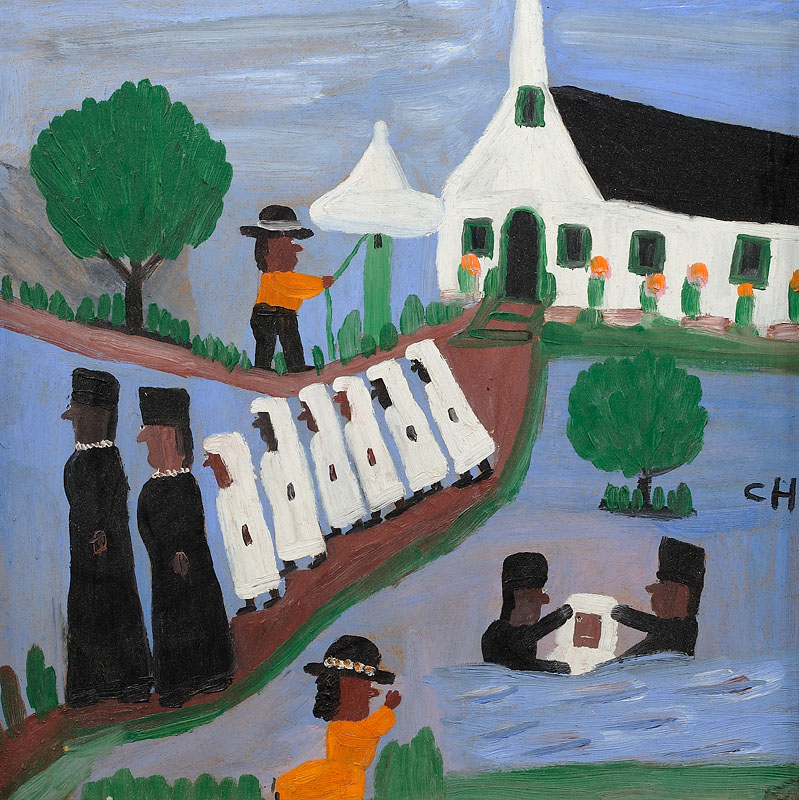
Baptism
Oil on board
15 1/2X19 1/2 inches
c. 1950
Signed
Photo credit: John Wilson White Studio

Burial
Oil on board
16x20 inches
c. 1955
Signed
Photo credit: John Wilson White Studio

Cotton Pickers
Oil on board
14x14 inches
c. 1950
Photo credit: John Wilson White Studio
Arnold Hurley (b.1944)
Arnold Hurley
Images on paper and canvas have been part of Arnold J. Hurley’s life since childhood. He fondly remembers the influences of his mother and an uncle, who both were creative and were sources of encouragement to him. As his interest in art grew, his mother provided creative inspiration, his father provided art supplies and his high school teacher steered him along a path toward developing painting and drawing skills. His budding artistic skills led Mr. Hurley to enroll at Tufts University where he earned both a Bachelor’s Degree in Education and a Master’s Degree in Fine Arts, with a major in painting. His skills helped him land a Ford Foundation grant in 1964 to attend the School of the Museum of Fine Arts in Boston. A native of Boston, Mr. Hurley taught painting for 12 years at several area colleges and museums including Emerson College and the School of the Museum of Fine Arts in Boston, Fitchburg Art Museum, Lowell University, Milton Academy, Boston Public Schools and Wesleyan University in Connecticut. He currently teaches art at Crossland High School in Prince George’s County, Maryland. Mr. Hurley’s approach to painting involves a realistic or representational style and his works vary from still life drawings to portraiture. He paints every day and follows this precept: “Never forget the basics—they will serve as the foundation throughout your creative life. Challenge yourself, and remember your art will change and grow. And always draw, draw and draw some more.” Mr. Hurley has earned more than 40 awards for his oil, watercolor and pastel paintings and his pencil drawings. These include the 1998 Robert Dodge Memorial Prize, the 1993 Laurel Art Guild Award and the Prince George’s Juried Annual Exhibition for three consecutive years. His work has also appeared in numerous national publications including Scholastic Art Magazine Inc., as a 2003 Honoree at the National Awards ceremony at the Kennedy Center in Washington, D.C.
Bio courtesy of www.fineartamerica.com. Link to full bio: https://fineartamerica.com/profiles/arnold-hurley.html?tab=about

Broken Cup
Oil on canvas
20x24 inches
1982
Signed and dated
Bill Hutson (b.1936)
Bill Hutson
Born in San Marcos, Texas on September 6, 1936, Bill Hutson has devoted his career to exploring abstract expressionism in which the material used to create art becomes the art itself. Attracted to found objects, often benign in meaning and quotidian products of his own environment, Hutson seeks to create work that recontextualizes the materials and transforms their meaning.
With a keen attentiveness to tactile and planar inclinations, Hutson turns to the principles of architecture and construction; he creates textured surfaces that are inherent in his seemingly tactile work. Stemming from an early interest in the desire to know how things are made and dismantled, he utilizes these techniques in an effort to fulfill his mantra: “Don’t just paint, build the painting.”
Prior to settling in Lancaster, Pennsylvania, Hutson forged lasting relationships with artists in the communities where he has lived. These include England, France, The Netherlands, Italy, Nigeria, Senegal, India and other areas of the U.S. Bill Hutson currently serves as the Jennie Brown Cook and Betsy Hess Cook Distinguished Artist-in-Residence at Franklin & Marshall College in Lancaster, Pennsylvania.
It is through Hutson’s role as an active artist, educator and curator that we can continue the narrative around abstraction and the discussion about whether an “object looks real and is, or is not art.”
Bio courtesy of www.billhutson.com. Link to full bio: http://www.billhutson.com/about/
Gerald Jackson (b.1936)

Girl Holding Moon
Oil on canvas
50 1/4x50 1/4 inches
1969
Signed and dated
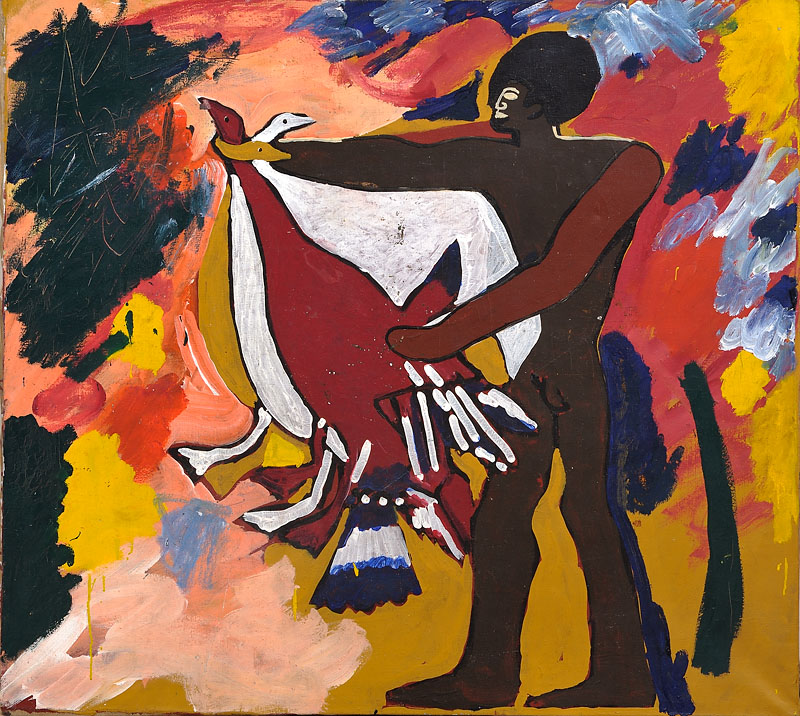

Daniel La Rue Johnson (1938-2017)
Daniel LaRue Johnson
Born in Los Angeles in 1938, African American painter, sculptor, printmaker Daniel LaRue Johnson studied at Chouinard and in Paris with Giacometti. He was closely associated with Los Angeles’s African American artist movement of the mid-20th century, which developed as a response to the country’s social, political, and economic changes. His varied body of work includes politically charged collages as well as meticulously rendered color abstractions.
In a review of the historic 2011 show "Now Dig This!", in which Johnson was prominently featured, the critic Christopher Knight noted “Daniel LaRue Johnson merged painting with assemblage, affixing fragments of a broken doll, a hacksaw, a mousetrap and rubber hose onto a large, black field of viscous, tar-like pitch. Made in the aftermath of Bull Connor's notorious Birmingham assault on peaceful civil rights marchers, Johnson injected a jolt of black social consciousness into the exalted status abstract artists then afforded to all-black paintings.”
Daniel LaRue Johnson initially exhibited in community venues, and later in academic settings or a few established Los Angeles galleries. In the fall of 1966 UCLA’s Dickson Art Center inaugurated its new building with the national exhibition "The Negro in American Art;" Daniel LaRue Johnson was a participant. Johnson’s artwork has enjoyed a rich exhibition history.
Johnson exhibited at the Whitney Museum of American Art, the Guggenheim Museum and the Museum of Modern Art, where his work is in the permanent collection.
Bio courtesy of www.peytonwright.com. Link to full bio: http://peytonwright.com/modern/artists/daniel-larue-johnson/

Abstract (From Emergence Series)
Oil on canvas
48x48 inches
1963
Signed and dated
Photo credit: John Wilson White Studio
Malvin Gray Johnson (1896-1934)

Over the Harlem Rooftops
Oil on canvas
16x12 inches
1928
Signed
Photo credit: John Wilson White Studio
Sargent Claude Johnson (1888-1967)
*The Holmes Collection of African American Art began with a Sargent Johnson piece (The Cat). Melvin recalled seeing pieces around town in San Francisco and went into a local gallery to inquire about how to purchase one of his works. The gallery owner said that Johnsons were so rare he may as well be looking for a Picasso. There are currently over 25 pieces by Sargent Johnson in the collection.
Sargent Claude Johnson (October 7, 1888 – October 10, 1967) was one of the first African-American artists working in California to achieve a national reputation.[1] He was known for Abstract Figurative and Early Modern styles. He was a painter, potter, ceramicist, printmaker, graphic artist, sculptor, and carver. He worked with a variety of media, including ceramics, clay, oil, stone, terra-cotta, watercolor, and wood.[2] He was in the Communist Party for most of his life.[1]
Sargent Johnson was the third of six children, born to a father of Swedish descent and mother of African-American and Cherokee ancestry. His father died in 1892, leaving the kids to be raised by their mother. In 1902, when his mother died, the boys of the family were sent to an orphanage in Worcester, Massachusetts and the girls to a Catholic school for African American and Native American girls in Pennsylvania. At a young age, Sargent and his siblings went to live with their uncle, Sherman Jackson Williams, and his wife, May Howard Jackson. May was a famous sculptor specializing in Negro themes, and she undoubtedly influenced Sargent Johnson at an early age. Some of his siblings did not identify themselves as African American, and chose to live as either Native Americans or Caucasians, though Sargent identified as African American.
Sargent Johnson began showing his work with the Harmon Foundation of New York in 1926. Through the foundation, known for its support of African-American art, he exhibited many of his pieces and became locally and then nationally known.[5] There was a total of 87 pieces displayed at the show and a $150 prize for most outstanding work went to Johnson, “showing a porcelain head of a Negro child, Pearl, and two drawings, one of which, Defiant, is massively constructed and as simple in its planes as is so much of the modern Mexican work."[6] He was usually not included in "American art” because of how his pieces ignored traditional western techniques and were inspired by foreign cultures, such as Mexican muralists Diego Rivera, José Clemente Orozco, David Alfaro Siqueiros and others.
In 1928, Johnson's award-winning artwork garnered him fame amongst artists in the Harlem Renaissance movement.
In the late 1930s, Sargent Johnson commissioned his work with the Federal Arts Project (FAP).[1] As a member of the bohemian San Francisco Bay community and influenced by the New Negro Movement, Sargent Johnson's early work focused on racial identity.
Johnson said, “It is the pure American Negro I am concerned with, aiming to show the natural beauty and dignity in that characteristic lip and that characteristic hair, bearing, and manner; and I wish to show that beauty not so much to the white man as to the Negro himself. Unless I can interest my race, I am sunk.”[3] According to Johnson, "Negroes are a colorful race; they call for an art as colorful as they can be made."[7]
Beginning in 1945, and continuing through 1965, Sargent Johnson made a number of trips to Oaxaca and Southern Mexico and started incorporating the people and culture, particularly archeology, into his work. Other subjects included African American figures, animals, and Native Americans.
On February 23, 2010, Swann Galleries auctioned Sargent Claude Johnson’s Untitled (Standing Woman), a painted terra cotta sculpture, c. 1933-35, for $52,800 - an auction record at the time for the artist. In 2009 the University of California, Berkeley unwittingly sold a work by Johnson for $164.63, that was later valued at more than a million dollars. The 22-foot carved redwood relief panel was eventually purchased by the Huntington Library and will be displayed in its new American wing.[8]
Bio courtesy of Wikipedia. Link to full bio: https://en.wikipedia.org/wiki/Sargent_Claude_Johnson

Misery
Terra-cotta
7x5x2 3/4 inches
1940
Photo credit: John Wilson White Studio

Singing Saints
Tempura on enamel
31 1/2x25 inches
1967
Signed and dated
Photo credit: John Wilson White Studio

Free Love (Sex in the 60's)
Enamel on steel
11x12 1/2 inches
c. 1950
Signed
Photo credit: John Wilson White Studio
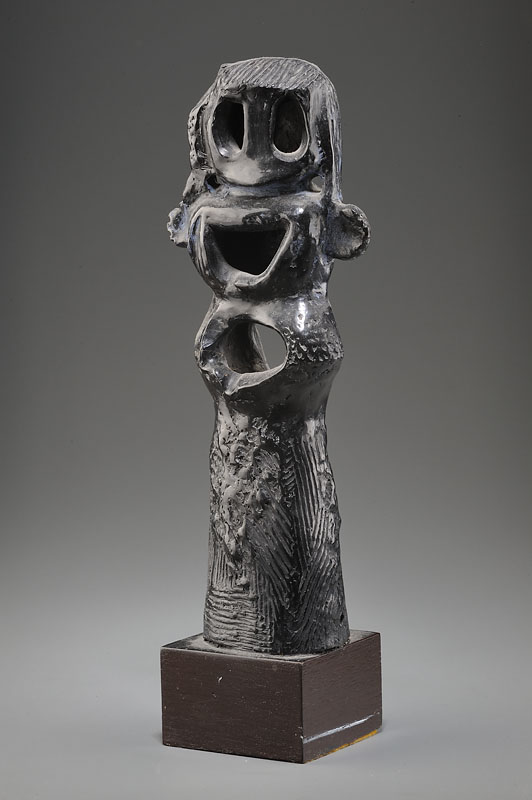

Sailing I
Enamel on steel
13 1/2 x 16 1/2 inches
c. 1950
Signed
Photo credit: John Wilson White Studio

Sailing II
Enamel on steel
11x13 1/2 inches
c. 1950
Signed
Photo credit: John Wilson White Studio

Untitled (Terracotta Figurine on Triangular Base)
Terracotta
8 3/4x2 3/8x3 inches
Year unknown
Signed
Photo credit: John Wilson White Studio

Female Egyptian Head
Terra-cotta on wooden base
4x2 1/2x4 inches
Year unknown
Signed
Photo credit: John Wilson White Studio

Teapot
Ceramic
4x2 1/2 x4 inches
1941
Signed
Photo credit: John Wilson White Studio
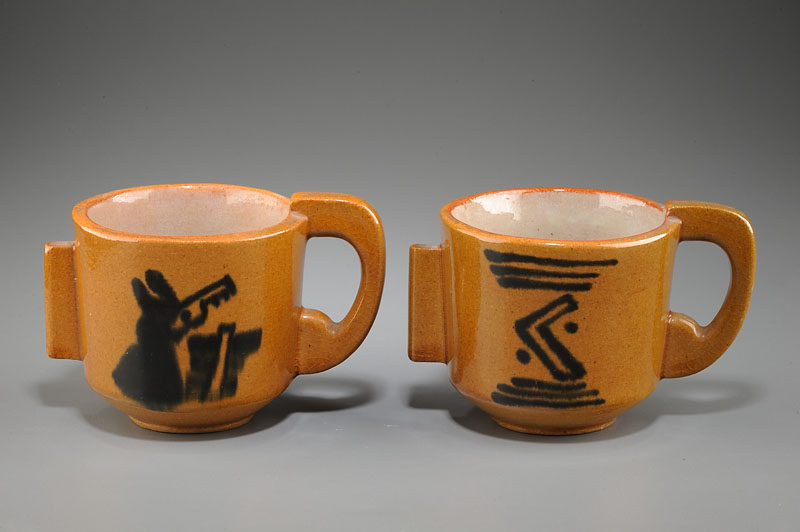
Teacups
Ceramic
2 1/2x4 1/4x2 1/2 inches (each)
1941
Signed and dated
Photo credit: John Wilson White Studio

The Cat
Terra-cotta
5 3/4X16 X4 1/2
1945
Photo credit: John Wilson White Studio

Girl with Braids
Bronze
12 x 7/8 x 4 x 2 inches
1945
Signed
Photo credit: John Wilson White Studio

The Lovers
Terra-cotta
5 1/4 x 6 3/8 x 2 1/2 inches
1945
Photo credit: John Wilson White Studio
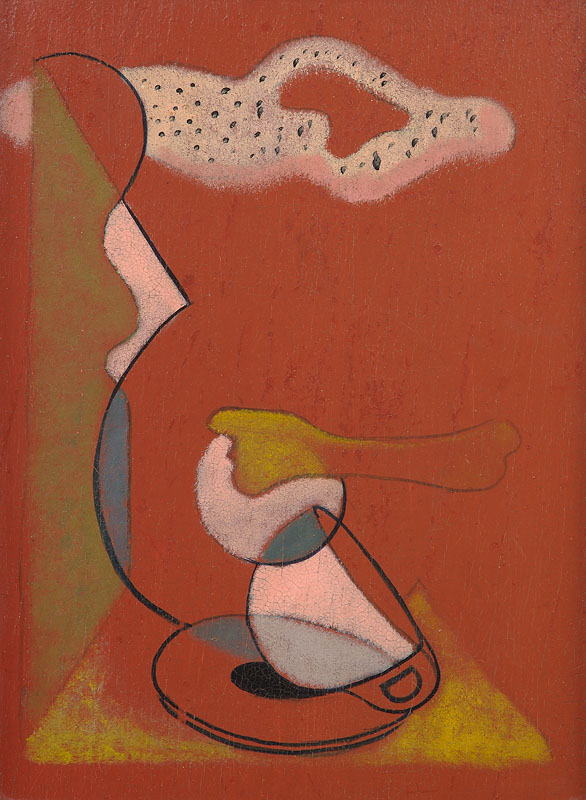
Breakfast
Oil on board
16x11 1/2 inches
1945
Letter of authenticity is attached to the back
Photo credit: John Wilson White Studio

Seduction
Enamel on steel
11 1/2 x 13 1/2 inches
1950
Signed
Photo credit: John Wilson White Studio

Rock Sculpture
Stone
8 1/4 x 9 x 6 inches
1955
Photo credit: John Wilson Whites Studio

Jesus Raising Lazarus from the Dead
Terra cotta bass relief
4 1/2 x 4 1/4 x 2 inches
1963
Inscribed: "The Paul and Irma Desch from Sargent Johnson 1963"
Photo credit: John Wilson White Studio

Mother and Child
9 1/4 x 3 3/4 x 1 3/8 inches
c. 1950
Signed
Photo credit: John Wilson White Studio
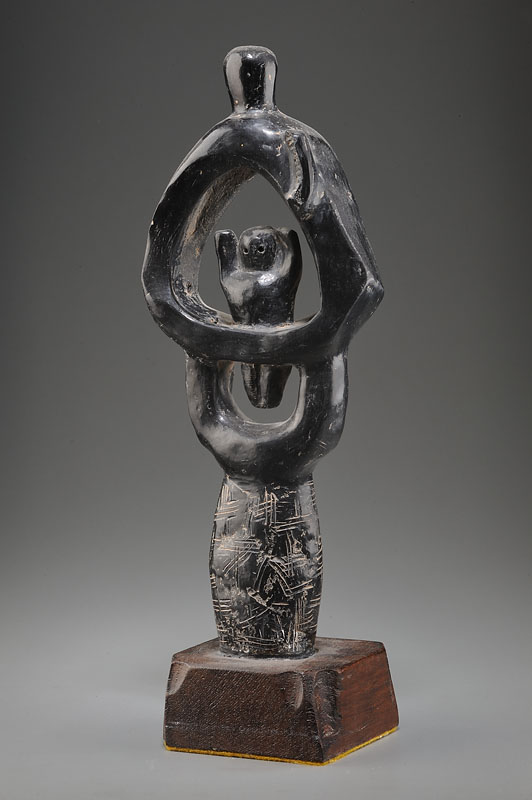


Crucifixion
Mixed media assemblage
26x19x1 inches
Year unknown
Photo credit: John Wilson White Studio

Untitled (Abstract Enamel on Copper)
Enamel on copper
9x12 inches
c. 1950
Signed
Photo credit: John Wilson White Studio

Singing Saints
Lithograph
12x9 1/2 inches
1940
Signed and titled
Photo credit: John Wilson White Studio
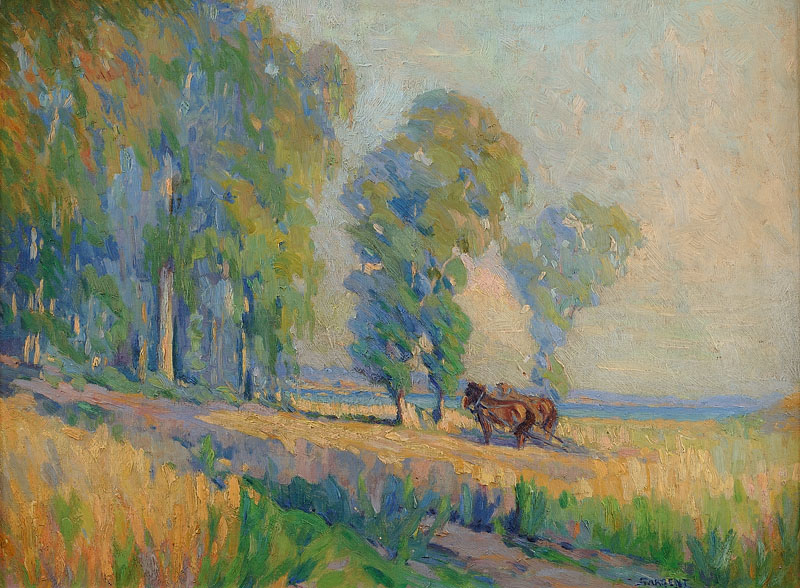
Plow Horses by a Grove of Trees
Oil on board
23x17 1/2 inches
c. 1940
Signed
Photo credit: John Wilson White Studio
William H. Johnson (1901-1970)
William Henry Johnson (March 18, 1901 – April 13, 1970) was an African-American painter born in Florence, South Carolina. He became a student at the National Academy of Design in New York City, working with Charles Webster Hawthorne. He later lived and worked in France, where he was exposed to modernism. After Johnson married Danish textile artist Holcha Krake, the couple lived for some time in Scandinavia. There he was influenced by the strong folk art tradition. The couple moved to the United States in 1938. Johnson eventually found work as a teacher at the Harlem Community Art Center, through the Federal Art Project.
Johnson's style evolved from realism to expressionism to a powerful folk style, for which he is best known. A substantial collection of his paintings, watercolors, and prints is held by the Smithsonian American Art Museum, which has organized and circulated major exhibitions of his works.
William Henry Johnson was born March 18, 1901, in Florence, South Carolina, to Henry Johnson and Alice Smoot.[3] He attended the first public school in Florence, the all-black Wilson School on Athens Street. It is likely that Johnson was introduced to sketching by one of his teachers, Louise Fordham Holmes, who sometimes included art in her curriculum.[4]:6 Johnson practiced drawing by copying the comic strips in the newspapers, and considered a career as a newspaper cartoonist.[4]:9[5]
He moved from Florence, South Carolina, to New York City at the age of 17. Working a variety of jobs, he saved enough money to pay for classes at the prestigious National Academy of Design.[4][6] He took a preparatory class with Charles Louis Hinton, then studied with Charles Courtney Curran and George Willoughby Maynard, all of whom emphasized classical portraiture and figure drawing. Beginning in 1923, Johnson worked with the painter Charles Webster Hawthorne, who emphasized the importance of color in painting. John studied with Hawthorne at the Cape Cod School of Art in Provincetown, Massachusettsduring the summers, paying for his tuition, food and lodging by working as a general handyman at the school.[4]:10–17 Johnson received a number of awards at the National Academy of Design, and applied for a coveted Pulitzer Travel Scholarship in his final year. When another student was given the award, Hawthorne raised nearly $1000 to enable Johnson to go abroad to study.[3][4]:21
Johnson arrived in Paris, France in the fall of 1927. He spent a year in Paris, and had his first solo exhibition at the Students and Artists Club in November 1927.[7] Next he moved to Cagnes-sur-Mer in the south of France, influenced by the work of expressionist painter Chaim Soutine.[4]:27–31 In France, Johnson learned about modernism.[8]
During this time, Johnson met the Danish textile artist Holcha Krake (April 6, 1885 – January 13, 1944).[9] Holcha was traveling with her sister Erna, who was also a painter, and Erna's husband, the expressionist sculptor Christoph Voll. Johnson was invited to join them on a tour of Corsica. Johnson and Holcha were deeply attracted in spite of differences in race, culture, and age.[4]:35–36
Johnson returned to the United States in 1929. Fellow artist George Luks encouraged Johnson to enter his work at the Harmon Foundation to be considered for the William E. Harmon Foundation Award for Distinguished Achievement Among Negroes in the Fine Arts Field. As a result, Johnson received the Harmon gold medal in the fine arts.[1][2] He was applauded as a "real modernist", "spontaneous, vigorous, firm, direct".[4]:41 Other winners of the fine art award include Palmer Hayden, May Howard Jackson and Laura Wheeler Waring.[4]:41
While in the United States, Johnson also visited his family in Florence, where he painted a considerable number of new works. He was apparently almost arrested while painting the Jacobia Hotel, a once-fashionable town landmark which had become a dilapidated house of ill-repute. Whether Johnson's actions or his choice of subject were at issue is unknown.[2][4]:51 During this visit, Johnson was able to publicly exhibit his paintings twice. The first occasion was at a meeting of the Florence County Teachers Institute on February 22, 1930. The second was at a local YMCA where Johnson's mother worked. Her boss, Bill Covington, arranged for Johnson to exhibit 135 of his paintings for a single afternoon, on April 15, 1930.[2] Although the Florence Morning News described Johnson condescendingly as a "humble ... Negro youth", it also stated that he had "real genius".[4]:51
Johnson returned to Europe in 1930 by working his way to France on a freighter. He went to Funen, a Danish island, to rejoin Holcha Krake. The couple signed a prenuptial agreement on May 28, 1930, and were married a few days later in the town of Kerteminde.[4]:55 Johnson and his wife spent most of the 1930s in Scandinavia, where his interest in folk art influenced his painting. However, as Nazi sentiments increased in Germany and Europe in the late 1930s, many artists were affected. Johnson's brother-in-law Christoph Voll was fired from his teaching position, and his art was labelled "degenerate". Johnson and Krake chose to move to the United States in 1938.[4]:117[8]
With the help of Mary Beattie Brady, Johnson eventually found work as a teacher at the Harlem Community Art Center. There he and other teachers instructed about 600 students per week, as part of a local Federal Art Project supported by the Works Progress Administration. Through the center Johnson met important Harlem inhabitants such as Henry Bannarn and Gwendolyn Knight.[4]:124 He immersed himself in African-American culture and traditions, producing paintings that were characterized by their folk art simplicity.[10]Johnson was determined to "paint his own people".[4]:123 He celebrated African American culture and imagery in the urban settings of pieces such as Street life - Harlem, Cafe, and Street Musicians, and in the rural settings of Farm Couple at Work, Sowing, and Going to Market. Harsher realities of Negro life were depicted in Chain Gang and Moon over Harlem, which was a response to the 1943 racial riots in New York. Another series of works showed war-time soldiers and nurses.[4]:123–180 Johnson held a solo exhibition at Alma Reed Galleries in 1941.[3] However, although he enjoyed a degree of success as an artist during the 1940s and 1950s, he was never able to achieve financial stability.[3]
On a personal level, the 1940s were difficult. Bad news came from Europe. Christoph Voll died in Karlsruhe, Germany, on June 16, 1939, after interrogation by Nazi officials. Holcha's family endured the German occupation of Denmark at their home in Odense.[4]:155In December 1942, Johnson and Krake moved to a larger studio apartment in Greenwich Village. A week later, Johnson's artwork, supplies, and personal possessions were destroyed when the building caught fire.[3][4]:170 On January 13, 1944, John suffered further loss when his wife Holcha died from breast cancer.[4]:181–182[9] To deal with his grief, he revisited his family in Florence, and painted works with religious themes, such as Mount Calvary.[4]:190–191 Mount Calvary and Booker T. Washington Legend(from Johnson's Fighters for Freedom series of 1945) were included in the show The Negro Artist Comes of Age: A National Survey of Contemporary American Artists at the Albany Institute of History and Art in 1945.[4]:200, 203
In 1946 Johnson left for Denmark to be with his wife's family. However, his behavior became increasingly erratic. At Ullevål Hospital in Oslo in spring 1947, he was diagnosed as suffering from syphilis which had impaired both mental and motor function. As a U.S. citizen who was no longer considered mentally competent, he was sent back to New York by the U.S. Embassy in Oslo. An attorney was appointed by the court as his legal guardian, and his belongings were put into storage. He entered the Central Islip State Hospital on Long Island on December 1, 1947, where he was treated for syphilis-induced paresis.[4]:219–220[11] He spent the last twenty-three years of his life there. He no longer painted after 1955 and died on April 13, 1970 of hemorrhaging of the pancreas.[4]:223, 227
In 1956, Johnson's life's work was almost destroyed when his caretaker declared him unable to pay further storage fees.[10][12] Instead, Helen Harriton, Mary Beattie Brady, and others arranged with the court to have Johnson's belongings delivered to the Harmon Foundation with unconditional rights over all works. The foundation would use the works to advance interracial understanding and support African American achievements in the fine arts. On April 19, 1967, the Harmon Foundation gave more than 1,000 paintings, watercolors, and prints by Johnson to the Smithsonian American Art Museum.[4]:223–225
In 1991, the Smithsonian American Art Museum organized and circulated a major exhibition of his artwork, Homecoming: The Art and Life of William H. Johnson,[13] and in 2006, they organized and circulated William H. Johnson's World on Paper.[14] An expanded version of this exhibition traveled to the Amon Carter Museum in Fort Worth, Texas,[15] the Philadelphia Museum of Art,[16] and the Montgomery Museum of Fine Arts in Montgomery, Alabama in 2007.[15]
The William H. Johnson Foundation for the Arts was established in 2001 in honor of the 100th birthday of William Johnson.[17]Beginning with Laylah Ali in 2002, the Foundation has awarded the William H. Johnson Prize annual to an early career African American artist.[18][19]
In 2012, the U.S. Postal Service issued a stamp in Johnson's honor, recognizing him as one of the nation's foremost African-American artists and a major figure in 20th-century American art. The stamp, the 11th in the "American Treasures" series, showcases his painting Flowers (1939–1940), which depicts brightly colored blooms on a small red table.[20]
Bio courtesy of Wikipedia. Link to full bio:
https://en.wikipedia.org/wiki/William_Johnson_(artist)
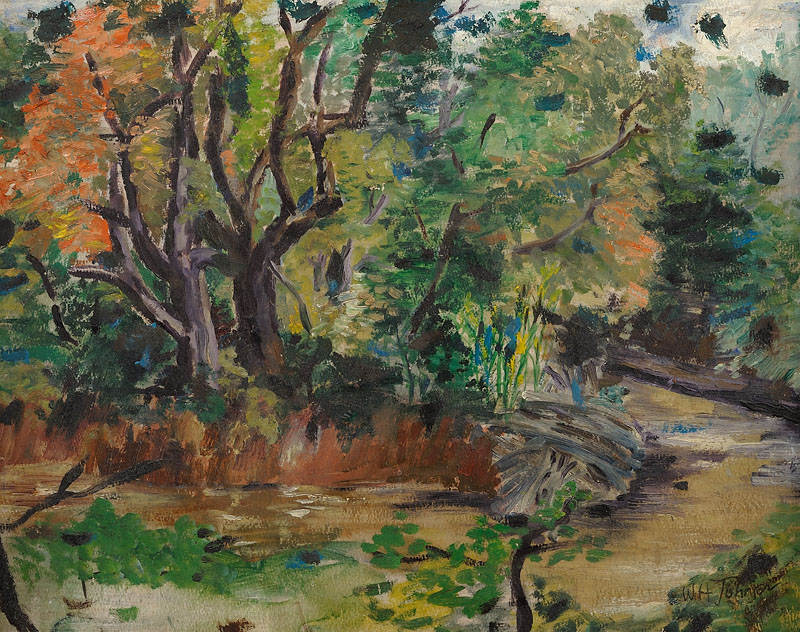
Untitled (Landscape)
Oil on board
17 1/2x22 1/2 inches
c. 1950
Signed
Photo credit: John Wilson White Studio
Frederick Jones (1913-2004)
Frederick Jones Jr. was an African American artist renown for his vibrant figure paintings. Jones is associated with the Social Realism movement popular during the times of the Works Progress Administration. His father was a pharmacist and owned his own store.
Eventually Jones would relocate to Chicago. He was working for a Coca Cola company and some owners and managers saw his work and took a shine to his personality. It was arranged for the artist to move to Chicago, and to attend the Art Institute of Chicago and have Coca Cola company pick up the bill.
In 1930 Jones was able to sell his first painting. He made $25 on the project and was thrilled. He received this great mentoring whilst still in high school.
Jones spent much of his career based out of Chicago and painted the legendary jazz musicians of the time including Louis Armstrong.
The artist was great friends with painter Hughie Lee Smith, also an African American painter working in a Surrealist manner.
Bio courtesy of www.diattaart.wordpress.com. Link to full bio:
https://diattaart.wordpress.com/tag/frederick-jones/

The Girl in the Yellow Dress
Oil on board
30x8 inches
Year unknown
Signed
Photo credit: John Wilson White Studio
Henry Bozeman Jones (1889-1973)

Autumn
Oil on canvas
24x30 inches
c. 1930
Signed
Photo credit: John Wilson White Studio
Lois M. Jones (1905-1998)
Loïs Mailou Jones (November 3, 1905 – June 9, 1998)[1] was an influential artist and teacher during her seven-decade career. Jones was the only African-American female painter of the 1930s and 1940s to achieve fame abroad.[citation needed] Her career began in textile design before she decided to focus on fine arts. Jones looked towards Africa and the Caribbean and her experiences in life when painting. As a result, her subjects were some of the first paintings by an African-American artist to extend beyond the realm of portraiture. Jones was influenced by the Harlem Renaissance movement and her countless international trips.Lois Mailou Jones' career was enduring and complex. Her work in designs, paintings, illustrations, and academia made her an exceptional artist that continues to receive national attention and research.
Lois Mailou Jones' work is in museums all over the world and valued by collectors. Her paintings grace the permanent collections of the Metropolitan Museum of Art, Smithsonian American Art Museum, Hirshhorn Museum and Sculpture Garden, National Portrait Gallery, Boston Museum of Fine Arts, the National Palace in Haiti, the National Museum of Afro-American Artists among others.
After her death, her friend and adviser, Dr. Chris Chapman completed a book about her life and the African-American pioneers she had worked with and been friends with, including Dr. Carter G. Woodson, Alain Locke, Dorothy West, Josephine Baker, and Matthew Henson. Entitled Lois Mailou Jones: A life in color, it is available through Xlibris and museum stores.[24]
The Lois Mailou Jones Pierre-Noel Trust founded a scholarship in her name at the Museum of Fine Arts, Boston and a scholarship fund for the Department of Fine Arts at Howard University.[1]
In 2006, Lois Mailou Jones: The Early Works: Paintings and Patterns 1927–1937 opened at the School of the Museum of Fine Arts, Boston. The exhibition showed thirty designs and paintings from the beginning of her career.[25]
From November 14, 2009, to February 29, 2010, a retrospective exhibit of her work entitled Lois Mailou Jones: A life in vibrant color was held at the Mint Museum of Artin Charlotte, North Carolina.[26] The traveling exhibit included 70 paintings showcasing her various styles and experiences: America, France, Haiti, and Africa.[27][18]
Jones is featured in a new publication, Identity Unknown: Rediscovering Seven American Women Artists.[28]
Bio courtesy of Wikipedia. Link to full bio: https://en.wikipedia.org/wiki/Lois_Mailou_Jones
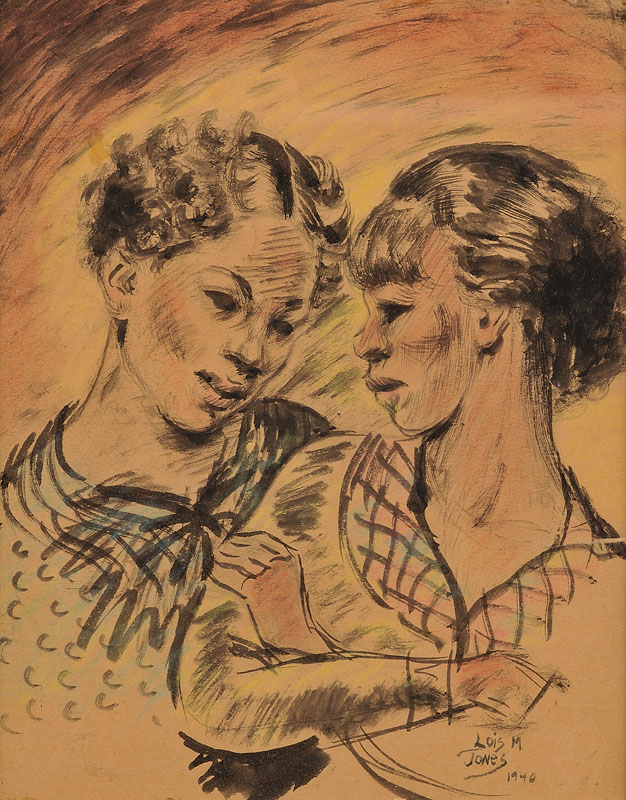
The Gossips
Ink, watercolor and wash on paper
13x10 inches
1940
Signed and dated
Photo credit: John Wilson White Studio
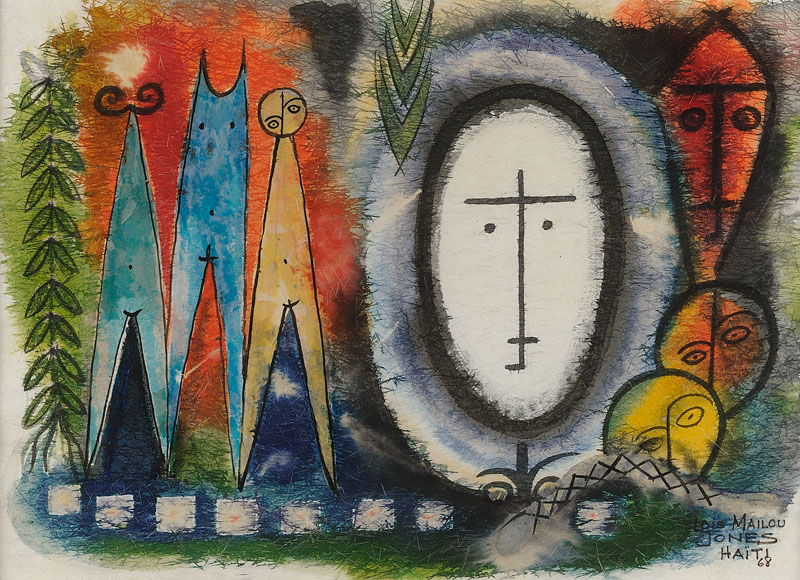
Haiti VouDou #4
Watercolor
22x30 inches
1968
Signed, dated and inscribed ("Haiti")
Photo credit: John Wilson White Studio
Robert Edmond Lee Jones (b.1913)
Robert Jones
Born in Lynchburg, Virginia, Robert Edmond Jones was an African-American painter active in Chicago where he studied at the Hull House and the Art Institute. He was a founding member of the National Conference of Artists, and his work is in the Negro History Hall of Fame and the Chicago Coliseum.
Source: Treadway/Toomey auction house

Free
Oil on board
24x30 inches
1957
Photo credit: John Wilson White Studio
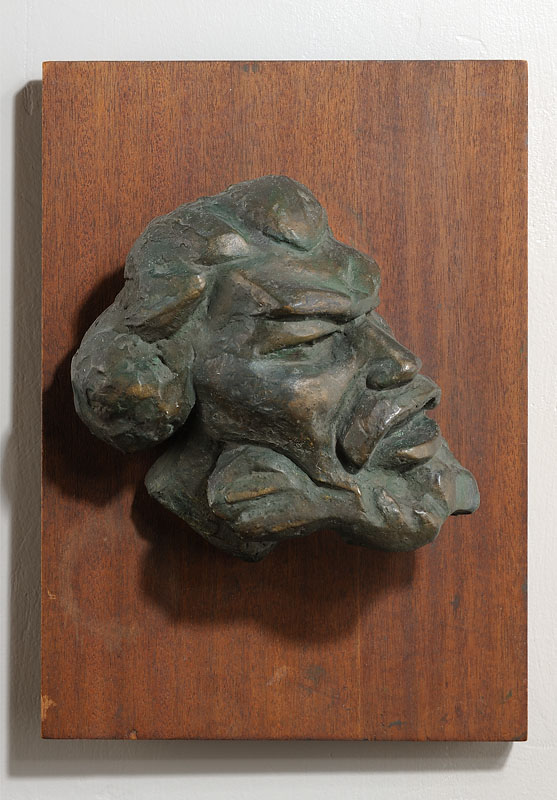
John Brown
Painted plaster relief
8x8x4 1/2 inches
1935
Photo credit: John Wilson White Studio
New Gallery















